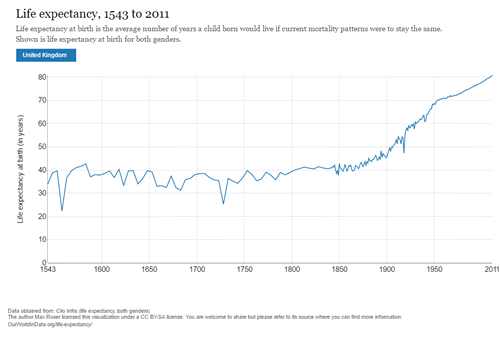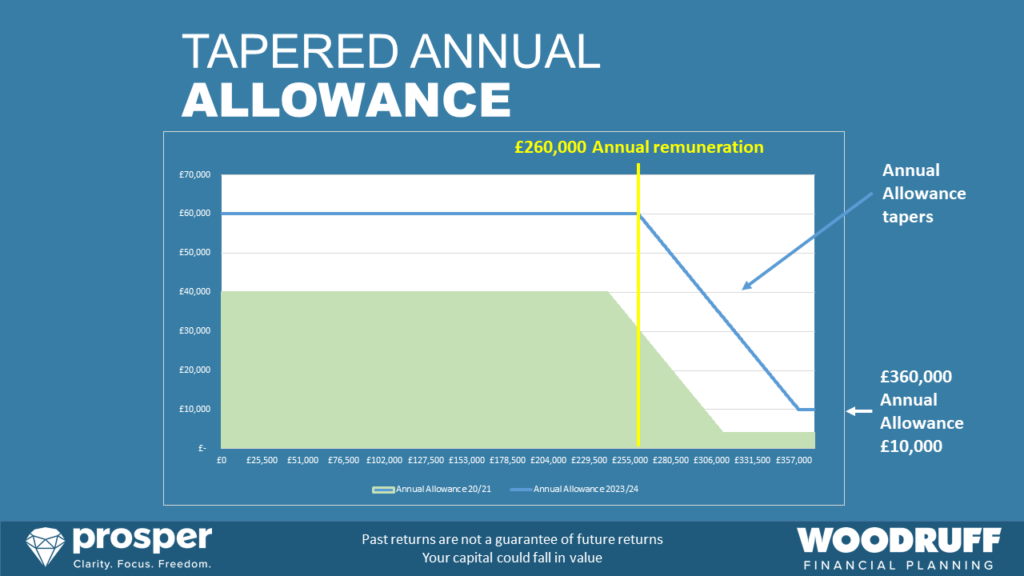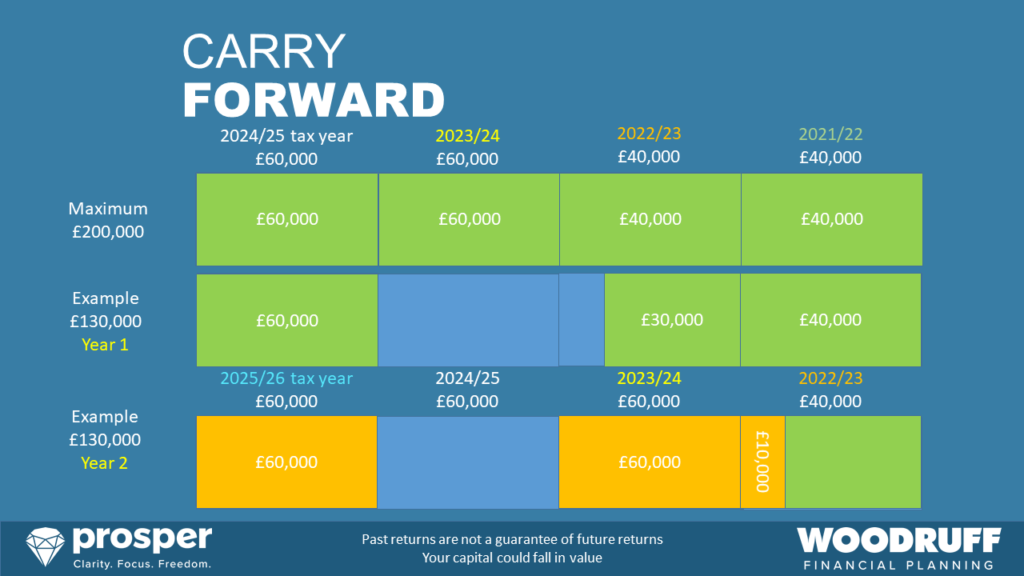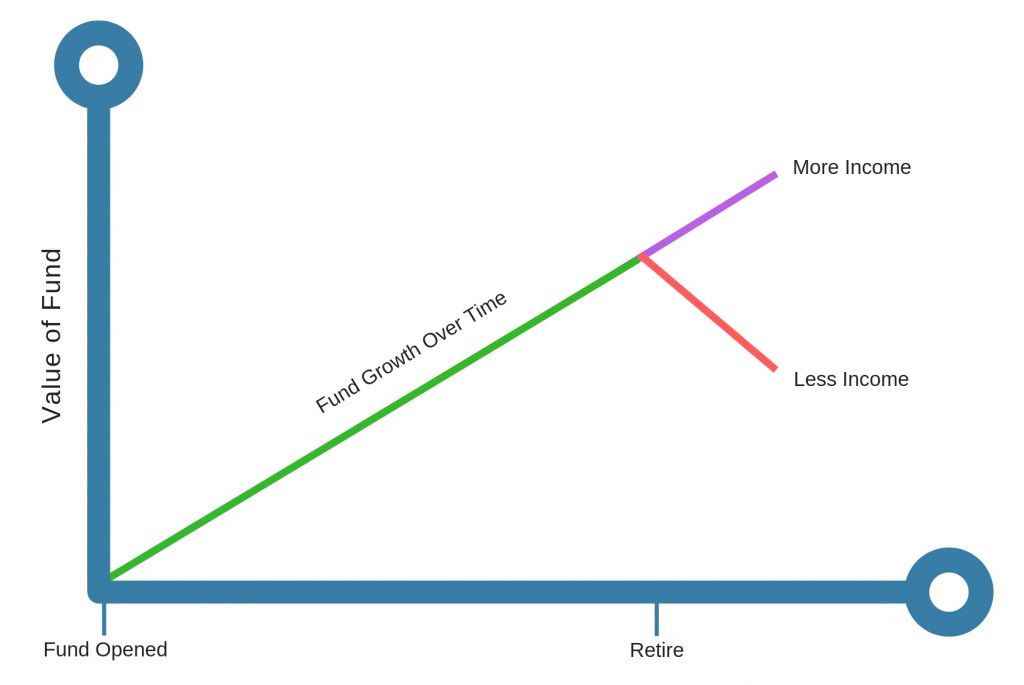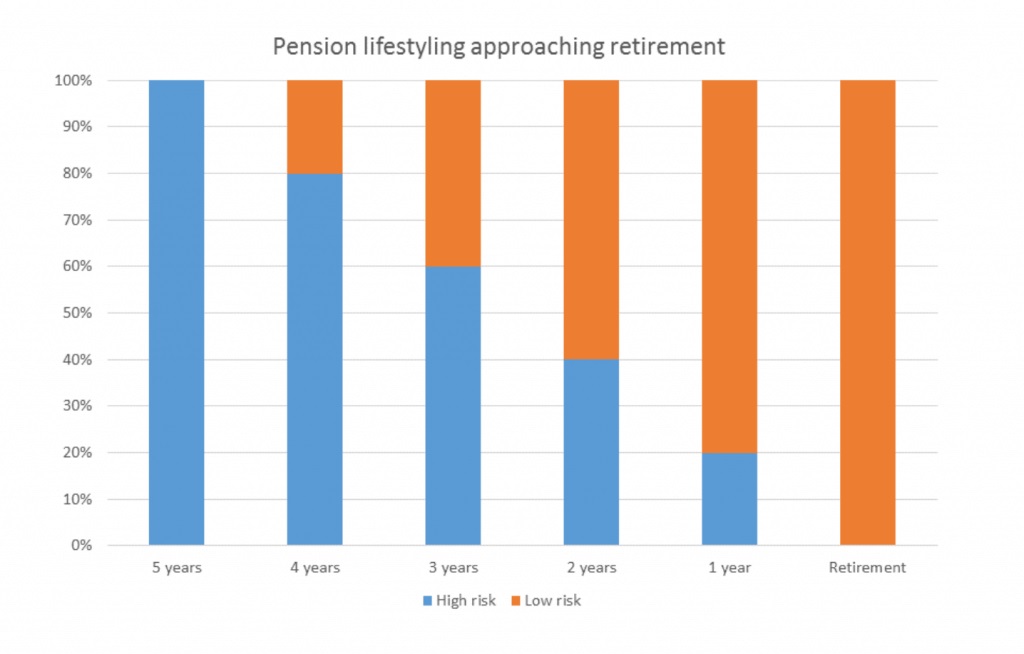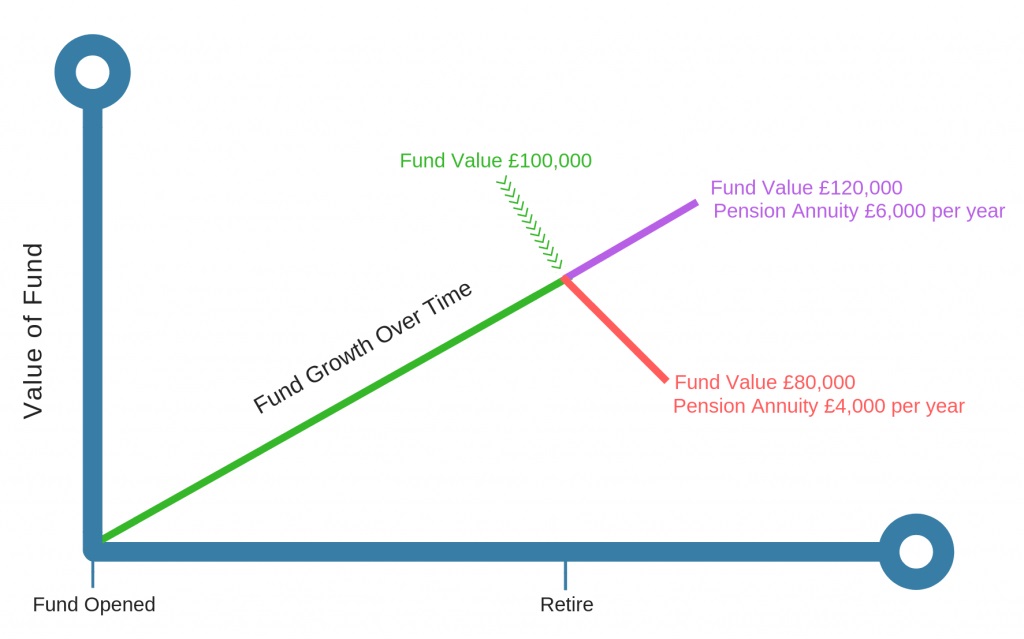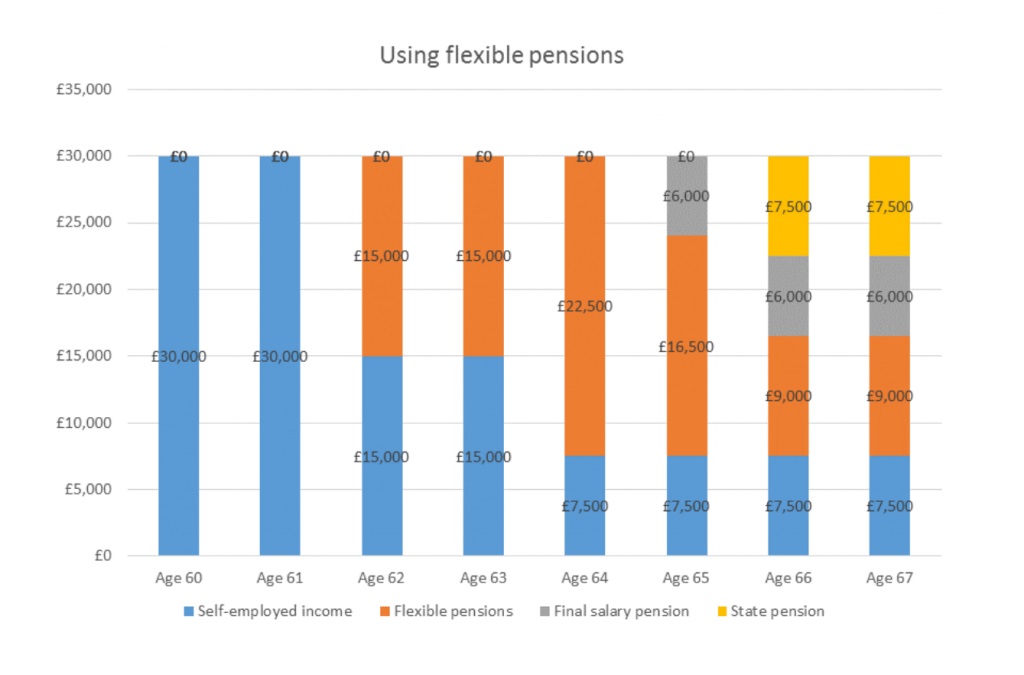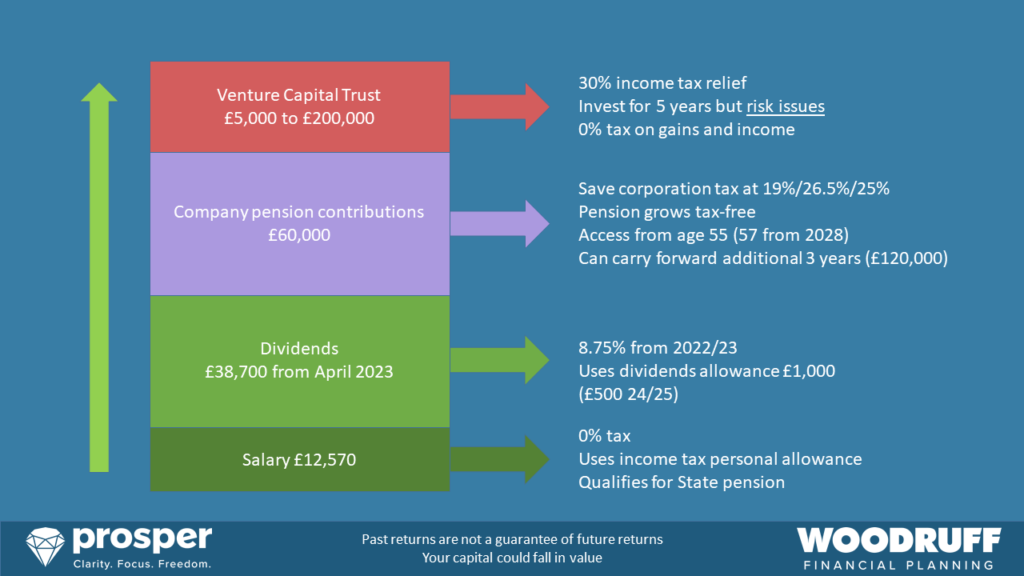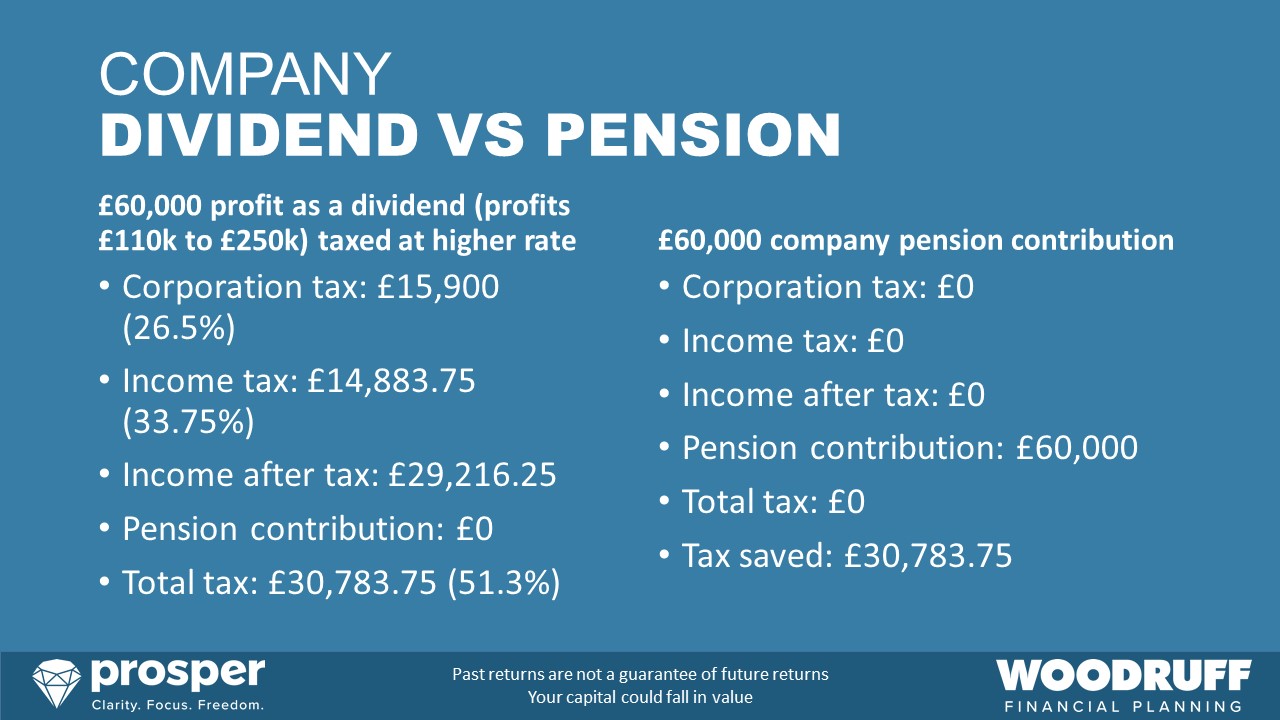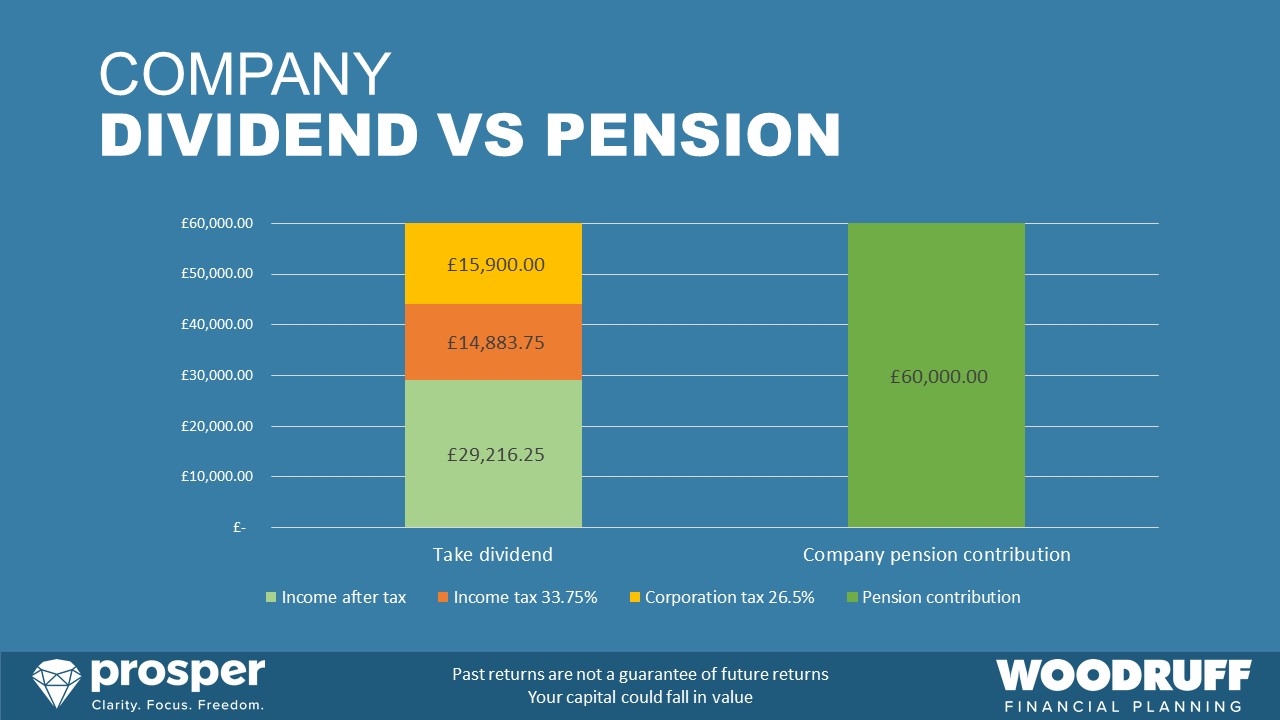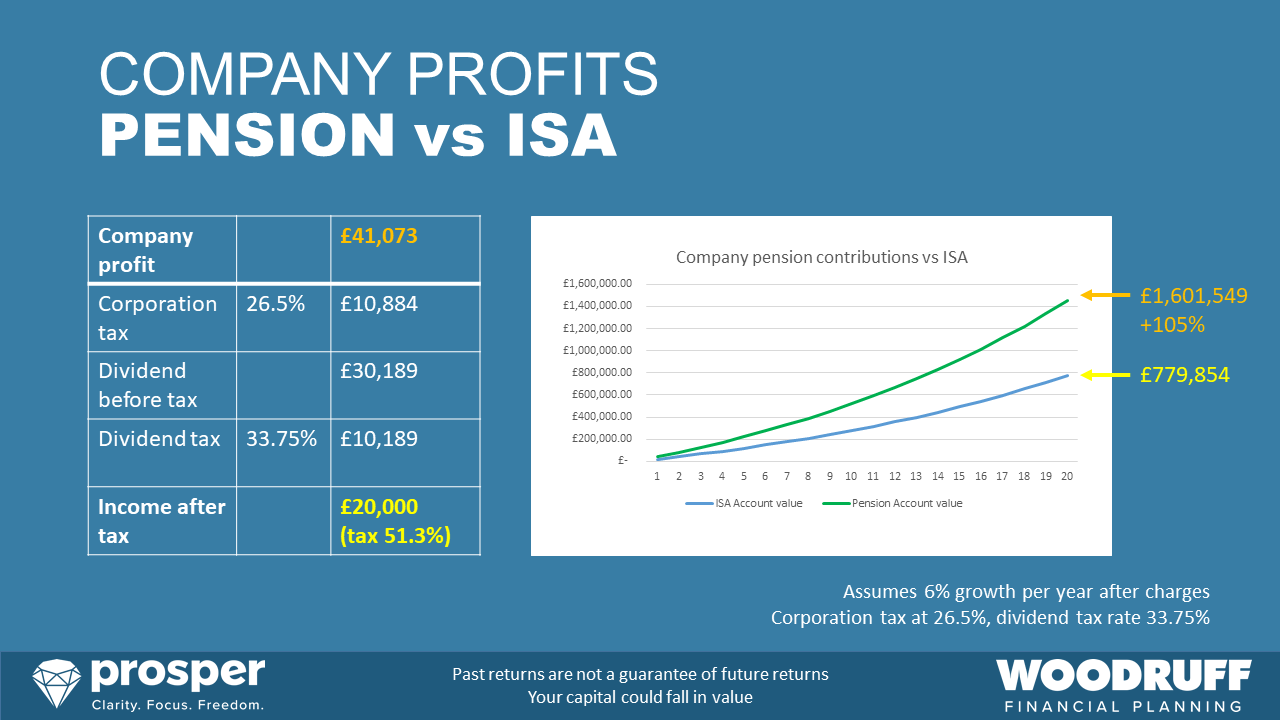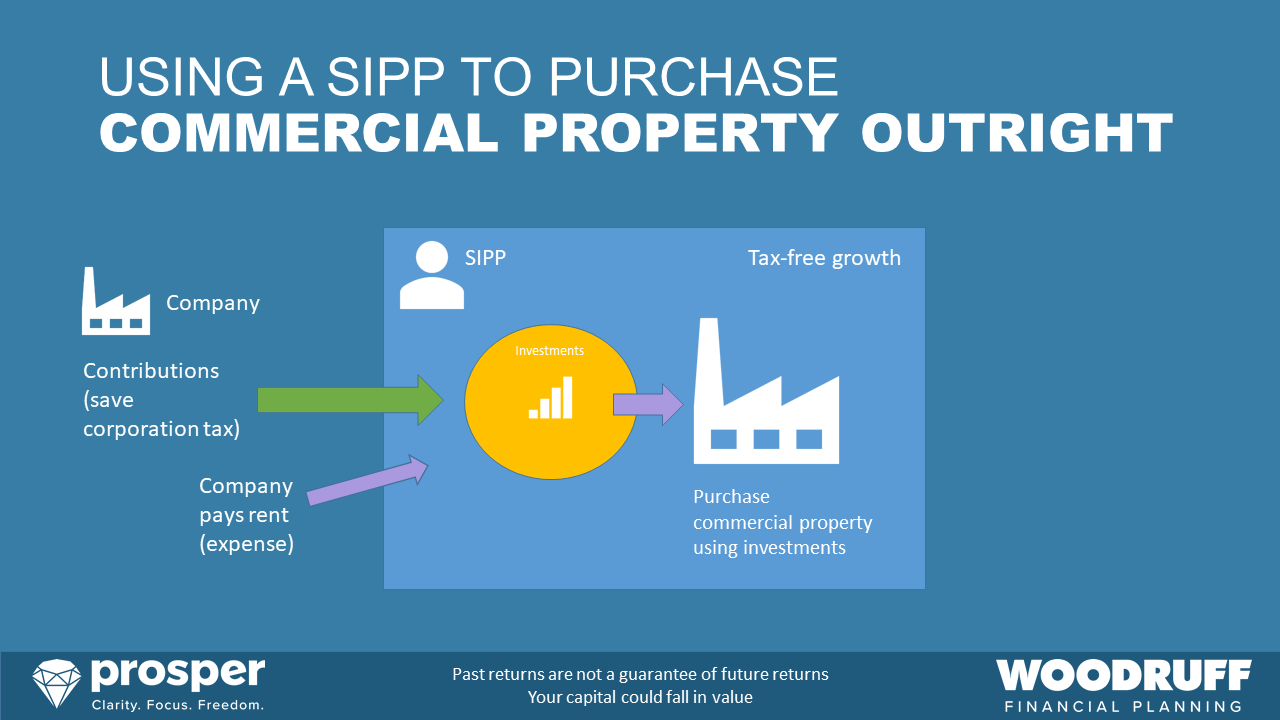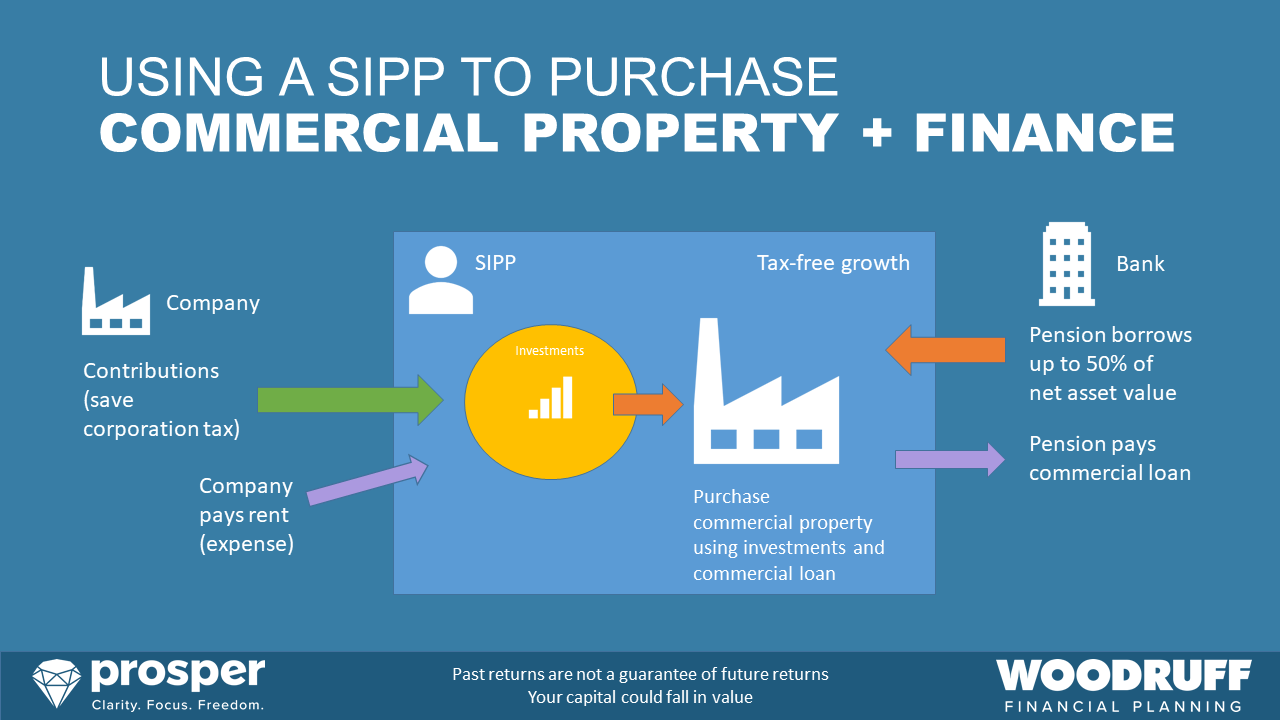Planning your retirement guide
This article explores all the issues you need to examine when planning for retirement. We aim to show you what you need to consider when planning for retirement so that you know you can afford to retire, without ever running out of money. You should read this if you are planning for your retirement but do not know if you can afford to stop working.
Who should read this Planning your Retirement Guide?
This information should be useful to you if you are planning retirement, even if this is many years away. If you are ready to retire, the information below will help you to decide if you can take the next step.
We also consider tricky technical details that you need to understand, so that you can make the most of the retirement tax rules available to you. This is particularly valuable if you are a business owner or have a high income.
- Planning your retirement
- Preparing to retire soon
- Tax-efficient pension savings
- Flexible pension income
- Pensions for business owners
- Tax issues for high earners
Key topics covered in this article
Click on the links in this table to go straight to that section of the Planning your Retirement Guide:

Planning your retirement – an overview
Before you start planning your retirement, you must first begin to consider what retirement means to you. This section of the Planning your Retirement Guide explores how to prepare for retirement the right way.
What is retirement?
Stopping work
For most people planning retirement, this means stopping work, and starting to do what you want to with your time.
Of course, your retirement will be individual to you and your circumstances. For many people your retirement is a positive experience where you get to regain your freedom. Of course, having enough money is vitally important when planning your retirement.
You do not have to stop work suddenly. With proper retirement planning you can gradually retire, possibly working part-time until you are ready to stop work completely.
“Retiring” from life
Another sense of retirement it is to withdraw from life. Younger people often view retirement negatively, seeing it as a withdrawal from work and other social activities. In fact, retirement is usually the opposite, provided you get your planning right. In our experience, provided you have done your planning, retirement can be a stage where you fulfill your dreams.
The ideal retirement?
We see retirement as having the resources to do things on your terms. If you have enough capital or income to be able to fund your lifestyle, then you can afford to stop working on your terms. If you continue working, you will only do so if it meets your needs, when you decide.
The ideal retirement is one where you have the freedom to meet your goals, and the financial resources to back this up. If you have financial stability you can focus on your lifestyle, relationships, health, and interests.
Planning retirement ultimately comes down to 2 factors:
- What will you do with your time?
- How will you pay for it?
Action:
- Take some time to seriously think about what retirement means to you.
- When planning retirement you should be thinking ahead to what life will be like after you stop working.
What will retirement be like?
Ask yourself what retirement means to you?
The answers to the questions below might help you to plan whether you are ready for retirement.
Rank yourself along the scales below. The further towards the right, the more positive you are likely to feel when planning retirement.
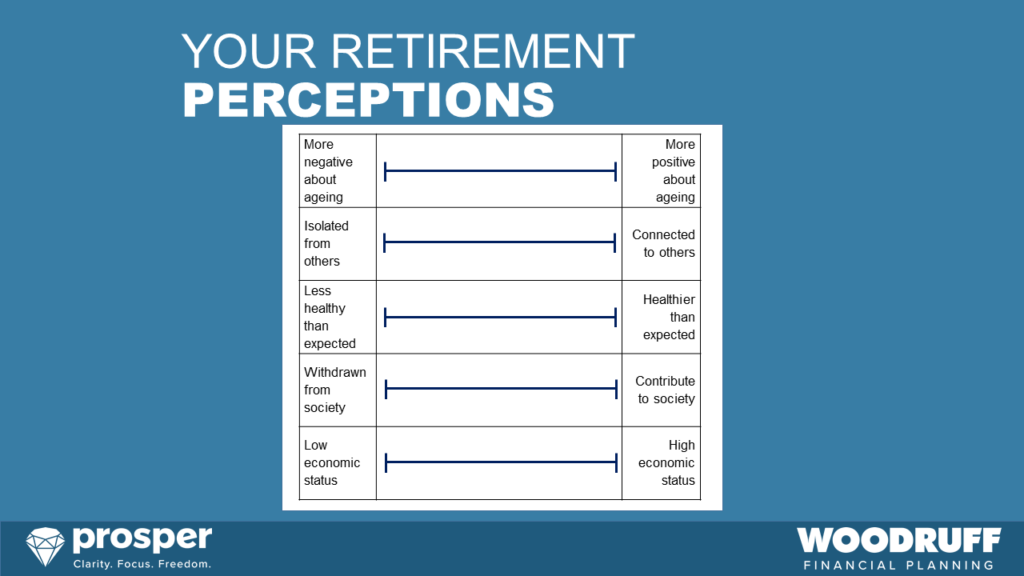
Our goal when planning your retirement is to aim towards the right of the scales set out above. The better you rank yourself against these measures, the more fulfilled your retirement is likely to be. Of course, you cannot control these areas fully, but you can do your best retirement planning to ensure the chances of success in these areas are greater.
A US academic study from 2016 found that those people with a more positive self-perception of aging lived on average 7.5 years longer than those with less positive self-perceptions of aging. When planning your retirement, the more positive you can be about the changes to your life, the better your chances for a longer life.
Planning your retirement – what will you do with your time?
One of the great benefits of planning your retirement is that you will get so much more free time. After all, if you no longer work, or work less, then more of your time will be yours. Of course, this works positively and negatively. You will move from a set routine into something less formalised. The danger of not planning your retirement is that you might allow your life to drift due to all the new-found free time.
A simple exercise could be to examine how you spending your time before retirement, to how you might spend it after retirement.
How you spend your time now
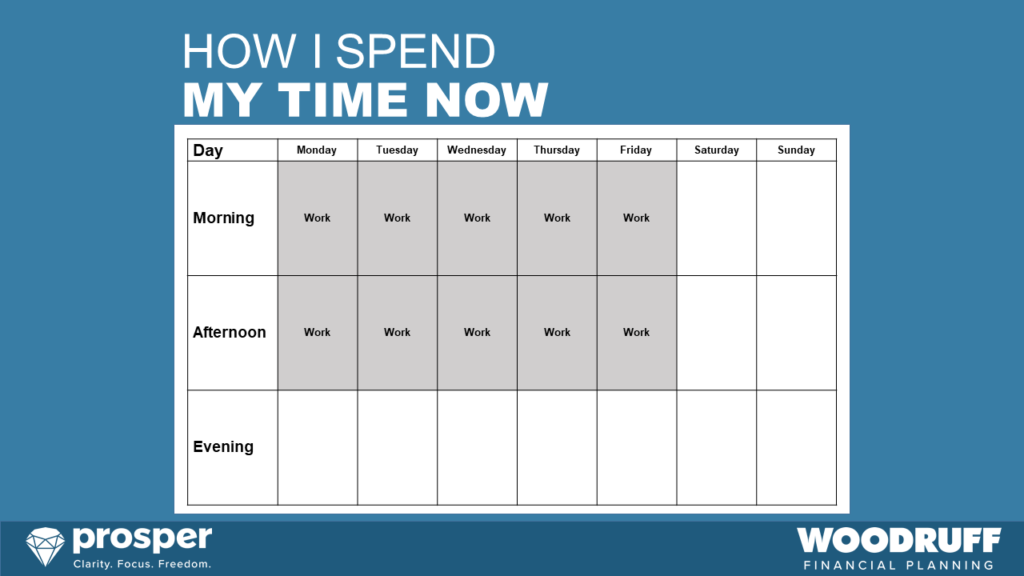
This simple table shows the straightforward routine of standard full-time employment. Of course, your work routine may look different to this. You are used to following the routine of your work, and then filling in the blank areas with your interests, and family commitments.
Your time after planning your retirement
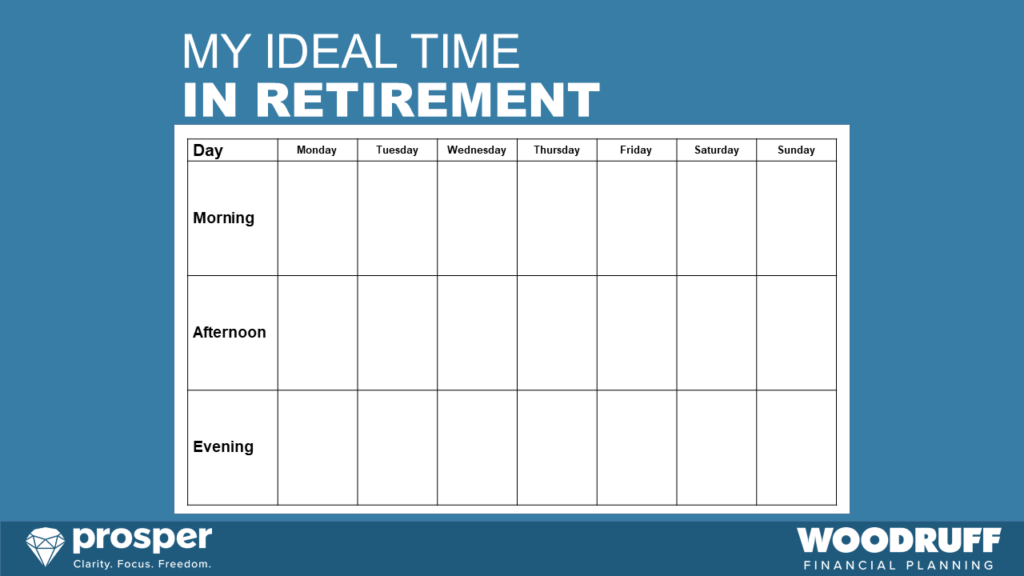
When planning your retirement your goal is not to replace work with other commitments, but if you complete this exercise you might fill in the above chart with your future plans for hobbies, socialising, visiting family and other activities. One of the dangers of an unplanned retirement is that you become a magnet for others to fill your time. You might end up swapping the commitment and routine of paid work for unpaid commitments like child care, or volunteering. Of course, there is nothing inherently wrong with making such commitments when planning your retirement. However, we believe that you should only make such commitments in retirement on your terms.
Planning your retirement lifestyle
Various studies show the effects of various lifestyle choices during retirement. When planning retirement take care to be intentional about this, as the choices you make will have a bearing on the type of life you lead.
Physical exercise in retirement
The link between physical exercise and health is well-known, so it makes sense to apply this to your retirement plan. Various studies have linked this to better health in retirement. This study suggests that regular physical activity is associated with an increase of life expectancy by up to 6.9 years. If you can keep yourself relatively fit in your retirement, then not only will you live longer, but you are more likely to enjoy your retirement years.
Keeping your brain active in retirement
This study points to a survival example of reading every day, compared to other materials such as magazines. The general point is that if you keep using your brain, and solving problems, you are more likely to avoid the negative effects of aging on the brain.
Action:
- Consider your attitudes towards retirement – are you positive or negative about these issues?
- Establish an idea of how you will change your routine in retirement
Life expectancy in retirement
How long you will live is a difficult question to answer when planning your retirement, but it is an important consideration even if it might be difficult to face. After all, we know that we are going to die one day, and our health might deteriorate before that event. Therefore, your task when planning your retirement is to focus realistically on this issue so that you can maximise the time you have while you are fit and healthy to enjoy retirement.
Life expectancy data
Life expectancy data is extremely important when planning your retirement. Essentially, the longer your lifetime then the more money you will need to fund your retirement expenses, especially if you plan to stop work or retire on a fixed income.
Make the most of your retirement
You should make the most of the time you have left, while you are still fit and able to do so. It is all too easy to ignore the future and worry about these issues later, even when planning retirement.
Life expectancy is lengthening
You may live a much longer life in retirement than you imagine. You cannot simply take a look at the lifespan of your parents or grandparents. We are all different, and medical advances are gradually increasing life expectancy. The advances in DNA mapping and data capacity should lead to a golden age for medical progress as scientists and doctors trace the causes of all illnesses. I expect this to lengthen everyone’s life expectancy in retirement, potentially at a much greater rate.
Prepare realistically for your future
Planning your retirement can help you to think about what resources you need to put aside to provide you with security for your future and a lifestyle worth living. Remember that longer life could mean coping with serious illness for a longer period.
How long will you live? Your life expectancy and longevity as a timeline
Take a look at this timeline, which illustrates the point about life expectancy when planning retirement.
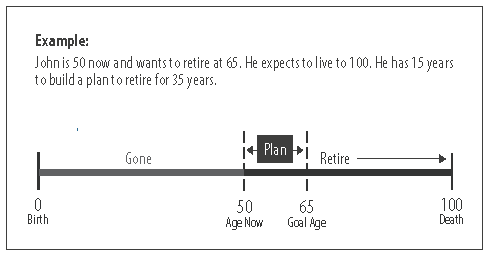
If you expect to live a long life then you need to work harder prior to retirement to provide the resources to fund for a secure and worthwhile future. Of course, if you expect to live a shorter lifetime then your retirement planning can assume you need lower capital.
We can apply this to retirement planning. You may think that you do not want to live to an advanced age, but that reality is more likely than you might think. And when you get there, the likelihood is that you may wish that you had prepared for a long lifespan.
Historical UK life expectancy data
The average life expectancy has been rising gradually, since 1850. Much of this is due to improvements over infant mortality, but medical advances now mean that the average retirement length has increased dramatically. Your retirement plan needs to consider this issue.
If you were born in an earlier age, your life would have been much shorter than today, and therefore your retirement would have also been shorter. The data above clearly shows that the average life expectancy in the UK was pretty low throughout the past 500 years. This was due to disease, famine, nutrition, medicine and war. Clearly, some people lived longer lives, but many died much younger. You can see a huge increase in UK life expectancy from the 19th Century as medical advances reduced disease.
Retirement planning: how to predict your life expectancy
The easiest way to predict life expectancy when planning your retirement is to use the statistical evidence. This can show you how long you will live based on the average. Of course, no-one is average, and your own retirement life expectancy will be determined by a variety of factors – genes, work history, exercise, food etc.
The statistics can lead to a certain complacency, or negativity, about your retirement life expectancy. For example, if the average life expectancy for someone at birth in the UK is now 86, you might use this figure in your Financial Planning. The reality is that this is the average figure. Half of the population will live longer than age 86.
UK average life expectancy data
Here is a summary of life expectancy data from the Office For National Statistics.

How to read this data
This table shows results based on age now for men and women. If you examine the top row you will see that a child born today should expect to live an average lifespan of 88 for a boy, or 90 for a girl. That is the average, meaning half the children born today should expect to live longer.
The next 2 columns show that the same child has a 1 in 4 chance of living to 97 (boy) or 99 (girl). They have a 1 in 10 chance of living to 101 (boy) or 102 (girl). A new-born baby today has a 14% chance of living to 100 if it is a boy, or a 18% chance if it is a girl.
You can select the entry closest to your age on the left.
For example, if you are currently aged 60 your average life expectancy is 85 for a man, and 87 for a woman. A man who is currently aged 60 has a 1 in 4 chance of reaching age 92, and a 1 in 10 chance if reaching age 97. A woman who is currently aged 60 has a 1 in 4 chance of reaching age 94, and a 1 in 10 chance if reaching age 98.
You can get your own results using the Office For National Statistics life expectancy calculator.
Bear in mind that this data is for the whole population. It does not take into account other factors such as income, wealth, health and occupation.
The effect of health on life expectancy
Your retirement health will also have a major impact on your lifestyle. As we get older, we are more likely to have to deal with significant health issues. We believe you should look after your health where possible. This means taking regular exercise and eating well. However, we do need to face the fact that we are likely to have to deal with health issues in retirement. Therefore, why not maximise your opportunities while you are fit and able to do so?
Action:
- Consider how long you expect to live based on the data above – this will influence the amount of time your retirement money needs to last
The value of work when planning your retirement
No doubt you are planning your retirement partly because you want to stop working, or at least reduce your time in paid work. However, there is a value to work, not only in the financial sense, but also in the other benefits work brings.
Economic benefits of working
The economic benefits of working are obvious – you get a regular income. However, this can come with downsides, especially if you are self-employed.
Economic benefits of retirement
There are also costs of working that might reduce after retirement – for example commuting costs. In addition, if your retirement income reduces, so too will the effect of income tax.
Lifestyle benefits of working
The lifestyle benefits of working are important, but harder to quantify. For example, working brings a routine, which you might lose in retirement. There are social benefits to working from seeking a challenge, to meeting people, and solving important problems.
Lifestyle benefits of retirement
In retirement, you will gain more free time on your own terms. However, you may lose some important social aspects unless you replace your work with something else.
Action:
- Take some time to consider the relative advantages and disadvantages of working against the same issues if you retire. This will help you to establish whether retirement is important to you now, or perhaps can be delayed. Many people consider retirement not because they want to stop working; often the real reason is that they hate their job!

How will you pay for your retirement lifestyle?
On a practical note this guide to planning your retirement aims to answer this question. You must prepare ahead of your retirement for your expected budget, and then put together a plan for how you are going to pay to live in retirement. This section of the Planning your Retirement Guide considers what elements are important to paying for your retirement lifestyle.
When will you retire?
The date you plan to retire is very important. The earlier you retire, the less time you have to prepare for living from your resources, and the more you need to save to live off once your earned income ceases. The later you retire, the more time you have to build up reserves, but this will reduce the time you have to do what you want.
The decision of when to retire is important and should be taken carefully, since this can be irreversible if you leave your job.
Action:
- Think about when you want to stop working. Having an end date will help you to focus your attention and resources. If you conclude that you’re not ready to retire, that’s also fine.
Will you fully retire, or partially retire?
Traditionally, retirement meant ceasing work completely – that’s what the word means. Today, you have much more freedom to retire on your terms. You do not have to retire all at once, and you can plan your retirement in stages.
Actually, the decision to retire can be daunting. In many cases, you can ease yourself into retirement by partially retiring (also known as semi-retirement). That way you can see whether retirement agrees with you. Planning your retirement can take account of many options.
Taking retirement benefits gradually
Many people have a variety of retirement products and assets available to them. This could be personal pensions, defined benefits pensions, the state pension, investments or property (many other options exist). Some of these assets may have set dates for when the retirement income payments begin. Others give you more choice. This means that you need to plan when your income is to to start, and how it will be paid. The results can influence your decisions.
Example of taking retirement benefits gradually
Anita is aged 59. She has 3 retirement income sources:
- the state pension, which begins at her age 67
- A final salary pension, which begins at age 60 (some schemes allow you to change the start date)
- A personal pension which was set up to start retirement income at age 65, but in practice could begin income at any stage from age 55.
If Anita takes her retirement income based on these dates, her income pattern will change. This could influence her decision whether to continue working in her current employment.
Working less
Many people take the view that work is not the problem, but they want to work on their own terms as they approach retirement. You can partially retire, perhaps working fewer hours if you are employed, or taking on fewer clients if you are self-employed or a consultant.
Many employers are flexible with experienced employees, and might consider offering you a proportionate decrease in hours and salary. Self-employed workers can decide to take on fewer projects or clients, or wind down their client bank, so that they do not replace clients over time.
Example of working less
Anita works for a bank, which has flexible working practices. She has the same retirement plans as listed above. When she reaches age 60 she realises that her final salary pension will provide approximately 30% of her current salary. She decides that she can reduce her hours with her employer by 2 days a week, making up the difference using her final salary pension from age 60, and some other savings. Her initial plan is to see how this change works, and then possibly access her personal pension in a few years.
Taking a different job
Many people work in stressful roles. As they approach retirement they many want to take a less stressful role, or one with less responsibility. One option can be to take a part-time job. This may pay you less than your full-time employment, but you might be able to plan your retirement income around this new job.
Example of taking a new job
Anita’s role is a senior manager in the bank, which is based in London. She has commuted to work for many years, and now wants to take role closer to home. She finds a role nearer to home, which pays much less, but will mean reduced travelling to work. She knows that her final salary scheme will top up this income, and she can also plan to access her personal pension before her state pension begins at age 67. In addition, her new, lower-paid job will attract less income tax, which could be a factor in her decision.
Action:
- Consider your options for income sources in retirement. Could you take some income from non-work assets (such as pensions), reduce your hours, or change jobs?
Planning your retirement budget
When planning your retirement the obvious first step is to take a close look at how your finances will change once you stop working.
From a purely practical standpoint you need to be sure that you will have enough money to be able to fund the retirement you want. Of course, you want to be sure that you will never run out of money.
How your retirement income may change
Possibly the biggest change you may notice when planning retirement is that you will move from a stable monthly income to something different. You are likely to receive some guaranteed income, some regular income, and some variable income. This depends on the sources of your retirement income.
This change can be unsettling, as you may not feel as secure as you might have been when working. You will need to put in place a plan to ensure that your retirement income can continue no matter what happens. Financial Planning in retirement will focus on the sources of income, and their possible effects in difficult periods.
Sources of retirement income
We explore the technical details of many of these retirement income sources in the section below.
- State pension
The state pension is a guaranteed source of income in retirement. Most people in the UK will qualify for the state pension, but not necessarily the full state pension. - Company pension
If you have worked for an employer then you may have built up a company pension fund, which you could use to provide retirement income. - Defined benefits pension
Many employers provided defined benefits pensions in the past (less so today). This is a guaranteed source of future retirement income. - Personal pension
A personal pension is a way for you to save for your retirement income. This will provide you with a fund that can be converted into income in retirement. This is a type of defined contributions pension. - Retirement annuities
Retirement annuities are used to convert retirement funds into guaranteed income for life. - Flexible pensions
You can use flexible pension rules to dip into your pension funds to provide flexible income. This can be more tax-efficient, and vary to your needs as they change. - Other investments
Retirement income could come from investments such as shares, or other investment accounts. - ISAs
ISAs can be used to provide tax-free retirement income. - Property
Property may be useful in retirement to provide you with a stable income, although this does come with other complications when managing the asset. - Working
You are allowed to continue working in retirement, even if it is for a short period, or part-time. - Inheritance
You may receive an inheritance in retirement, possibly from an elderly relative. This could be used to top up your retirement income. It can be difficult to predict if you will receive an inheritance, or when it might come to you.
How will your expenses change in retirement?
When you retire your expenses are likely to change in a number of areas. You can plan this to help you to establish whether you can afford to retire.
A starting point should be to examine your existing household budget. You can examine which expenses will change, which will cease, and whether new expenses will be required. Retirement does not have to mean living on less money. However, retirees often find that they need less to live than the needed at other stages of their lives.
Retirement expenses that may increase
- Leisure
If you have more time, it is reasonable that you will spend more on leisure activities. This could be hobbies, socialising, sport, meals out etc. - Utilities
Many retirees spend more time at home than when they were working. This inevitably means higher heating bills. In the past, the cost of heating your home has risen at a rate faster than inflation. - Health
If you experience declining health in later years you may find that you have increased expenses for health-related activities – prescriptions, treatments etc.
Retirement expenses that may reduce
- Travel to work
Less travel to work can mean a significant reduction in expenses related to this activity. - Car expenses
Some retires are able to move from having 2 cars to 1 car. This saves the running costs of the second car. - Income tax
If you earn less money, you pay less income tax. Income tax is a large proportion of many workers’ expenses, especially if you are a high earner. - Housing costs
Many retirees are able to buy their home before they retire. Therefore, if you have no mortgage you can plan for no ongoing expenses in this regard. Of course, other housing costs are likely to continue – rent, maintenance, council tax etc. - Children
Most people who retire find that children are no longer living with them, so generally these associated costs tend to cease.
New retirement expenses
- Leisure
You may plan to take up new activities, or memberships. This can increase your expenses. - Holidays
If you have more time you may decide to take additional holidays, which of course can cost more money.
Action:
- Prepare 2 budgets – the first should be your income and expenses for your existing situation. The second should be your expectation of income and expenses once you make your planned retirement changes. This will help you to understand if you expect to be on track to retire when you want to.
- Think about whether your likely retirement income is guaranteed, secure, or flexible.
- Consider what expenses are necessary, such as food or utilities, versus those that are desirable such as holidays or socialising.

Avoiding disaster in retirement
You can do a lot of planning for your retirement, and you may come up with a new expenditure budget, which appears to be funded by your future sources of income. However, life tends to change over time, so it helps to take account of what could go wrong in retirement.
Of course, it is difficult to predict the future, so your assumptions will probably not be correct. Therefore, it makes sense to build in some additional buffer to cope with some of these possible retirement issues.
You should regularly review your retirement plans to make sure they are still on track.
Changing health in retirement
You may have to deal with health issues in retirement. This is a difficult area for your retirement planning, but many people are concerned about the impact of their health in later life.
We have already established that the average retirement period is longer than in the past, because we are living longer on average This is relevant, but does not answer the question of whether you will need additional medical treatment or nursing care in your retirement.
Disability-free life expectancy
It is possible to estimate on average how long you might live in retirement before you have to deal with a disability. The latest data from the Office for National Statistics suggests that for those already aged 65:
- men can expect 10.5 years disability-free;
- women can expect 11.2 years disability-free.
This means:
- the average man in the UK can expect to be free of disability to age 75;
- the average woman in the UK can expect to be free of disability to age 76.
Of course, you are not average, so your own retirement circumstances will be individual to you.
Therefore, on average in the UK:
- Men live to age 84, and develop their first disability at age 75, meaning they live with a disability for 9 years
- Women live to age 86, and develop their first disability at age 76, meaning they live with a disability for 10 years
Clearly, it is within this period of disability that you may require nursing care in your retirement.
How likely are you to need nursing care in retirement?
The ONS estimates that, based on the 2011 census, the portion of the UK population aged over 65 grew by 11% between 2001 and 2011. Despite this, the numbers in care homes only rose by 0.3% in this period.
The study estimates that in 2011 3.2% of the over 65 population were receiving nursing care in a care home.
Breakdown of the over 65 population in care homes (ONS)
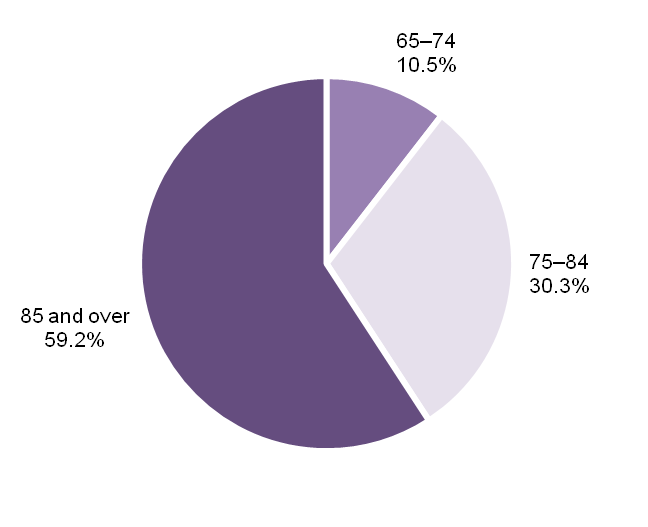
Of those in a care home, 214,000 were women, and 77,000 were men. Therefore women appear to be nearly 3 times more likely to require nursing care in a residential home than men. Most care residents are single, suggesting that having a partner enables you to put off needing to pay for nursing care.
Of course, many more people receive nursing care within their own home. The ONS estimates that 600,000 people were unpaid carers (up to 5.8% of the population aged over age 65), suggesting that care is often provided in the home first, and people move into care homes only when their needs become too acute, or they no longer have a partner able to provide nursing care.
Overall, it seems that 9% of the over 65 UK population was receiving nursing care either in their own home from a relative, or in a residential nursing home.
You can read more about nursing care here.
Planning for health changes in retirement
Given the data above, it can be difficult to plan for nursing care costs in retirement. When we produce retirement plans, we assess this situation from the worst possible position, just to test whether your retirement plans could cope. The difficulty is knowing whether you are likely to require nursing care in retirement, when it might happen, for how long, and what the cost would be. There are so many variables here that it can be difficult to plan.
The UK Government announced an improvement to the care arrangements for England and Wales in 2021. This has yet to be finalised, but the change to the regulations means that the maximum you should be expected to pay for nursing care is £84,000. Unfortunately, there is little detail on limits to the cost of food and accommodation will be limited, if at all.
- Plan for reasonable increases to health expenditure
You might make a sensible allowance for increased retirement health expenses, perhaps form age 75 onwards. This could allow for additional health-related costs such as medical prescriptions and treatments. - Plan for the worst-case scenario
The worst-case scenario might be where one partner requires nursing care in retirement, while the other has to maintain their family home. This would involve paying significant care costs, and the usual costs of running a home. If you are single the position is less severe – if you end up living in a nursing home you could sell your house to pay for care.
Action:
- Estimate the effect of deteriorating health based on your personal health history.
- Estimate the costs of future care in your home if you become less active.
- Estimate the cost of nursing care for the worst-case scenario.
Death of a partner in retirement
Unfortunately, you also need to consider the effect of death of you or your partner on your retirement plans. When a partner dies 3 major issues affect the retirement planning:
Reduced expenses
It is reasonable to assume that some expenses will continue after one partner dies. However, some expenses will change. For example, after a partner dies there will be a reduction in the budget for food and clothes.
Movement of assets
Usually, when a partner dies their will dictates how assets are distributed. This can have important effects on the surviving partner, which are sometimes positive but often negative. For example, certain assets might pass automatically to the partner. Other assets might pass to other family members.
- Property
It is common for property to be held as a joint tenancy. This means that the surviving joint owner automatically takes ownership of the portion of the deceased person’s share after their death. Sometimes a person may gift their share of a property in their will (using a tenancy in common). This might take place if your partner has children from a previous relationship. - Cash and investments
These assets typically pass according to the instructions of the deceased person’s will. You should check the provisions of their will as the survivor may have less value in assets than they might think. Special rules exist for ISAs to pass to surviving spouses. - Pension plans
Pension plans usually pass outside of the will, and this can mean that the surviving partner does not receive all the retirement benefits that their deceased partner would have received. For example, older pension plans may pay out a tax-free lump sum to the surviving partner, (if they have been nominated to receive these benefits). Newer pension plans allow for the survivor to continue with the pension plan without having to take a lump sum.
Loss or reduction of income
It is common for a surviving partner to experience lower income than they received prior to the death of their partner. This may not be an issue if expenses also reduce. However, in some cases the death of a partner can have significant implications, especially if one partner has greater retirement income than the other.
- State pension
The state pension pays to individuals, so if your partner dies, the income will usually fall – their state pension will not be paid after they die. - Pensions not in payment
Some defined benefits schemes pay death benefits that do not match the guaranteed income you would expect after retirement. Other schemes typically pay the fund to whoever you nominate. Not every scheme pays death benefits in the way you might expect. If you are not married, some defined benefits pensions may not pay anything to the surviving partner. - Pensions in payment
For guaranteed income such as defined benefits schemes, or retirement annuities, the death of the pensioner usually has an impact on their surviving partner. It is common for retirement benefits to continue after the death of a partner, but often only to a spouse; in almost every situation after the death of a partner, the income from the pension plan will reduce. You may receive reduced death benefits from a retirement annuity after the death of a partner, but only if these were built into the contract when it was set up. If you have flexible pensions, then the remaining fund is likely to pass to whoever was nominated. - Earned income
In most situations, this is likely to stop after the partner dies - Investment income
This may continue after a partner dies provided that the asset passes to the survivor.
Action:
- Prepare an outline budget for after a partner dies
- Examine the wills of both partners
- If you do not have a will consider getting one written. If you die without a will your assets may not pass to who you want them to.
- Consider which assets pass to the surviving partner, and which move elsewhere after death. You can also think ahead about options that exist in this situation.
- Assess whether who you have nominated to receive pension benefits and other assets like life assurance.
- Check the death benefits of all pension plans
- Make sure you understand the nominations made for death benefits and change these if appropriate
Running out of money in retirement
When you are planning your retirement, you should think carefully about how long your money will last, especially if you plan to use flexible pensions, or drawdown to access your capital.
Your retirement goal should be to ensure that your money lasts at least as long as you live. You can achieve this by using the concept of the Safe Withdrawal Rate. This allows you to calculate how much you can afford to withdraw from your pensions (and other retirement savings) before your capital is exhausted.
What is the Safe Withdrawal Rate in retirement?
The Safe Withdrawal Rate is the calculation of how much you can afford to spend from your retirement savings before you run out of money. This allows you to work out the amount of income that you can take, based on a variety of factors. Bear in mind that this calculation may change over time, so you need to review your progress.
Why is the Safe Withdrawal Rate important?
When you retire, you will need to generate an income to fund your expenses, especially if you are no longer working. This retirement income may come from a variety of sources:
- Pension savings
- Defined benefits pensions
- State pension
- Investments or savings
- Property
- Working income
Some of these income sources may be guaranteed, and therefore would continue regardless. The State pension or a defined benefits pension would be an example of guaranteed income.
However, if you have savings in pensions, or other accounts, then you have 2 main choices for this retirement income:
Guaranteed income
Traditionally, pension savings would be converted to a retirement annuity. This is a guaranteed income for life, and is still appropriate for many people who want certainty for all or some of their retirement income. If you want certainty with your income then this product is appropriate for you, and you would not need to use the Safe Withdrawal Rate, since the future income would not be able to be changed.
Stable income
Some income sources are relatively stable, but do not have a guarantee. This might include rental income from property. You can generally rely on this income in retirement, but occasionally a crisis will mean your income reduces or ceases.
Flexible income
It is common to use flexible pensions for retirement income, especially in the earlier years of retirement. This allows you to access your retirement savings when it suits you, and to alter the amount you take as your circumstances change. The downside is that you need to manage the income taken carefully – hence the need for the Safe Withdrawal Rate calculation.
Combining guaranteed and flexible income – an ideal retirement?
In many ways, a stable retirement can be achieved with a combination of guaranteed income and flexible income. Imagine that your standard expenses (such as food and utilities) are £25,000, and your discretionary expenses (such as holidays and leisure) are £10,000. If your guaranteed income covers the basics, then the variable income may be under less pressure as you could continue to live even if these sources of income were to reduce.
Factors that influence the Safe Withdrawal Rate
The Safe Withdrawal Rate concept requires you to make assumptions about the future that may not prove to be true. That is why you should regularly review your retirement income, based on the reality of your life, and how it is changing.
How much retirement income do you actually need?
Before you start your Safe Withdrawal Rate calculations, you should consider carefully how much retirement income you actually need. A variety of factors will influence this decision. Think about how your life will change after retirement, and what your expenses will be. Certain spending will reduce, but other areas may increase.
The amount of retirement income you need will influence your retirement withdrawal rate. The Safe Withdrawal Rate calculation will then help you to determine whether your retirement plans are likely to be secure, or more precarious. In practice, the lifestyle you lead, and your actual expenses, are much more likely to influence how much you withdraw from your retirement savings, whether this is a safe withdrawal rate or not.
Overspending in retirement
Clearly, if you take too much income your retirement savings will run out sooner than if you take less income. You will need to maintain a delicate balance between your short-term income requirements, and long-term investment growth.
The size of your retirement savings
Clearly, the larger your retirement savings, the more income you should be able to withdraw from the pot. The whole purpose of the Safe Withdrawal Rate calculation is to establish just how much you can take out.
Longevity
The length of time you expect to live is very important when calculating the Safe Withdrawal Rate in retirement. Try not to under estimate how long you expect to live, as it may be longer than you think.
Inflation in retirement
The Safe Withdrawal Rate calculation should take into account the future increases to your spending as the cost of living increases. The effect of this can be catastrophic to your spending power in retirement. Essentially, the withdrawals from your retirement savings are only likely to increase in the future, as prices increase. This will accelerate the depletion of your retirement savings if your income needs are too great.
Investment risk in retirement
In general, the more investment risk (measured by volatility) you are prepared to accept, the greater the growth you can assume on your retirement savings. Many retirees accept less volatility than may be sensible, given that they need their retirement savings to last for 30 years or more. If you are prepared to take greater risk, you can assume more growth in your Safe Withdrawal Rate calculations, and your retirement income is likely to be higher. If you want to be more cautious, then the withdrawal rate is likely to be lower.
Sometimes taking too much investment risk can introduce additional strain on your retirement income. For example, if you r retirement accounts are held in volatile investments, a short-term temporary fall in value may be significant. If this is not managed properly, the timing of these falls in value can be detrimental to your long-term retirement income.
Tax on your income
Retirement savings are likely to be taxed, although you can use pension tax-free cash to manage your income, especially in the early years of withdrawals. Take this into account when you review the Safe Withdrawal Rate against the income you actually require to live your lifestyle in retirement. You need to make sure that the Safe Withdrawal Rate is enough after tax is deducted on your income (or capital withdrawals from other investments).
Investment charges
If you plan on using flexible pensions in retirement, then the account will have charges, which will reduce the investment growth you can assume. Take this into account in your Safe Withdrawal Rate calculations.
Managing investment volatility in retirement
You should also take account of volatility in your investment portfolio. If your investments fall in value then the income you withdraw can accelerate the reduction in capital, meaning you run out of money sooner. You should have a plan in advance to cope with inevitable investment volatility
As a simple example, if you hold £100,000 in retirement savings. If we do not assume any investment growth, or any of the other factors listed above, then you could safely withdraw £10,000 per year for 10 years (without any increases for inflation). If your investment falls in value by 30% to £80,000, then the same withdrawal amount would mean you run out of capital in 8 years. The timing of any fall in value can have a significant impact on your Safe Withdrawal Rate in retirement.
Natural income
Some people manage investment volatility by taking the natural income from their retirement accounts. This means that you can allow the underlying capital to rise and fall according to market performance. The income paid by those investments determines the Safe Withdrawal Rate. If you use this method you need to have a plan in place to deal with the potential drop in income if your assets fall in value. You may need to spend less money, or use alternative capital, until the account recovers in value.
A retirement income cashflow reserve
A simple solution to investment volatility is to set up a retirement income cashflow. This is a buffer account with 2 (or more) years of variable expenses put aside.
This allows you to let your long-term retirement capital rise and fall according to normal market fluctuations. If your long-term retirement investments fall in value sharply, you can temporarily stop income payments, hoping for the capital value to recover.
The cashflow reserve account allows you to continue with your expected retirement income levels during that period. Of course, it is possible that investments could take than 2 years to recover, we use this concept as a reasonable compromise since holding too much cash will hold back expected investment growth in normal periods.

Example
Quentin holds a personal pension worth £500,000. He calculates that he can sustain £25,000 income per year for nearly 30 years, if investments grow at 6% per year, and his income grows by 3% per year.
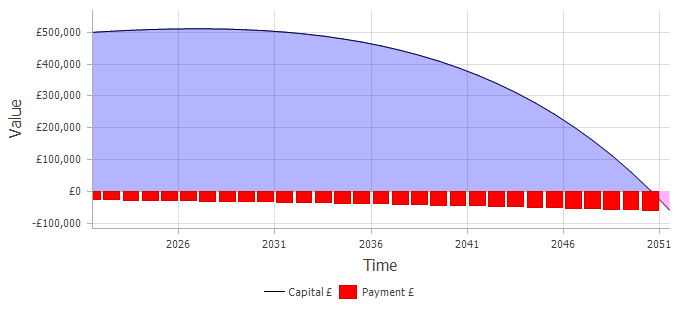
Other factors such as withdrawal timing, variable investment growth, charges, inflation, and tax could have a significant impact on these calculations.
If Quentin’s retirement funds fell in value sharply, this could impact the length of time his retirement income might last. Imagine that Quentin’s retirement plan fell in value by 20%. If this fund never recovered, Quentin’s retirement income might last 8 years less using the same assumptions.
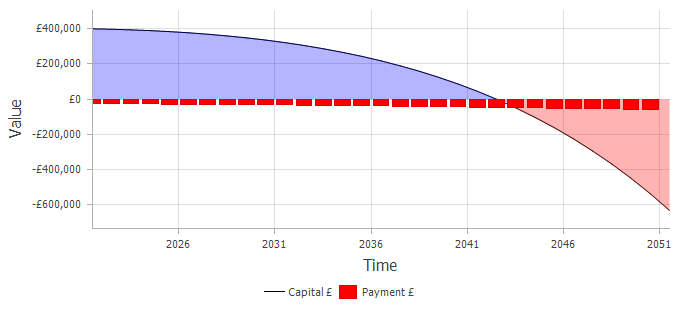
In the inevitable situation where Quentin’s retirement savings fall in value (this happens regularly, and should be expected), he will have to make a decision. What changes should he make to his retirement income to ensure that the capital value is not impacted too much?
Quentin could decide to reduce his income temporarily to allow his capital to recover. This is not a fun solution in retirement.
If instead, Quentin holds a cash reserve of £50,000, he knows he can allow his lifestyle to continue for 2 years before he has to make changes to the income level. We would typically expect investment markets to recover during this period, although this is not guaranteed.
The 4% rule and the Safe Withdrawal Rate
Many people use a general rule of thumb when calculating the Safe Withdrawal Rate in retirement. In 1994 a US financial planner published a study indicating that 4% was the Safe Withdrawal Rate for retirees planning to increase their income in retirement, and make their capital last for 30 years. Many additional studies have been performed since this research was published, and these generally suggest caution in using this approach, since markets are quite different in the current environment, and your investments may not match the study’s sample portfolio. The reality is that this is not a simple approach that suits every situation, and every retirement.
Action:
- Estimate the retirement income you have for guaranteed or variable sources
- Understand the difference between your standard expenses and variable expenses.
- Estimate your retirement income needs
- Understand the factors that influence your retirement income needs:
- How long will you realistically live?
- How will the cost of living rise in retirement?
- How much risk are you prepared to take in retirement?
- What tax will you pay in retirement?

Types of pension schemes
Planning your retirement can involve solving technical issues using various pension products. This section of the Planning your Retirement Guide aims to cover some of the most important types of pension schemes when planning your retirement. However, please bear in mind that this is a vast area, which is beyond even this extensive guide. This is not intended as a definitive technical guide to planning your retirement. However, the information below can help you to understand the main types of pension schemes.
The State pension
The state pension is a major source of guaranteed income for most people.
Eligibility for the state pension
You build up your state pension by paying National Insurance contributions during your working life. You need to contribute National Insurance for at least 10 years to qualify for the state pension. The maximum state pension is payable if you contribute for 35 years.
You can also qualify for state pension credits if you are unemployed, are in full time education, or are a carer.
The state pension age
The state pension age is different depending on when you were born. The table below sets out the state pension age.
| Date of birth | State pension age |
| On or before 05/04/1960 | 66 |
| 06/04/1960 to 05/03/1961 | Between 66 and 67 |
| 06/03/1961 to 05/04/1977 | 67 |
| 06/04/1977 to 05/04/1978 | Between 67 and 68 |
| 06/04/1978 or later | 68 |
The state pension age is likely to change in the future, as the population lives longer. The latest review into state pensions in March 2023 recommended that the government bring forward planned increases to the state pension age. The government announced that this will not be decided until at least 2025, but it is safe to assume that if you were born after 1970 that your state pension age might change in the future.
You can find out your state pension age here.
How much is the state pension?
The state pension currently pays a maximum of £203.85 per week, which is equivalent to £10,600.20 per year, or £883.35 per month. The state pension pays income every 4 weeks. Therefore, the full state pension would be paid as £815.40 every 4 weeks.
To qualify for the maximum state pension you must pay qualifying National Insurance contributions for 35 years. If you pay contributions for more than this, you will not get more than the maximum. Generally, you qualify for National Insurance credits if your income is greater than £123 per week. You start paying National Insurance when your earnings are greater than £242 per week. Different levels apply to self-employed workers.
If you accrue fewer years of contributions, your state pension will be reduced on a proportionate basis.
Annual increases to the state pension (the triple lock)
The state pension is particularly valuable since it increases in line with inflation each year (known as the triple lock). The government generally increase the state pension each year by the higher value of inflation (CPI), average earnings, or 2.5%. The triple lock was abandoned in 2022/23 due to the high rate of earnings growth towards the end of 2021. Instead, the state pension rose by 3.1%, which was the rate of increase in CPI at that stage. However, this was subsequently reinstated and the state pension rose by 10.1% in April 2023.
Is the state pension taxed?
The state pension is not taxed, but is taxable. This is a classic politician fudge. Essentially, your state pension will form the first tranche of your income, and therefore uses most of your income tax personal allowance. Ultimately, this means that your other income sources will be taxed at a greater level.
State pension forecast
The easiest way to find out your projected state pension is to obtain a state pension forecast. You can do this in 2 ways:
- Complete a BR19 form
You can print off a BR19 form to apply for a state pension forecast. This process takes around 2-4 weeks. - Use the Government Gateway
If you have your own Government Gateway account, you can obtain your state pension forecast within a few minutes. Click here to obtain your state pension forecast online.
What does a state pension forecast show?
Your state pension forecast shows 4 important pieces of information:
- The date and age of when you can claim the state pension”
- Your total expected state pension at retirement age
- The accumulated state pension to date
- How many more years you need to contribute to gain the maximum state pension
The state pension forecast is very useful to allow you to properly plan for your retirement income.
- Maximum state pension
If your state pension forecast shows that you have already qualified for the maximum state pension, then no further action is required. You can rely on the future income from your state pension age.
- More contributions required
Your state pension forecast may show that you need to pay further National Insurance to qualify for the full state pension. If you expect to work for these years, then you are on track, although you should regularly review your progress towards the full state pension. If you are no longer working, but have not yet contributed enough to qualify for the full state pension, you can consider topping up the state pension by making voluntary contributions.
Voluntary contributions
You may have gaps in your National Insurance contributions record. This can happen when you are out of work, have low income, or live abroad.
You can review your past National Insurance record, and can make up contributions voluntarily for up to 6 years.
Click here to check your National Insurance record online.
Once you have this data, you can easily assess whether it is worthwhile to pay voluntary National Insurance contributions.
Anita’s story
Anita came to us aged 60, and was no longer working. She obtained her state pension forecast, which revealed that she was missing 4 years of National Insurance contributions. Anita was entitled to the state pension at £160.08 per week (£8,324.16). The full state pension for 2021/22 was £179.60 per week, or £9,339.20. Therefore, with a full state pension contributions record, Anita would be able to increase the state pension by £1,015.04 per year.
Anita then obtained her National Insurance contributions record. This showed that if she were to pay a lump sum contribution of £3,054.56 then she would increase her state pension to the maximum level. Therefore, it would take Anita around 3 years to benefit from this transaction, once she claims her state pension from age 66.
How to claim the state pension
You do not receive the state pension automatically – you need to claim it. You can claim the state pension easily online.
You should receive a letter reminding you to claim the state pension within 2 months of your state pension age. You can also claim the state pension by calling 0800 7317898.
Delaying the state pension
You can delay the state pension if you do not need the income. You might delay the state pension if you receive taxable income, and want to avoid paying income tax.
You do not need to do anything to delay your state pension. If you do not claim your state pension, t will defer automatically. You can delay the state pension in chunks of 9 weeks. For each 9-week period you delay the state pension, it increases by around 1%. This works out to be around 5.8% for every year you delay taking the state pension. Of course, this will increase the future value of the state pension, which may mean that you end up paying more income tax on the increased state pension.
You can instead take the deferred state pension as a one-off taxable lump sum.
Action:
- Find out your state pension age
- Obtain your state pension forecast
- Establish if you will need further National Insurance contributions to get to the maximum state pension
Pension Plans
There are a wide variety of pension plans, and a full analysis is beyond this article. This section explores the main types of pension plans in the UK, and what the differences are. You will find information on what you need to know about your existing pension plans.
The main goal of your pension plan is to save money in a tax-efficient, long-term vehicle that is designed to provide you with a retirement income when the time comes. However, each pension plan was created to solve a different problem, and you are likely to have a variety of different schemes.
Defined Benefits Pension Schemes
A Defined Benefits pension scheme (also known as a DB scheme) is designed to provide you with a promise of a future income at retirement. These schemes typically provide you with a guaranteed income for life, which should increase in line with inflation in retirement. You do not own the Defined Benefits scheme – your employer does. You will instead be entitled to that promise of a future income based on the service with that employer.
A Defined Benefits scheme is generally less risky than a defined contribution pension scheme. However, Defined Benefits schemes are often less flexible than defined contribution pensions.
Your employer usually requires that you contribute to the pension scheme, but your employer will take the money paid in and invest it. This will be invested and used to provide the benefits at your retirement. The employer therefore owns the Defined Benefits scheme, and takes the risk that the underlying investments are enough to provide the future benefits. This requires careful management on the part of your employer, and is a weighty and expensive proposition.
Final salary vs career average
Older Defined Benefits schemes tended to be final salary pensions. This meant that your employer would provide a percentage of your final salary as an income, which would increase as your service built up over time. In extreme cases you might have built up a guaranteed income for life that was two thirds of your final salary with your employer.
Many Defined Benefits schemes have now moved to a career average basis. This is usually less generous than a final salary basis. Your employer will work out the average salary you had while employed, and will provide a guaranteed income based on the service you held with the. In most cases we tend to have a lower salary at the start of our career than at the end. Therefore a career average scheme is often intended to reduce the liability and cost to the employer.
What influences your Defined Benefits pension?
The final Defined Benefits pension usually depends on the terms of the scheme, which is set by your employer. The scheme rules will determine when you can retire, and the terms of that retirement. You will be required to make a regular contribution, but the only other factor is the length of your service with that employer.
Some schemes allow you to make additional voluntary contributions to top up your Defined Benefits scheme.
Action:
- Make a list of your defined benefits pensions
- Obtain projections from the scheme administrator to determine how much income you will get when you retire
Defined Contribution Pension Schemes
A defined contribution pension scheme (also known as a DC scheme) works very differently to a Defined Benefits scheme. A defined contribution scheme is designed to build up a pot of money in a tax-efficient long-term savings plan. This money is invested, and you hope this should grow over time. The money will be used at retirement to convert to an income, in a variety of methods.
Defined contribution pensions shift the risk to you personally. However, defined contribution schemes usually come with much more flexibility over the way you take your income in retirement.
Types of defined contribution pensions
There are many types of defined contribution pension plans. They can be divided into 2 camps: company pensions and personal pensions.
Company pensions
Company pensions can be different types of pension schemes. They are typically set up on a group basis so that your employer runs the scheme. This has a number of benefits:
- Lower cost as the scheme provides better terms based on the size of the scheme
- Easier administration as your employer handles this
- Employer contributions – this is a kind of deferred salary
However, company pensions can have some disadvantages:
- Less flexibility – perhaps the scheme will not have all retirement income options
- Less investment choice – often lower cost comes with some simplicity, which might not suit you
Examples of company pensions are:
- Auto-enrolment pensions (such as Master trust schemes)
- Group personal pensions (GPPs)
- Contracted in money purchase plans (CIMPs)
- Executive pension plans (EPPs)
- Small Self-administered Schemes (SSASs)
Personal pensions
There are a variety of personal pensions, each with their own characteristics. Personal pensions are designed for you to control your retirement saving, although your employer can still pay in to the scheme.
The main benefits of personal pensions are:
- More control over how you invest you money and take benefits
- Greater choice over how and when to generate retirement income
- Better tax efficiency of income in retirement or on death
- Potentially greater investment choice
Personal pensions can have some downsides:
- Higher costs than bigger company schemes
- Greater administration as you have to handle this yourself
Examples of personal pensions are:
- Personal pensions (PPs)
- Self-invested personal pensions (SIPPs)
- Stakeholder pension schemes (SHPs)
What influences your defined contribution pension?
The final defined contribution pension you get depends on the following factors:
- The amount you pay in
- The investment growth
- How and when you take your income
- The charges of the pension scheme
- Inflation
- Tax
Action:
- Make a list of all your defined contribution pensions
- Obtain projections from each product to establish how much income you could expect at retirement (this could change depending on the income options you change)
Tracing Old Pension Schemes
During your lifetime it is common to join a number of pension schemes. You may lose touch with a former employer, or an older scheme. IN addition, some employers cease trading, and some pension companies are acquired by other firms. Therefore, unless you are careful to keep track, you may lose sight of old pension schemes.
The good news is that you can trace old pension schemes via a Government service. All you need is the name of the pension provider, or your former employer, plus your personal details.
Click here to start tracing your old pension schemes.
Action:
- Go to the website listed above to trace any old pension schemes you may have lost contact with

Pension scheme contributions
This section of this Planning your Retirement Guide sets out the main rules and complications relating to pension scheme contributions. There are a lot of rules that govern pension scheme contributions. You need to be particularly careful if you want to make contributions that are greater than the standard Annual Allowance for pensions.
Contributions to a Pension Plan
To create an income in retirement, the most likely source of contributions is from you or your employer. Importantly, the amount you can pay into a pension plan personally, and still claim tax relief, is limited to 100% of your earned income for that tax year (or £3,600 without earnings). Thus, you can only pay limited amounts into a pension plan if your income is from other sources such as rental income.
Payments to Defined Benefits schemes
For a Defined Benefits scheme your employer will set the amount you must pay to be a member of the scheme. This is usually expressed as a percentage of your salary.
Payments to Defined Contribution schemes
You can pay money into your scheme personally, and your employer or other third parties can also make payments.
Personal contributions
There are 2 methods to make personal contributions. The defined contribution pension will determine the method used.
For some schemes you will benefit from tax relief immediately – the contributions are deducted before tax is taken from your income. This means you avoid the income tax you would have paid had you not made the payment into your pension plan.
Other schemes will deduct your contributions after tax has been taken out. This means your scheme will add tax relief to the pension. You may need to take further action if you pay income tax at 40% or 45%.
Pension tax relief at source
Most personal pensions work using the tax relief at source method.
You receive your normal income, and pay income tax and National Insurance on this. From your net pay you make pension contributions. The pension scheme then applies for tax relief on the basic rate element. Under the tax relief at source method you pay pension contributions after you have paid tax, and then reclaim tax relief at source.
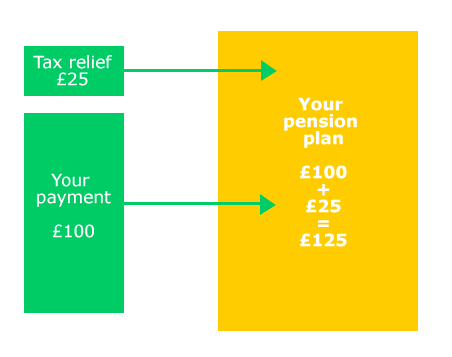
Pension tax relief for a 20% taxpayer
Pension tax relief acts by boosting the payments you make to your pension plan. For every £100 you pay into your pension plan, you get £25 as tax relief.
This represents a return of the basic rate income tax paid by you at 20%. So, the more you pay in, the greater the pension tax relief you can get.
Pension tax relief is one of the biggest advantages of pension plans – after all there are not many investments where you can guarantee a 25% growth on your contributions on day 1.
Reclaiming additional tax relief for 40% or 45% income taxpayers
Under the tax relief at source method, if you pay into a personal pension and also pay income tax at 40% or 45% you can reclaim additional tax pension tax relief through your tax return. Alternatively, you may be able to ask the tax office to adjust your tax code to reflect the pension plan contributions, and thus save tax at source.
- As a 40% income taxpayer your £100 contribution would attract a further £41.66 back in tax saved;
- As a 45% income taxpayer your £100 contribution would attract a further £56.81 back in tax saved.
You must remember to claim the additional tax relief due to you – it does not happen automatically. You may be able to ask for unclaimed tax relief for up to 4 years from the end of the tax year for which it is due.
Pension Net Pay method
The net pay method is used by some Defined Contribution pension schemes. This is different to the tax relief at source method.
Under the net pay method, your employer will deduct your personal contributions before applying income tax and National Insurance. This means that the net pay method deductions for your pension plan come out of your gross pay before tax. Effectively, this reduces your taxable pay, and therefore reduces the income tax as well. The contributions do not attract tax relief, but instead reduce the tax you pay. This is more convenient for 40% or 45% income taxpayers, as it means that you do not have to reclaim tax relief due to you via your tax return.
The net pay method is poor value for those who do not pay income tax. Non-taxpayers do not benefit from a reduction in tax under the net pay method. If the same workers were to use the tax relief at source method, they would get tax relief at source of 20%, boosting their pension contributions.
Net pay method boost for low earners from April 2026
Under the current rules, if a person receives a low income, they may be disadvantaged by making pension contributions using the net pay method. This is because, if that person earns too little to pay income tax (currently less than £12,570) any pension contributions will not reduce their tax. A low earner making pension contributions is likely to be better off making payments to their scheme using the pension tax relief at source method.
The new plan from April 2026 is to allow contributions to net pay pensions for low earners to receive tax relief in the same way as if these are made at source. The Government has announced legislation to equalise the tax arrangements for low earners who use the net pay method. The expectation is that these workers will receive a top up to their pension contributions from 2026.
Pension tax relief for the self-employed
If you are self-employed, you will need to account for your pension contributions in your tax return. If you pay income tax at a higher rate than 20% you will also get to reclaim the additional tax relief due.
Employer pension contributions
Your employer or other third parties can pay contributions into your pension scheme. You do not get tax relief on this money, but your employer can save some tax.
You should consider this method if you are a business owner – see below.
Pension contributions for non-earners
You can make limited pension contributions even if you are a non-earner. This applies if your income comes from other sources such as rent or investments. The only personal pension contributions permitted which attract tax relief apply to earned income.
The maximum you can pay per tax year into a defined contribution scheme from other sources is £3,600, including tax relief. This means that you will pay £2,880 as a personal contribution. £720 of tax relief is then added, making a total of £3,600 paid into the pension plan.
Many non-earners, looking for tax-efficiency, use this method. You can pay pension contributions in these situations:
- For children or grandchildren
- For your spouse
- To divert taxable savings into a tax-free pension
- To avoid inheritance tax, even after you stop working
Pension contributions for overseas workers
If you become non-resident, but previously had earnings in the UK you can still pay into a pension scheme for up to 5 years after the tax year in which you leave UK residency. In practice schemes tend to limit this to £3,600 per tax year. Therefore, if you take a job overseas you could consider continuing payments of up to £2,880 per tax year for 5 years, which would attract tax relief of £720 per year.
Pension contributions after age 75
Technically, you can pay into a pension scheme after age 75, but you will not receive tax relief if you do pay into your scheme.
Action:
- Are you making the most of the pension tax relief available to you
- Are you saving enough?
- If you are a higher rate taxpayer, are you reclaiming the additional tax relief?
The Annual Allowance for pensions
The Annual Allowance is the amount you are allowed to pay into your pension plans in any tax year without incurring additional tax.
- If your contributions are less than the Annual Allowance there is no tax to pay.
- If your pension contributions exceed the Annual Allowance, you may have to pay a tax charge. This is known as the Annual Allowance Tax Charge.
The standard Annual Allowance increased to £60,000 from 6th April 2023 (it was £40,000 previously).
When can the Annual Allowance reduce from £60,000?
The Annual Allowance reduces if the following applies to you:
- You are a high earner (total remuneration greater than £260,000); or
- You have accessed your defined contributions pensions flexibly.
Exemptions from the Annual Allowance
You do not have to test pension contributions against the Annual Allowance in these situations:
- Death of a member
- Serious ill health (meaning life expectancy is under 1 year)
- Severe ill health (meaning you are unlikely to ever return to work)
What contributions affect the Annual Allowance?
The Annual Allowance is affected by any of the following
- Contributions to your defined contribution scheme in the tax year
This could be personal payments, tax relief, employer contributions, or any other third party. - Any increase to your Defined Benefits scheme in the tax year
The Money Purchase Annual Allowance (MPAA)
Your standard Annual Allowance will reduce to £10,000 if you access your pension benefits flexibly. This is known as the Money Purchase Annual Allowance. The Money Purchase Annual Allowance increased from the previous level of £4,000 after 6th April 2023.
You will not be subject to the Money Purchase Annual Allowance if you take any of the following benefits:
- Defined Benefits scheme pension
- Tax-free cash (pension commencement lump sum)
- Defined contribution pension annuity (unless this comes from flexible benefits like a drawdown plan)
Therefore, if you take flexible income from a drawdown pension plan, the Money Purchase Annual Allowance will apply to you.
The Tapered Annual Allowance
The pension tapered annual allowance is a serious issue if you earn a high income. It could lead to significant extra tax bills.
If your total income is greater than £260,000, and you pay into a pension plan, you need to be aware of the pension tapered annual allowance for high earners. You may find that your ability to make pension contributions reduces by up to £50,000, to a maximum contribution limit of £10,000. Contributions over this tapered annual allowance attract additional tax at up to 45%. Different taper triggers apply for past years, so you need to take care if you are a high earner as the tapered annual allowance could apply in some tax years but not others.
The pension tapered annual allowance for high earners
Everyone has a standard annual allowance, which permits you to pay up to £60,000 into your pension schemes. This applies to contributions or increases to pension benefits from all sources, per tax year.
Any payments over this figure are subject to an additional tax charge at your marginal rate of income tax – 20%, 40% or 45%, depending on your earnings.
The annual allowance has reduced dramatically in recent years, from £255,000 in 2011/12 to its current level of £60,000. If you are taking taxable income using flexible drawdown then your annual allowance is reduced to £10,000 (known as the Money Purchase Annual Allowance).
If your ‘adjusted income’ is over £260,000 you may find that your ability to make pension contributions has been reduced. It is quite possible that your current pension contributions would incur additional tax at 45%.
Adjusted income over £260,000 will reduce your pension annual allowance by £1 for every £2 of income above this figure. The annual allowance for pensions will reduce to a minimum of £10,000 per tax year if you earn more than £360,000.
Prior to 6th April 2023, the tapered annual allowance started at a lower level (£240,000) and reduced gradually to £4,000 for income over £312,000. Now, the tapered annual allowance starts at a higher threshold, and reduces to a minimum of £10,000.
Prior to 6th April 2020, the tapered annual allowance started at a lower level (£150,000) and reduced gradually to £10,000 for income over £210,000.
How the tapered annual allowance makes pension planning difficult
Each tax year will be treated differently, so your earnings in one year might mean you have a reduced Tapered Annual Allowance; in other years you might have the full standard annual allowance. This can make it difficult to plan for high earners. Many high earners receive unpredictable income, such as bonuses or share awards. This additional income usually comes at the end of the tax year. Ultimately, this may mean that you are subject to the tapered annual allowance in one tax year, but not another. You may not know the full picture until you are awarded your final bonus. This will make it difficult for you to plan your pension contributions using bonus sacrifice, which is a tax-efficient method of giving up some of your bonus in exchange for tax relief into your pension.
How the tapered annual allowance changed from 6th April 2023
This chart shows the effect of the changes between the 2022/23 and 2023/24 tax years. The green line shows the tapered annual allowance and how it operates from 6th April 2023, depending on your adjusted income. The blue shaded area shows the previous adjusted income bands from which applied until 5th April 2023. You can clearly see the improved tapered annual allowance. The lowest that the Tapered Annual Allowance falls to is £10,000.
What is adjusted income?
If your adjusted income is greater than £260,000 you will start to lose your annual allowance. This was £240,000 prior to 6th April 2023.
- Adjusted income includes the total of the following:
- Employment income – salary, bonus, benefits in kind
- Profits from self-employment
- Pension income
- Property income
- Dividends
- Savings income
- Taxable lump sum death benefits
- Employer pension contributions
- Salary exchange contributions
- Individual pension contributions under a ‘net pay’ scheme – usually from an occupational pension scheme or retirement annuity contract
If you pay into a personal pension, then your individual pension contributions usually come out of net pay, and therefore do not need to be added back to adjusted income.
Employer pension contributions do count in adjusted income.
Any pension contributions which may be made to reduce your taxable income, such as salary exchange, are now taken into account when determining your adjusted income for your pension annual allowance if you are a high earner.
You can use some allowances to reduce adjusted income, such as gifts to charities.
An exception – threshold income below £200,000
If your ‘threshold income’ is not greater than £200,000 in a tax year, the annual allowance is not tapered for that tax year, even if your adjusted income is over the limit. These rules are designed to protect lower earners. The Threshold Income limit was set at £110,000 prior to 6th April 2020 but did not change when the adjusted income limit was raised after 6th April 2023.
What is threshold income?
If your threshold income is less than £200,000 (£110,000 prior to 6th April 2020) then you cannot be subject to the tapered annual allowance, even if your adjusted income is greater than £260,000 (£240,000 prior to 6th April 2023). You can see that this is complex and requires careful planning.
Threshold income includes:
- Income from employment- salary, bonus, benefits in kind
- Profits from self-employment
- Pension income
- Property income
- Dividends
- Savings income
- Taxable lump sum death benefits
- Salary exchange contributions to pensions since 9th July 2015
- Individual pension contributions under a ‘net pay’ scheme – usually from an occupational pension scheme or retirement annuity contract
Importantly, this definition does not include employer pension contributions. If a salary exchange arrangement was set up before 9th July 2015 this amount is not included in your threshold income. Therefore, business owners can legitimately pay employer pension contributions to reduce their threshold income, subject to anti-avoidance measures (see below).
Example 1 – Adjusted income over £260,000
Julie receives the following income and pension benefits.
Salary of £250,000.
Employer personal pension contributions of 10% of salary per year, or £25,000.
Bonus £75,000
Total remuneration – £350,000
Julie’s adjusted income is £300,000. Since this takes Julie over the £260,000 threshold, the additional £100,000 means a £35,000 reduction in the pension annual allowance to £15,000. Since Julie’s pension scheme benefits from tax relief at source, her personal contributions are not added back in to the adjusted income calculation.
Julie’s tapered annual allowance is now £15,000. Her employer pension contributions exceed this annual allowance by £10,000. Therefore, Julie will need to pay additional tax of 45% on the excess, via her tax return. This would mean additional income tax of £4,500.
What if Julie does not receive a bonus?
Imagine the same figures in the following tax year, without the bonus.
Julie’s total remuneration (without the bonus) is now £275,000. The excess of £15,000 over £260,000 reduces Julie’s annual allowance by £7,500. Her tapered annual allowance is now £52,500. Julie’s employer pension contributions (£25,000) are within the tapered annual allowance, meaning no additional income tax charges. In fact, Julie could pay in an additional £27,500 in personal contributions to her pension scheme without incurring additional tax charges, or having to use carry forward.
Example 2 – Threshold income below £200,000
Tim runs a business and pays himself a salary of £12,000, plus dividends of £88,000. He also owns 6 rental properties, providing a total income of £50,000. His taxable income is therefore £150,000, which is below the threshold income figure of £200,000. If he pays a company contribution of £120,000, this will not reduce his annual allowance, since his threshold income is below £200,000. The fact that his adjusted income is now £270,000 is not relevant.
Anti-avoidance measures for the tapered annual allowance
The legislation includes anti-avoidance measures to stop you trying to avoid the impact of the tapered annual allowance.
Therefore, you could be caught within these measures if:
You use salary sacrifice to give up the right to income in return for the making of a relevant pension contribution; or
You manipulate your remuneration so that your employer agrees that pension contributions are made instead of other employee benefits.
Any arrangement will be caught by the anti-avoidance measures if:
- it is reasonable to assume that the main purpose, or one of the main purposes, is to reduce the impact of the tapered annual allowance; and
- the arrangement has the impact of reducing either or both the adjusted income or threshold income figure; and
- the reduction in either or both adjusted income or threshold income is redressed by an increase in the individual’s adjusted income or threshold income for a different tax year.
Where an arrangement is caught by the anti-avoidance measures it will be ignored for the purpose of calculating the tapered annual allowance.
What can you do to avoid the tapered annual allowance for high earners?
If your income exceeds the £200,000 threshold income level, then there is little you can do to avoid the tapered annual allowance. If you own a business, you may be able to adjust your income levels to bring your total income below the threshold income level, but you should take care not to fall foul of the anti-avoidance measures. Because pension contributions are not included in the definition of threshold income you may be able to use a pension contribution to take profits from the business if your threshold income is below £200,000.
In practice, employees will find it very difficult to avoid the additional tax payable on pension contributions. This will be especially true if you receive bonuses at the end of the tax year. Pension contributions already made throughout the tax year may now attract additional tax purely because of a large bonus which reduces your annual allowance.
The only alternative will be to use carry forward wherever possible, although this may be reduced by the tapered annual allowance for previous tax years.
Without available pension annual allowance, many high earners choose to forego pension contributions, and instead take salary in lieu of their pension. The basic reasoning is that if you are going to be charged additional income tax, you might as well receive the salary, rather than pay into the pension. However, there are occasions where it may continue to be worthwhile to receive pension contributions from your employer, even if these attract additional tax charges. It makes sense to do the tapered annual allowance calculations for each tax year.
Action:
- If you are affected by the annual allowance, check out our section on High Income
Carry forward for pensions
Carry forward allows you to use up unused standard pension Annual Allowance for the past 3 tax years. You cannot carry forward unused Money Purchase Annual Allowance.
How Carry Forward works
- Use current tax year Annual Allowance
You must first use your Annual Allowance for the current tax year. For most people this will be £60,000, unless you are subject to the Tapered Annual Allowance.
- Use the earliest available tax year and work forwards
Once you have used the Annual Allowance for the current tax year, you then go back 3 further tax years to use up unused Annual Allowance from that tax year. You keep moving forwards until the available Annual Allowance is completely used up. You do not need to use all of your carry forward in one go. - Deduct previous pension contributions for each tax year
The maximum Carry Forward available to you is £160,000 – £40,000 for the 2022/23 tax year, and £40,000 for each of the 3 previous tax years. If you have previously made pension contributions, you need to deduct these from your available Annual Allowance. From 6th April 2023 the Annual Allowance increased to £60,000. Therefore, the maximum Carry Forward available to you is £200,000 – £60,000 for the 2024/25 and 2023/24 tax years, plus £40,000 for each of the 2 previous tax years
You do not need to report any use of Carry Forward to HMRC, but it makes sense to keep records.
How Carry Forward works in practice after 6th April 2023
The above image shows carry forward working in 2 different situations, assuming no previous pension contributions have been made.
The top row shows the maximum carry forward available if no contributions have been made:
- £60,000 for the 2024/25 & 2023/24 tax years
- £40,000 for each of the previous 2 tax years
The second row shows an example carry forward where someone pays in £130,000 to their pension scheme. In this case, the 2024/25 tax year’s Annual Allowance is used (£60,000). We then go back to the tax year -3 to use that year’s Annual Allowance (£40,000), and then part of tax year -2 (£30,000).
The third row moves the situation on a further year. The possible contributions for this tax year are shown in orange. We need to use the 2025/26 tax year’s Annual Allowance first (£60,000). The previous -3 tax year is now no longer considered. The previous -2 tax year becomes -3. We have the full allowance for -2 (£60,000) and a quarter of -3 tax years (£10,000). Therefore, the maximum contribution is £130,000.
Action:
- Consider whether you have unused annual allowance
- If you are affected by the annual allowance, check out our section on High Income
- If you are a business owner, consider using carry forward to allow greater employer pension contributions
Maximum pension tax relief
When making contributions to a pension plan you can claim tax relief. The maximum tax relief you can claim in a tax year is based on 100% of your earned income. Therefore, you can pay pension contributions up to 100% of your taxable earned income; tax relief cannot be claimed for contributions over this figure.
This rule interacts with other areas such as carry forward, the standard Annual Allowance, and the Tapered Annual Allowance.
- If your earned income is below the Annual Allowance
The maximum tax relief is based on 100% of your earned income. If, for example, your earned income is £25,000 for the tax year then the maximum pension contribution is limited to £25,000 if you want to claim tax relief. You may pay pension contributions on which you do not claim tax relief (if your pension scheme allows this). You can also receive employer contributions in addition to your personal contributions. - If your earned income is above the Annual Allowance
The maximum tax relief is based on 100% of your earned income. If, for example, your earned income is £75,000 for the tax year then the maximum pension contribution is limited to £75,000 if you want to claim tax relief. You may pay pension contributions on which you do not claim tax relief (if your pension scheme allows this). You can also receive employer contributions. In this case, your maximum pension contributions would be greater than the Annual Allowance. If you want to be able to pay in more than £60,000 during the 2024/25 tax year you would need to use carry forward rules.
Example of maximum tax relief rules interacting with carry forward
In this example, the purple bar represents a person with earned income of £75,000. The person could pay up to £75,000 into their pension and claim tax relief, even though this is greater than the Annual Allowance, provided they have available Carry Forward from the previous 3 tax years, which is worth £35,000 or more.
The blue bar represents a person with earned income of £25,000. This person could only pay in £25,000 of personal contributions, which would attract tax relief. The 2024/25 Annual Allowance is greater at £60,000, but the maximum personal tax relief is limited to 100% of earnings. In the case of the person with £25,000 of earned income, Carry Forward would not be available unless employer contributions are made to the pension scheme.
Action:
- If you are affected by maximum tax relief, check out our section on High Income
Salary sacrifice or bonus sacrifice
What is salary sacrifice or bonus sacrifice?
If you are a high earner, the chances are that you receive a high basic salary as well as bonus payments. Typically, you will be offered the chance to sacrifice some of this income or bonus and instead have that money paid into your pension scheme. This is known as salary sacrifice or salary exchange if you operate the transactions months. If you apply this to your bonus payments we call it bonus sacrifice. Ultimately, these are the same thing.
Why consider salary or bonus sacrifice?
Salary sacrifice or bonus sacrifice gives an immediate tax saving, since you are not taxed on the amount of salary or bonus that you give up. Your total income is reduced and therefore you are only taxed on the income you actually receive.
What happens is that you agree with your employer that you will sacrifice part of your salary or bonus. Instead, your employer pays this money straight into your pension plan as an employer contribution, which is taxed more efficiently than a salary payment.
The contribution that goes into your pension plan is not taxed, as it is an employer contribution. This means that you save on Income Tax at 20%, 40% or 45%, depending on your income level. You should also save National Insurance. In addition, your employer will not pay National Insurance on the amount of bonus given up – usually at 13.8%.
In many cases employers are prepared to pass on some or all of these savings. If you earn above £100,000 your Income Tax personal allowance is reduced by £2 for every £1 earned above £100,000. This can mean an effective rate of tax of up to 60% for earnings between £100,000 and £125,000. By reducing your bonus you may be able to save even more tax.
Salary sacrifice and bonus sacrifice for high earners
The way that salary sacrifice and bonus sacrifice works for high earners has changed. Since April 2020 if your total income is greater than £200,000 you may be affected by the tapered annual allowance for high earners. This assesses your total income, including pension contributions such as salary or bonus sacrifice. If the total is over £260,000 then you will lose your annual allowance for pensions progressively until at £360,000 income you will only have £10,000 available for pension contributions.
Pension contributions over the tapered annual allowance are taxed at 45%. Read the article referenced above for much more information. In practice this means that it is much more difficult for high earners to use salary sacrifice and bonus sacrifice.
How does salary sacrifice and bonus sacrifice work in practice?
You write a short letter to declare the amount of salary or bonus you wish to sacrifice. This decision cannot be reversed and should be legally binding to be valid. Your letter should declare the original salary and bonus, and detail the amount to be sacrificed in place of a pension contribution. The bonus must be given up before it is received to be effective. Together, these elements mean that your right to receive the cash element sacrificed has been removed.
Your employer pays the sacrificed salary or bonus into your pension plan as an employer contribution. This contribution should be treated as a legitimate business expense and would therefore reduce the employer’s Corporation Tax.
It is not necessary to inform HMRC, but it is good practice to do so.
It is not possible to sacrifice 100% of your earned income as your employer must still comply with the National Minimum Wage.
Action:
- Consider using salary sacrifice to keep more of your salary or bonuses
- Check out our section on High Income
Using pension contributions to qualify for child benefit
If you earn more than £60,000 after 6th April 2024, you progressively lose child benefit. The child benefit reduces to nil once your income reaches £80,000.
One option is to use pension contributions to reduce your income to below the £60,000 threshold. This would then allow you to claim the full child benefit.
Prior to 6th April 2024 child benefit reduced between £50,000 and £60,000 income.
Example of using pension contributions to qualify for full child benefit
Sarah has an income of £65,000 for the 2024/25 tax year. This means she will effectively lose 25% of her child benefit for her son, Simon. The rate of child benefit for the eldest child for 2024/25 is £25.60 per week.Sarah’s income means she loses £332.80 child benefit.
Sarah could make a pension contribution of £4,000. This qualifies for tax relief of £1,000. £5,000 would be paid into Sarah’s pension scheme, and the effect is to reduce her income to £60,000. Therefore, she will obtain the full child benefit.
As a 40% tax payer, Sarah can also reclaim an additional tax rebate via her tax return, worth a further £1,000.
The effective cost to Sarah is £2,667.20. However, £5,000 will be paid into her pension scheme.

Pensions – technical issues
This section of the Planning your Retirement Guide examines general technical issues you might need to understand when running your pension scheme. This might include statutory minimum ages, or what happens to pension schemes on death.
Pensions – normal minimum retirement age
This means that the earliest you can usually access your retirement income is at age 55. Some older schemes may have earlier retirement ages. Some protected occupations also have their own special rules.
Normal Minimum Retirement Age
The UK government plans to change the rules on the Normal Minimum Retirement Age. From 6th April 2028, the Normal Minimum Retirement Age will change from age 55 to age 57.
You may be able to retain a lower retirement age if your scheme offered this as an unqualified right before 4th November 2021. If your pension scheme did not offer an unqualified right to take benefits earlier than age 57 before the change was announced in 2021, then the new minimum pension age will be age 57 from 2028.
“Unqualified right”
An unqualified right means that you were able to take pension benefits earlier than age 57 without needing the consent of someone else (for example the scheme trustees or employer).
If you join or transfer in to a scheme that permits earlier retirement ages, you cannot benefit from the earlier retirement age.
Transfers from qualifying schemes
You can transfer an existing pension scheme which has an earlier retirement age without losing the protected pension age.
Action:
- Establish whether you are likely to need access to your pension income before age 57 – if so the Normal Minimum Pension Age could be an issue
Pension investments grow tax-free
Pension schemes grow tax-free. This means that once your pension contributions are within the pension tax wrapper, your money will not pay income tax or capital gains tax. Some other minor tax charges may be paid by your investments.
This tax-free nature of your pension plan is one of the most powerful reasons for making contributions. The tax-free nature of your pension plan should mean that your money grows faster over time.
The fact that your pension is tax-free is so powerful that it can be more beneficial to save into your pension even if this means paying more income tax, perhaps if you are a high earner. This is individual and may need careful assessment from a financial planner.
Action:
- Consider making greater pension contributions to shelter more money from tax.
Investment Choice
If you hold a defined contribution pension scheme you will need to invest your money for above-inflation growth over time. This is one of the most powerful aspects of a pension plan. Your contributions are invested tax-efficiently, and then can grow at a faster rate than standard savings if invested wisely.
To read more about how to invest your pension money read our article on How to invest.
Action:
- Are you taking the appropriate risk with your retirement money?
- Consider a review of your pension plans to make your money work harder.
Pension Lifestyling
Pension lifestyling aims to gradually reduce risks in your pension investments as you approach retirement age and is a common feature of many workplace pension schemes. You should read this section if you are 10 years away from your pension scheme retirement age (most likely if you are aged 50-55, or older).
This article explains why pension lifestyling is not fit for gradual retirement via flexible pensions. We explore why you should consider an alternative approach, especially if you plan to retire early, or access your pension flexibly.
What is pension lifestyling?
Pension lifestyling aims to reduce the risks you take with your pension funds as you approach retirement age. The aim is to preserve the purchasing power of your pension funds so that you are not penalised by unexpected stock market falls just before you retire. This is sensible if you plan to buy a pension annuity, but not if you want to use flexible pensions.
In general, the more risk you are prepared to take with your pension funds, the greater returns you can expect, on average over time. The reverse tends to be true: if you take less risk with your money, you should expect lower returns. Always remember that there are no guarantees with investing money.
Savings in pension schemes tend to be made over a very long period. Your working life can be more than 40 years, and the life of your pension savings can be until the day you die, so feasibly your pension scheme could run for 30 years after your retirement from work. For this reason, it is generally good practice to use shares in your pension investments, as this should lead to greater investment growth over time. The downside is that shares can be volatile (their value shifts up and down rapidly).
The purpose of a pension plan is to provide you with an income in later life. If your pension fund falls in value just before you retire, your income may reduce in later life. Pension lifestyling aims to reduce this risk.
This example shows the risk that pension lifestyling aims to solve. Your fund tends to grow over time (the green line). In practice, the fund value will fluctuate, and would not progress in a linear way like in the example. Ideally, you would take your income from the fund at retirement with continued growth (the purple line). If your fund drops in value just before you retire (the red line), then you risk taking less income from your pension fund. If you want a guaranteed income for life, (using a pension annuity) then you will lock in this loss permanently.
How does pension lifestyling work in practice?
Each scheme approaches pension lifestyling in a different way. In general, the idea is to gradually reduce the risks of your investment portfolio as you approach your retirement age. The standard way to do this would be to gradually shift your investments from higher risk funds to lower risk funds, at set intervals. Pension lifestyling might look something like this:
In this case, your pension fund would gradually shift from higher risk to lower risk, so that the day before you retire from the pension scheme, you are sure that your fund value would not go down in value. This allows you to retain the purchasing power of your pension plan.
Many pension schemes also offer special retirement funds, which are designed to preserve your capital before you make decisions with your money.
Which pension schemes use pension lifestyling?
Pension lifestyling applies to money purchase pension schemes. These pension schemes allow you, and your employer, to save money from your salary into a fund that will accumulate over time in a tax-efficient scheme. The idea is that you build a pot of money over your working life, which can be converted into an income to fund your retirement. If you have a pot of money that goes up and down in value each year, you have a money purchase pension. With money purchase pensions you take the risks with the savings. If the pot of money grows, you will have more money from which you can take an income; if it falls in value, then your income will be smaller.
Pension lifestyling does not apply to you if you have a defined benefits pension, since your pension scheme will take the risk, and therefore promise a guaranteed income for life in retirement. This guarantee is why defined benefits pension schemes are so valuable to members, and why you should be very cautious about moving away from these benefits. If your employer sends you a statement each year to tell you how much your guaranteed income will be in retirement, then you probably have a defined benefits pension.
When does pension lifestyling work well?
Pension lifestyling is a great solution for you if you want to buy a guaranteed income for life (called a retirement annuity). Typically, if you buy a retirement annuity, you swap your pension fund for a fixed income. The income paid will depend on a range of factors such as your age, health, lifestyle, and importantly the value of your pension fund. If your pension fund falls in value just before you retire, then you will lock in this drop in value for the rest of your life. This is what pension lifestyling aims to avoid.
Let’s revisit our earlier example.
The chart above shows the real effect on your retirement income, using some simple assumptions. For the purposes of this section we have assumed that you can get a guaranteed income from your pension annuity of 5% per year, although this will vary in practice according to the market rates, and your personal circumstances.
Based on these assumptions, if your pension fund value grows from £100,000 to £120,000, then your pension annuity will be £6,000 per year (the purple line).
If your pension fund value falls from £100,000 to £80,000, then your pension annuity will be £4,000 per year (the red line).
The difference can be dramatic, and unfortunately you will lock in these income reductions for the rest of your life. Pension lifestyling avoids this problem, but only if you plan to buy a pension annuity.
When should you avoid pension lifestyling?
You are retiring early, or late
Pension lifestyling works well if you plan to retire at the retirement date you set when you started your scheme, and if you plan to buy a pension annuity. How likely is this in your case?
Many retirement schemes use dates that are set by your employer, and not by you. Just because someone else decided that you should retire at age 60, or age 65, doesn’t mean that this fits your circumstances. Also, the state pension is rarely aligned with other pension scheme retirement dates.
- If you retire early
Pension lifestyling might not have fully reduced the risks in your pension funds, which would still leave you open to falls in your pension fund (although not as great as would have otherwise been the case). The earlier you retire, the more you put your fund at risk of falling just before you take your pension income; - If you retire late
Pension lifestyling might have completed, but you might suffer from years of reduced investment growth while you make your decision to retire from the scheme. This could have an effect on your eventual retirement income if investments would have grown during that period. The longer the period with no investment growth, the further behind your income could fall.
You want a flexible retirement (drawdown)
Many people now use flexible pensions to build a retirement that works for them, rather than being tied to a traditional fixed income. Flexible pensions work well in conjunction with other sources of guaranteed income, like retirement annuities, final salary pensions, and the state pension. You can choose when you take your income, how much you take, and can pass on the value of the fund to your family if you die before your pension scheme is exhausted. The downside is that these schemes need greater management, and carry risk and charges for your money.
Case study – flexible retirement in practice
Many people use flexible pensions to bridge a gap in their income while they gradually retire on their terms.
Let’s examine a case study of how this might work in practice. Jenny is approaching age 60. She wants to achieve an income from all sources of £30,000 per year. She wants to gradually retire from her current work as a freelancer, but she wants to balance her work commitments over the next few years, so that she works on her terms. She will receive her state pension at age 66, worth £7,500 per year. Her former employer’s final salary pension pays her £6,000 per year from age 65. She plans to earn less from her work over a few years, and will reduce her earnings from £30,000 per year now, to £7,500 by the time she is aged 64.
You can see from this example, how the traditional pension annuity would not fit Jenny’s lifestyle and income plans, since she does not want the same income each year from her pensions. She needs a different level of income at each stage of her gradual retirement from work, but this needs to change according to her needs. A pension annuity would probably not suit her needs as much as taking flexible income from her pension plan.
Here is a simplified version of Jenny’s proposed solution:
Jenny needs to add to her income from her flexible pension plan to top up her self-employed income (the blue in our chart). The additional income from her pension plan is shown by the orange in our chart. This needs to change as her self-employed income reduces, and she starts to receive a guaranteed income from her other sources.
Flexible pensions and lifestyling
If you plan to use flexible pensions, you need to change your perspective on the term of your pension investment.
- Pension annuity term
The end date for your pension will be when you expect to enter into a pension annuity. This is the date you swap your pension fund for the pension annuity. If you want a guaranteed income, the concept of pension lifestyling works (assuming you time the reduction in risk correctly); - Flexible pensions term
The end date for your pensions will be completely different with flexible pensions. The investment term could conceivably be for the rest of your life – potentially greater than 20 years past the traditional scheme retirement date.
If you want to use flexible pensions, then the concept of pension lifestyling no longer works. Why would you want to reduce risk to nil in your pension portfolio, if you want the money to last as long as possible? You should aim to maintain an appropriate level of risk to enable you to extend the income paid under the pension scheme. Only when you want to move to a pension annuity, or if you have another reason to reduce risk, would you take risk off the table. If you enter flexible pensions, you should probably maintain a high risk level in your portfolio, with the aim of increasing the total income available from your pension plan.
Reviewing what you want in retirement
Unfortunately, many pension schemes are set up as if there is one solution that works for everyone, which is why they set up pension lifestyling. If you are approaching the age when you might consider accessing your retirement savings (over 50), then you should review how your pension investments are structured. Not only will this give you an idea of the potential income available to you, but also how you might be able to take this income in the future.
Action:
- Examine each pension scheme to see if pension lifestyling will apply
- Find out how your pension investments will change, and over what period
- Consider how you might want to take your income in retirement
- Adjust your investment strategy to match your pension income goals
Pension Scheme Withdrawals
This section explores the general position for pension scheme income. We have explored more complexity in the section below.
Tax-free cash
You are allowed to take 25% of your fund as tax-free cash (technically known as the pension commencement lump sum or PCLS). This can be taken as 25% of the entire fund, or in slices (provided that the scheme rules allow this).
Maximum tax-free cash
The maximum tax-free cash allowed from 6th April 2023 is £268,275 (25% of the standard Lifetime Allowance for 2022/23). It is likely that this maximum level will not increase in the future, which could be seen as the first step in eventually removing tax-free cash for pensions.
Taxable income
The remaining pension fund income is taxable against income. The pension income is added to your other sources of income for that tax year, and taxed at 0%, 20%, 40% or 45%, depending on your income.
Taxable income may be:
- Scheme pension for a Defined Benefits scheme
- Pension annuity
- Flexible pensions such as drawdown
- Uncrystallised funds pension lump sum
Action:
- Establish which type of pension income you can take from each of your pension schemes.
Pension scheme death benefits
Your pension plans could be worth a lot of money, but you may not exhaust these funds during your lifetime. This section considers what would happen if you die before using all of these pension funds. Your pension death benefits may be a valuable asset you can pass on to future generations.
This section also shows you one of the most powerful features of pension plans – how pension death benefits can save inheritance tax, and even pass on a tax-free income to your dependents or nominees.
Pension death benefits
When you die, your family would usually be entitled to receive the value of your pension scheme at death. The pension death benefits depend on the type of pension plan you hold. In most cases, the pension death benefits are tax-free, but this may not always be the case.
Death benefits for Defined benefits schemes
A defined benefits scheme is not owned by the member, but instead pays a future guarantee of an income. Therefore, there is not an available fund to pass on to the heirs of the member on death.
However, you may receive a lump sum death benefit, and possibly a spouse or dependent’s pension, depending on the rules of the scheme, and whether you are retired or not.
Death before retirement in a Defined Benefits scheme
Most Defined Benefits schemes pay out a tax-free lump sum payment to the spouse or dependent children. This is typically 2 to 4 times the salary of the member, but depends on the rules of the scheme. If death occurs before age 75 this will be tax-free.
The scheme would also pay a taxable, reduced pension to the surviving spouse. This is one area where the tax position is worse for defined benefits schemes compared to defined contribution schemes and annuities.
Death after retirement in a Defined Benefits scheme
The Defined Benefits scheme would usually pay a taxable reduced pension to the surviving spouse. Again, this position is worse for defined benefits schemes than for other pension plans.
Summary of typical death benefits paid by Defined Benefits schemes
- Lump sum death benefits
This will usually be a multiple of salary, and will usually be provided for members of the scheme who are still employed. - Scheme pension
This is usually based on a percentage of the member’s pension entitlement, and will be taxable regardless of the age of the scheme member died.
Death benefits for defined contribution schemes
Usually, the defined contribution scheme will pay a lump sum, but other options can be available such as taking an income, or leaving the scheme invested. The options will depend on the rules of the scheme.
Defined contribution schemes, such as personal pensions, almost always pay a lump sum death benefit. On death, the pension death benefits will pass according to the rules of the pension scheme, and will be taxed as set out below. The scheme rules will determine whether the benefits can pass to a new pension account in the name of the nominated person, or must instead be paid directly to that nominee’s bank account. Benefits must usually pass within 2 years of the date of death, to avoid tax being paid on them.
Summary of typical death benefits paid by defined contribution schemes
- Lump sum death benefits
The scheme can pay the value of the account (or another method) to the nominated recipient. - Pension annuity
The scheme can convert the remaining fund to a guaranteed income for life, known as a pension annuity. - Drawdown
The scheme can instead convert to a flexible drawdown plan. This means that the scheme will remain invested in a tax-free pension account. The beneficiary can choose to take a flexible income at any stage. Whether this income is taxable depends on the age of the member at death (see below).
Death benefits for pension annuities in payment
A pension annuity is a guaranteed income for life that is set up from the proceeds of a defined contribution scheme.
If you have a pension annuity in payment, the fund used to purchase the income is usually lost when you die.
Death benefits can include the following if they were selected when the product was purchased:
- Survivor’s or dependent’s annuity
A proportion of the deceased’s pension income can continue to be paid to a spouse or dependent; - Guarantee periods
The original lifetime annuity payments can continue for a pre-selected period, even after the death of the member; - Pension protection
The original purchase price of the annuity can be protected, meaning that a lump sum return of the fund can be paid.
Benefits are tax-free if the member dies before age 75. For the member’s death after age 75, lump sums and income will be taxable.
General tax position on pension death benefits
Usually, but not always, pension death benefits are paid via some sort of trust. This means that the payments pass outside of your will, and are usually free of inheritance tax. This depends on the rules of the pension scheme.
You can nominate anyone to receive your pension death benefits. However, this nomination will not be binding on pension trustees. It is very rare that pension trustees would go against your wishes. Generally this might take place if you excluded a person who would reasonably be expected to rely on you before you died.
- Death before age 75
If the pension scheme member dies before age 75, then lump sum or income payments can be made to anyone completely tax-free, provided that the death benefits are paid within 2 years of the member’s death. The death benefits will be checked against the pension Lifetime Allowance. Benefits received within the Lifetime Allowance are tax-free. Defined Benefits scheme pensions are taxable as income. - Death after age 75
If the pension scheme member dies after they reach age 75, then any pension death benefits are added to the recipient’s income for that tax year. Therefore, the recipient will be liable to income tax between 0% and 45%, depending on the amount, and their individual tax position.
The tax position for defined benefit spouse pensions is different – see below.
Why older pensions are not as tax-efficient
The rules of the pension scheme are very important, since they may rule out certain valuable tax planning for the nominated person. Just because the legislation allows certain practice does not mean that every pension scheme will allow this flexibility. For example, many older pension schemes only allow you to transfer lump sum benefits on death to the nominee’s bank account. This lump sum payment would usually be tax-free, but this position is far less tax-efficient than the method described below, which can allow you to grow your funds tax-free, and take an income tax-free too. Pensions which do not allow this method will pay benefits to the nominees, and these benefits are immediately taxable (unless spent).
How to create a tax-free income for future generations
A more preferable position would be for that nominee to retain the pension benefits within a pension plan in their own name, which would continue to grow tax-free. Lump sum withdrawals or income payments could then be taken when required, instead of the whole fund sitting in a bank account, subject to future income tax. If the deceased pension holder died before age 75, then future income payments could continue tax-free. This could save the nominee a vast amount of tax over time, because they would benefit from tax-free pension growth, and tax-free income.
You should review your pension schemes to ensure that the scheme permits death benefits to pass to nominees as income.
Issues for personal representatives
When someone dies personal representatives of the deceased should check whether the pension death benefits are taxable against the estate. You should also look into whether the death benefits are benefit crystallisation events, which are assessed against the deceased’s pension lifetime allowance. For example, when a defined benefits scheme pays out a lump sum payment on death before retirement, this is assessed against the member’s lifetime allowance. Lump sums over the lifetime allowance would be taxable against the estate at 55%. The pension scheme will provide you with a certificate indicating the percentage of the standard lifetime allowance used up by the lump sum death benefit. Of course, there may be multiple payments, so this needs to be assessed carefully.
Pension death benefits as part of estate planning
Clearly, pension schemes offer some important estate planning tools. Many of the rules around pensions are extremely generous and can mean that significant assets are taken outside of inheritance tax on death. you should carefully consider which assets you access when planning how your estate will be taxed on death. Pension plans offer some excellent planning opportunities, but also present technical pitfalls, which could lead to unexpected tax.
Pensions are now no longer subject to the Lifetime Allowance. This makes them even more effective for inheritance tax planning. Previously, the Lifetime Allowance meant that pensions over this amount would become taxed at age 75 or death (but not inheritance tax). Now, the Lifetime Allowance no longer applies, making pensions a fanstastic store of family assets, which will be free of inheritance tax.
In addition, pensions are flexible so that you can access them if required during your lifetime. Essentially, you can save money to your pensions, get tax relief, and tax-free growth in the scheme. If you have other (taxable) assets you can leave your pensions to pass to the next generation, or your spouse. If you need access for income, then there are no penalties to this, apart from the possibility of income tax.
If you work with us, we will consider all aspects of your financial planning, including your inheritance. We can help you to make small changes to your pensions, which will have a massive impact on wealth of your spouse or children. This is especially true if you have older pension plans, which may not offer the full range of pension death benefits available to you.
Click here to read our article on what happens when someone dies.
Expression of wishes forms
Most pension schemes are written under a form of trust, or are owned by your employer. This means that when you die there is an established way for your death benefits to be paid. The best way to be sure of directing the pension scheme to pay the death benefits to who you want is to nominate them using an “expression of wishes” form. This is not binding on the pension scheme, but it would be extremely rare to override this nomination.
You can do this for free, and you can make a change to your wishes at any stage.
Action:
- Understand what happens to each pension scheme when you die
- Complete the expression of wishes form for each pension plan.
Pension lifetime allowance – changing from 6th April 2024
The Lifetime Allowance was an important concept with your pension schemes, but is being removed from 6th April 2024. The Lifetime Allowance tax charge will not be levied from 6th April 2023, unless you take benefits as a lump sum. This is a highly complex area, and you should seek advice before making any binding decisions. However, the removal of the Lifetime allowance also introduces 3 new allowances!
What is the Lifetime Allowance?
The Lifetime Allowance governs the maximum benefits you can have within all of your pension plans before you pay tax. There is no limit on the amount you can save into pension plans. However, excess benefits over the Lifetime Allowance will be taxed.
This works in a complex way. Essentially, every time you take benefits from a pension plan (known as Crystallisation of benefits) you will need to assess these against the Lifetime Allowance. Each event will use up part of your Lifetime Allowance. Once your entire Lifetime Allowance is used up, you must pay additional tax on future events or withdrawals.
How much is the current Lifetime Allowance (until 6th April 2024)?
The current standard Lifetime Allowance is £1,073,100 for 2023/24. The Lifetime Allowance will not apply from 6th April 2024, and no charges will apply from 6th April 2023 if you take regular income from your pensions.
When is the Lifetime Allowance applied?
Broadly speaking, every time a pension scheme is changed to produce an income or lump sum payment, the transaction must be tested against the Lifetime Allowance at that date. There are also checks made at age 75, on death, and if you transfer to an overseas pension scheme. This can make Lifetime Allowance calculations a bit complicated. Essentially, each time you assess benefits from a pension scheme you must establish the proportion of the Lifetime Allowance used at that date. You will then retain a percentage of the unused Lifetime Allowance, which rolls forward to future dates. If the Lifetime Allowance changes in the future you then assess additional pension benefits using the remaining proportion of the allowance at the prevailing rate at that stage.
Lifetime Allowance for Defined Benefits schemes
When you take a lump sum from the pension scheme this value will count towards your Lifetime Allowance. For regular pension payments, the amount that counts against the Lifetime Allowance is 20 times the initial annual pension.
Lifetime Allowance for defined contribution schemes
The amount that moves out of your defined contribution scheme to pay a lump sum or regular income is counted towards your Lifetime Allowance.
What happens if you exceed the Lifetime Allowance?
You pay a Lifetime Allowance tax charge if your Lifetime Allowance is exceeded. This will be 25% tax for benefits above the Lifetime Allowance that are used to pay regular income. For lump sum payments above the Lifetime Allowance, the tax charges is 55%.
Who pays the Lifetime Allowance tax charge?
The scheme member is responsible for paying the Lifetime Allowance tax charge, and should declare this on their tax return. Many pension schemes will pay the Lifetime Allowance tax charge on the scheme member’s behalf.
How does the Lifetime Allowance work in practice?
You need to be careful to assess your Lifetime Allowance events as they happen, as the Lifetime Allowance changes from year to year.
Example Lifetime Allowance for a defined contribution scheme (2022/23)
Aaron has a defined contribution pension scheme worth £500,000. He decides to take a tax-free cash payment of £25,000. To arrange this, his pension scheme must ‘crystallise’ £100,000 of the existing scheme. £25,000 is paid out as a tax-free cash payment; £75,000 moves to a drawdown plan that is retained. Aaron has actually made 2 Lifetime Allowance events, totalling £100,000.
The Lifetime Allowance calculation works by dividing the crystallisation event by the current Lifetime Allowance. Therefore £100,000 divided by £1,073,100 means that Aaron has used 9.3188% of his Lifetime Allowance. He would retain 90.6812% of his Lifetime Allowance for future events. This is significant, since the remaining Lifetime Allowance percentage would be applied to whatever the future value of the Lifetime Allowance increases to.
Example Lifetime Allowance for a Defined Benefits scheme (2022/23)
Tracey has a Defined Benefits final salary scheme. She is entitled to receive a lump sum of £50,000 plus an annual income of £25,000. The total value of Tracey’s retirement transactions is 20x £25,000, plus £50,000. This makes a total of £550,000. Tracey has used 51.2534% of the Lifetime Allowance, and retains 48.7466% of any future events.
List of Lifetime Allowance benefit crystallisation events (2022/23)
This list shows the main benefit crystallisation events.
- Movement from a defined contribution scheme into a drawdown
- Payment of a defined contribution or Defined Benefits scheme pension
- Conversion of a defined contribution scheme to a lifetime annuity
- Age 75
- Death before age 75
- Payment of a lump sum other than on death (tax-free cash, illness lump sum, Uncrystallised funds pension lump sum)
- Payment of a lump sum death benefit
- Transfer to an overseas pension scheme
Here is a full list of benefit crystallisation events.
The Lifetime allowance after 6th April 2024
After the Lifetime allowance is fully removed, 3 alternative allowances will be introduced from 6th April 2024. These allowances only test lump sum benefits. If you receive income from a pension scheme, this will not be tested.
The Lump Sum Allowance (LSA)
From 6th April 2024 the maximum allowable tax-free cash in a pension is £268,275. This is 25% of the Lifetime Allowance when it was abolished. Therefore, any future pension commencement lump sums (tax-free cash) will need to be tested against the Lump Sum Allowance. Tax charges will be due at 45% on tax-free cash taken in excess of this Lump Sum Allowance, unless other arrangements exist, like Fixed Protection (see below).
The Lump Sum Allowance applies to pension commencement lump sums and uncrystallised funds pension lump sums. Small lump sums under £10,000 are not tested against the allowance. The allowance reduces if earlier lump sum benefits were taken, which were subject to the Lifetime Allowance.
The Lump Sum and Death Benefit Allowance (LSDBA)
From 6th April 2024 there will be a cap on the tax-free lump sums available. This applies to lump sum benefits paid during a scheme member’s lifetime, or on death before age 75. Any benefits in excess of the Lump Sum and Death Benefit Allowance are taxed against the recipient’s marginal income tax rate.
Relevant lump sums are:
- Pension commencement lump sum (tax-free cash)
- Serious ill-health lump sum
- Uncrystallised funds pension lump sum
- Death benefits lump sums
Small lump sums under £10,000 are not tested against the allowance. The allowance reduces if earlier lump sum benefits were taken, which were subject to the Lifetime Allowance.
The Overseas Transfer Allowance (OTA)
If a person transfers their pension to a qualifying recognised overseas pension scheme (QROPS), this will be tested against the new Overseas Transfer Allowance. This is £1,073,100 or the same as the Lifetime Allowance prior to 6th April 2024.
Fixed protection
At various stages in the past, governments have reduced the Lifetime Allowance. To stop unfairness, each introduced fixed protection to allow the individual to retain their Lifetime Allowance at a certain rate.
Given that fixed protection deadlines have largely passed, you should know if you have this in place.
Losing fixed protection
You will lose fixed protection if:
- You start a new pension benefit (although you can transfer existing schemes)
- You make further defined contribution pension payments
- You accrue further defined benefits
- The lifetime allowance exceeds the fixed protection level
There are strict rules on the transfer of benefits subject to fixed protection. You should check these carefully before transferring, as fixed protection could be lost.
Past fixed protection rates
| Type of fixed protection | Enhanced Lifetime Allowance | Contributions ceased before | Deadline to apply |
|---|---|---|---|
| Fixed protection 2012 | £1.8 million | 6th April 2012 | 5th April 2012 |
| Fixed protection 2014 | £1.5 million | 6th April 2014 | 5th April 2014 |
| Fixed protection 2016 | £1.25 million | 6th April 2016 | None |
Individual Protection
This is another type of Lifetime Allowance enhancement called Individual Protection. This allows you to maintain the Lifetime Allowance at a certain level. However, since this relates to the total pension benefits at dates in 2014 or 2016. You may apply to maintain the Lifetime Allowance at the lower of benefits on 5th April 2016 or £1.25 million. You may have applied for Individual Protection 2016 if your benefits were greater than £1.25 million in 2016. It is unlikely that you would apply for Individual Protection at this stage.
Past Lifetime Allowance values
If you need to account for multiple benefit crystallisations, the Lifetime Allowance history table below could be useful.
| Tax Year | Standard Lifetime Allowance |
|---|---|
| 2022/2023 | £1,073,100 |
| 2021/2022 | £1,073,100 |
| 2020/2021 | £1,073,100 |
| 2019/2020 | £1,055,000 |
| 2018/2019 | £1,030,000 |
| 2017/2018 | £1,000,000 |
| 2016/2017 | £1,000,000 |
| 2015/2016 | £1,250,000 |
| 2014/2015 | £1,250,000 |
| 2013/2014 | £1,500,000 |
| 2012/2013 | £1,500,000 |
| 2011/2012 | £1,800,000 |
| 2010/2011 | £1,800,000 |
| 2009/2010 | £1,750,000 |
| 2008/2009 | £1,650,000 |
| 2007/2008 | £1,600,000 |
| 2006/2007 | £1,500,000 |
Retaining Fixed Protection
For most people, Fixed Protection will not be relevant once the Lifetime Allowance ceases from 6th April 2024. In some cases it may be useful to retain this benefit where it entitles you to claim tax-free cash greater than the current maximum (£268,275).
Pensions and divorce
If you get divorced, you will need to come to a financial settlement for your assets. Pension funds are likely to be a significant part of these assets, so there are special arrangements to allow them to be made part of the divorce financial settlement.
Typically, divorce settlements deal with pension assets of the spouse that has larger arrangements. IN both cases, financial planning can be valuable, since we can assess how the divorce settlement will affect your future retirement planning.
The 3 main pension options on divorce
1. Pension offsetting
Pension offsetting is the oldest method used with pensions and divorce. You can offset one type of asset against another. For example, if you have a house worth £250,000 and one spouse has pensions worth £250,000 then you might decide to offset one against the other. One spouse could keep their pension funds, and the other the house.
Practical considerations of pension offsetting
Pension offsetting may be attractive if it is easy for you to divide up the assets, and do not have children to worry about. This option is likely to be used where both parties have their own pension arrangements of a similar value.
If one spouse has far fewer financial resources than the other, then pension offsetting is unlikely to be appropriate.
2. Pension earmarking
Pension earmarking allows you to set aside a proportion of the pension’s income to be paid in the future, after the divorce settlement. This is a kind of deferred maintenance payment. The idea is that the spouse who retains the pension scheme after the divorce will pay a percentage of their income or tax-free lump sum to their former spouse when they later retire from the scheme.
Practical considerations of pension earmarking
Pension earmarking orders only come into effect when the pension scheme member decides to take their benefits. Therefore, a number of problems could occur:
- The pension scheme member could decide to delay retirement. This would mean that the ex-spouse would not receive income until that date occurs;
- If the dependent ex-spouse pre-deceases the pension scheme member then all earmarked benefits are likely to be lost;
- The earmarked benefits are lost on remarriage of the dependent ex-spouse;
- The pension scheme member could take action to reduce the future benefits of the ex-spouse. For example, they could reduce contributions to the pension scheme, or take a risky investment strategy inappropriate for the ex-spouse.
Pension earmarking can be appropriate where the divorcing couple are older or where the pension scheme has assets which are not easily split.
3. Pension sharing
Pension sharing allows you to divide a pension plan so that the divorced spouse can take a slice and set up a new pension in their own name after the financial settlement. Depending on the scheme, the ex-spouse will get benefits under the pension scheme in their own right or can transfer their rights to a new pension scheme of their choosing.
Practical considerations of pension sharing
For most people the pension sharing option is the simplest. One spouse loses a portion of their pension and the other gets a new plan in their own name. This means you get a ‘clean break’ from your former spouse and get to decide the future direction of your pension plans without interference.
Pension sharing also means that the spouse receiving the pension credit will not lose out if they remarry in the future.
Changes to your financial circumstances after divorce
Divorce has a drastic effect on the finances of both parties. Often you will need to secure a new home and if your pension arrangements are affected by the options above you will need to re-examine your financial future. Financial planning can help you to re-assess your financial goals so that you can work out a plan to get your finances back on track. This applies whether you are receiving assets or losing them under the financial settlement in the divorce.
Pension transfers and divorce
It is most common to use pension sharing on divorce as this tends to be a straightforward way to divide up pension assets. If you are receiving pension assets as part of your divorce settlement, you will probably need financial advice on what to do with this money. Your solicitor is not permitted to advise on these issues and will turn to a retirement adviser (like us) to help you to make the best use of this asset.
In these situations, we would help you to find an appropriate pension plan to invest your new money. We would then work with you to build an investment portfolio to help this money to grow towards your future retirement. We specialise in helping divorcees to manage their pension assets on divorce.
Action:
- Establish how much Lifetime Allowance you have previously used
- You will also need to check how much of the Lifetime Allowance any planned pension benefits will use
- If you are affected by the annual allowance, check out our section on High Income

Generating an income in retirement
If you want to stop working, or possibly work fewer hours, then you will need to generate an income in retirement. This section of the Planning your Retirement Guide examines the most common sources of retirement income. We also explain some of the most tax-efficient ways you can access retirement income from alternative sources.
How secure is your income in retirement?
When you are considering how to fund your lifestyle in retirement it makes sense to divide your possible income sources into various categories. These options are not an exhaustive list, but should give you an idea of how to classify your retirement income sources.
Guaranteed retirement income sources
Some sources of retirement income are guaranteed to be received no matter what happens. These income sources are useful because they provide a secure base for your important lifestyle expenses, such as your food and utility bills.
These guaranteed retirement income sources are extremely valuable because someone else takes the risk. You should expect to receive this guaranteed income no matter what happens. You are not reliant on investment returns, and so can be sure of this income source. However, even some of these sources of income are not truly guaranteed, since a pension scheme could fail to provide the promised benefits.
The downside of guaranteed income sources is that they are not flexible. Therefore, if your only source of retirement income is from one of these sources, it can be more difficult to match your retirement income needs to your changing personal situation.
Sources of guaranteed retirement income
- State pension
The state pension is a guaranteed source of income in retirement, which rises in retirement. Most people in the UK will qualify for the state pension, but not necessarily the full state pension. If you have not yet received your state pension you can obtain a forecast of your future benefits. This will tell you when you can begin receiving the state pension, how much you should get, and importantly, whether you need to continue paying National Insurance to qualify for further benefits. - Defined Benefits pension
Many employers provided final salary pensions in the past (less so today). Some now offer career average pension schemes. Defined Benefits pension schemes are a guaranteed source of future retirement income. Effectively, your employer provides you with a promise of a future income at a selected retirement date, which usually rises in retirement. - Retirement annuity
Retirement annuities are used to convert defined contribution retirement funds into guaranteed income for life. This involves converting part or all of your pension scheme (for example a personal pension) to a guaranteed income. You have more choice than with guaranteed income from Defined Benefits pensions, since you get to decide when you take the income, and how it is structured. Some retirement annuities are linked to investment performance, and so do not provide a guaranteed income. In general, an income from a retirement annuity usually provides you with a guaranteed income for life. Whether this increases in the future is up to you.
Action:
- Make a list of all your future guaranteed sources of retirement income
- Consider whether the guaranteed retirement income is sufficient to cover your basic living costs
Guaranteed income from a retirement annuity
Traditional retirement annuities are right for those people who want security in retirement. You get to swap your pension funds for a guaranteed income for life, on the basis you select. This is a decision which you shouldn’t take lightly since once taken it usually cannot be reversed. Once set up, the income will be paid for your life and then will cease, unless you have selected other options (see below).
This section does not examine other possible annuity options such as investment annuities, or temporary annuities.
Uses for a retirement annuity
Removing risk
You might be interested in a retirement annuity if you want to remove risk from your future. A traditional retirement annuity income is guaranteed, and so you will not have to worry about investments held within your pension plan.
Guaranteeing a basic income
Some people use a retirement annuity with part of their pension fund to cover the basic costs of living. You could separate your necessary expenditure (expenses such as food and utilities), from lifestyle costs (perhaps entertainment). One option could be to use a guaranteed retirement annuity to cover the necessary expenses. Other, variable income from pensions, or other assets might be used to cover less important expenses.
The open market option
At retirement you can shop around for your retirement annuity income. You don’t have to take your income from the company you have saved your pension funds with. Of course, your current pension provider will offer you a retirement annuity quotation. In our experience, the difference between the worst retirement annuity income rates and the best rates can be up to 30%. This can be even greater if you have a medical condition.
How a retirement annuity income is calculated
The insurance company takes your fund and offers you a rate of income based on a number of factors. Essentially, they are trying to work out your average life expectancy. They will take your fund and divide it up by the number of years they think you have left to live on average. Of course, it’s more complicated than that, but that’s the basis of it. Some people benefit from this system (as they live longer). Some people lose out (they die sooner).
Fund size
Obviously, the larger your pension funds, the larger your income will be. The income paid by the annuity will be paid proportionately so large value pensions pay more, and small value pensions pay less.
Age
The older you are, the fewer years you have left to live on average. Therefore your income rate increases. This can be shown by the image below:
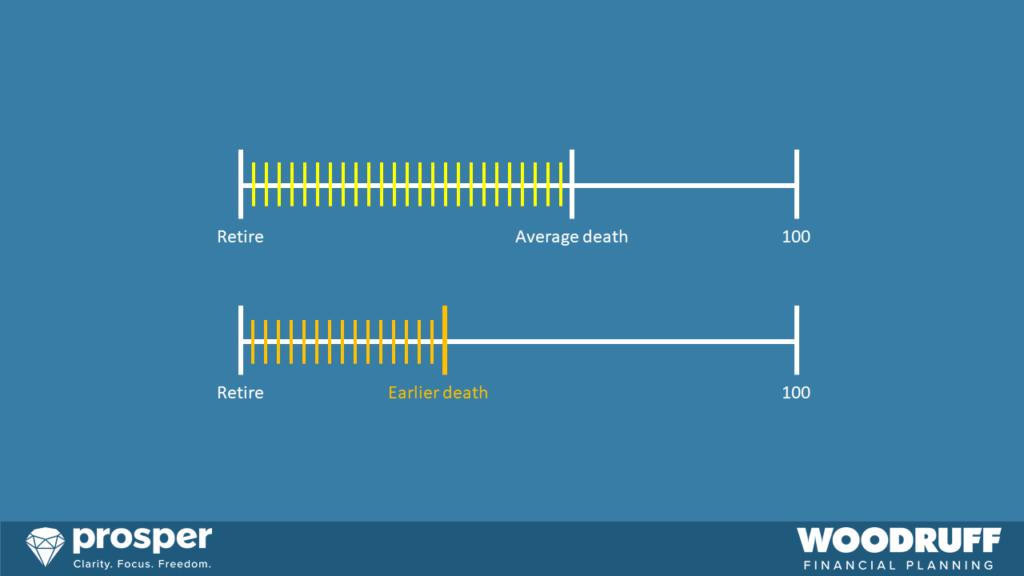
This image shows in basic form how a retirement annuity works. The top line shows a timeline of a retiring person. The pension annuity provider will asses how long they think the person will live from that point, and this will help to determine how much income they will pay out. We have shown this using the yellow lines, which illustrate in basic form how the calculation will work.
The bottom line shows someone with a perceived shorter life expectancy. This might mean that the pension annuity provider will pay a greater amount of income than someone with a longer life expectancy.
Health & lifestyle issues
If you have pre-existing medical conditions you should be able to boost your income rate if these are likely to reduce your life expectancy. Instead of applying for a traditional annuity, you can instead apply for an Impaired Life annuity (also known as an Enhanced Annuity). Lifestyle issues such as whether you smoke or your weight will also have an impact.
Typical conditions which qualify you for an impaired life annuity
An impaired life annuity is assessed on serious medical conditions likely to shorten your life expectancy. Therefore, the annuity insurers are likely to want to look into the following conditions. They consider over 1,500 different conditions.
- Smoker status
- Alcohol consumption
- Height and weight
- Cancer
- Diabetes
- Heart conditions
- High cholesterol
- High blood pressure (hypertension)
- Multiple Sclerosis
- Neurological issues
- Respiratory complaints
- Stroke
This is not a definitive list, but probably contains the bulk of the conditions covered.
It is important to remember that it is the severity of the condition which increases the impaired life annuity rate. Therefore, the shorter your life expectancy, the better the income rate.
Practical considerations of an impaired life annuity
Initially you will apply for impaired life annuity quotes alongside standard retirement annuities. You will need to give the insurance companies various details about your condition(s) such as:
- When you were diagnosed
- What treatment you have had
- The medication you are taking, including dosage
- The general effects on your lifestyle
The impaired life annuity provider will issue you with an indicative quotation. This is not guaranteed, and is confirmed once medical evidence has been assessed. Usually, the product provider will ask your doctor for a report into your health, and may ask you to undergo tests to determine the effect on your life expectancy.
Occupation & postcode
Some companies pay out greater income levels to certain occupations or areas. They consider the data to show whether you are likely to live a different lifespan to the average.
Retirement annuity options
There are many retirement annuity options open to you. These are the main ones.
Using part of your retirement fund
You do not need to convert all of your retirement fund into an annuity. Many pension providers allow you to take an annuity in stages, so that you can control the income you need at that stage.
Tax-free cash
You can choose to take up to 25% of your fund as a tax-free lump sum. Most people take this as they prefer to have flexibility with their money. This is very much a personal decision based on your circumstances. If you take the tax-free cash this will reduce your pension annuity income, so think carefully before you take this option. You cannot change it later.
Level or increasing income
You can choose a level income, which will start higher but never rise. Alternatively, you can choose an income which will start lower but rise in the future at a fixed rate or in line with inflation. The level annuity incomes are attractive since they start higher. Of course, they will gradually lose their purchasing power as inflation eats into the income over time. One way to avoid this is to select an annuity income which will increase over time. The downside of this is that it starts at a lower level.
Spouse pension
Since your retirement annuity income will be lost on your death, you may want to provide an income for your spouse when you die. This will reduce the initial income paid, but could provide a valuable benefit after your death. If your spouse dies before you, this benefit will not pay out. Therefore, a spouse pension should be a serious consideration especially if your partner is younger than you, or if their retirement income is likely to be lower than yours.
Guaranteed income
As your annuity income will be lost on your death, you could select a guaranteed period over which this is paid. Therefore you could select a period of say 5 years. If you die within this period your family will receive the income you were entitled to. This option is often selected if the retirement income needs to cover a particular item.
Return of fund
You can specify a return of the original fund (or a portion of this). If this is selected, the initial income will reduce.
Frequency of income
You can choose whether to have the income paid monthly, quarterly, yearly etc. Most people prefer a monthly income, but it may be more sensible to have a less frequent option for smaller annuities.
Advance or arrears
Whether you have the income paid up-front, or after an initial period will have an effect on the income rate paid.
How to choose a retirement annuity
We find that the best way to understand how the various options work out is to run a series of comparative quotations. Please remember that annuity rates change regularly, and are dependent on your individual circumstances. This information is provided for illustration only, so don’t make any decisions on the back of this data!
Our clients get a comparison like this:
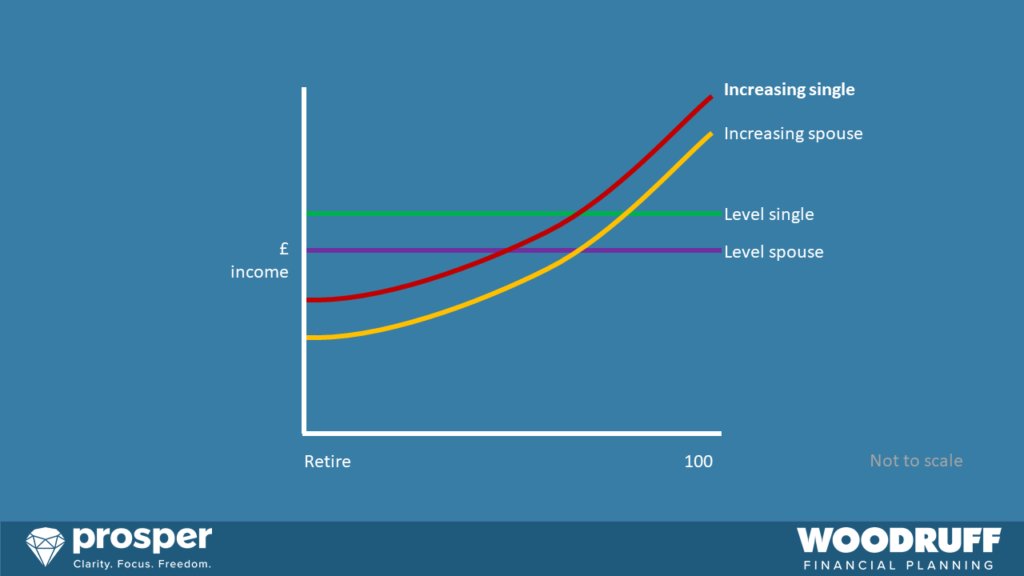
This chart shows how a retirement annuity works in practice. You can see that the level retirement annuity starts higher but never rises. After some time the increasing options overtake the level option, though they start lower.
People tend to choose a level income if they want to maximise the income in the early stages of retirement. Some people take the view that they will be more active in the early years of retirement, and so will be more likely to use the higher income at that stage. The danger of this approach is that you may still need the same level of income in later life; a level income will feel like less money due to the cost of inflation.
People tend to choose an increasing annuity income if they want to be sure of the purchasing power of their money in the future. If you can live comfortably off the reduced starting annuity income then the annual increases will help your money to feel broadly the same in later life.
If you add in valuable benefits such as a spouse pension then the retirement annuity is likely to pay out for longer. This means that the initial retirement income is certain to be lower.
Action:
- Consider whether you prefer to remove investment risk in later life – if so a retirement annuity may be appropriate for you
- Do you have any health or lifestyle issues that may help you to increase your retirement annuity income
- Consider your annuity options to match your retirement needs, and approach to inflation
Guaranteed income from a retirement annuity
Traditional retirement annuities are right for those people who want security in retirement. You get to swap your pension funds for a guaranteed income for life, on the basis you select. This is a decision which you shouldn’t take lightly since once taken it usually cannot be reversed. Once set up, the income will be paid for your life and then will cease, unless you have selected other options (see below).
This section does not examine other possible annuity options such as investment annuities, or temporary annuities.
Uses for a retirement annuity
Removing risk
You might be interested in a retirement annuity if you want to remove risk from your future. A traditional retirement annuity income is guaranteed, and so you will not have to worry about investments held within your pension plan.
Guaranteeing a basic income
Some people use a retirement annuity with part of their pension fund to cover the basic costs of living. You could separate your necessary expenditure (expenses such as food and utilities), from lifestyle costs (perhaps entertainment). One option could be to use a guaranteed retirement annuity to cover the necessary expenses. Other, variable income from pensions, or other assets might be used to cover less important expenses.
The open market option
At retirement you can shop around for your retirement annuity income. You don’t have to take your income from the company you have saved your pension funds with. Of course, your current pension provider will offer you a retirement annuity quotation. In our experience, the difference between the worst retirement annuity income rates and the best rates can be up to 30%. This can be even greater if you have a medical condition.
How a retirement annuity income is calculated
The insurance company takes your fund and offers you a rate of income based on a number of factors. Essentially, they are trying to work out your average life expectancy. They will take your fund and divide it up by the number of years they think you have left to live on average. Of course, it’s more complicated than that, but that’s the basis of it. Some people benefit from this system (as they live longer). Some people lose out (they die sooner).
Fund size
Obviously, the larger your pension funds, the larger your income will be. The income paid by the annuity will be paid proportionately so large value pensions pay more, and small value pensions pay less.
Age
The older you are, the fewer years you have left to live on average. Therefore your income rate increases. This can be shown by the image below:

This image shows in basic form how a retirement annuity works. The top line shows a timeline of a retiring person. The pension annuity provider will asses how long they think the person will live from that point, and this will help to determine how much income they will pay out. We have shown this using the yellow lines, which illustrate in basic form how the calculation will work.
The bottom line shows someone with a perceived shorter life expectancy. This might mean that the pension annuity provider will pay a greater amount of income than someone with a longer life expectancy.
Health & lifestyle issues
If you have pre-existing medical conditions you should be able to boost your income rate if these are likely to reduce your life expectancy. Instead of applying for a traditional annuity, you can instead apply for an Impaired Life annuity (also known as an Enhanced Annuity). Lifestyle issues such as whether you smoke or your weight will also have an impact.
Typical conditions which qualify you for an impaired life annuity
An impaired life annuity is assessed on serious medical conditions likely to shorten your life expectancy. Therefore, the annuity insurers are likely to want to look into the following conditions. They consider over 1,500 different conditions.
- Smoker status
- Alcohol consumption
- Height and weight
- Cancer
- Diabetes
- Heart conditions
- High cholesterol
- High blood pressure (hypertension)
- Multiple Sclerosis
- Neurological issues
- Respiratory complaints
- Stroke
This is not a definitive list, but probably contains the bulk of the conditions covered.
It is important to remember that it is the severity of the condition which increases the impaired life annuity rate. Therefore, the shorter your life expectancy, the better the income rate.
Practical considerations of an impaired life annuity
Initially you will apply for impaired life annuity quotes alongside standard retirement annuities. You will need to give the insurance companies various details about your condition(s) such as:
- When you were diagnosed
- What treatment you have had
- The medication you are taking, including dosage
- The general effects on your lifestyle
The impaired life annuity provider will issue you with an indicative quotation. This is not guaranteed, and is confirmed once medical evidence has been assessed. Usually, the product provider will ask your doctor for a report into your health, and may ask you to undergo tests to determine the effect on your life expectancy.
Occupation & postcode
Some companies pay out greater income levels to certain occupations or areas. They consider the data to show whether you are likely to live a different lifespan to the average.
Retirement annuity options
There are many retirement annuity options open to you. These are the main ones.
Using part of your retirement fund
You do not need to convert all of your retirement fund into an annuity. Many pension providers allow you to take an annuity in stages, so that you can control the income you need at that stage.
Tax-free cash
You can choose to take up to 25% of your fund as a tax-free lump sum. Most people take this as they prefer to have flexibility with their money. This is very much a personal decision based on your circumstances. If you take the tax-free cash this will reduce your pension annuity income, so think carefully before you take this option. You cannot change it later.
Level or increasing income
You can choose a level income, which will start higher but never rise. Alternatively, you can choose an income which will start lower but rise in the future at a fixed rate or in line with inflation. The level annuity incomes are attractive since they start higher. Of course, they will gradually lose their purchasing power as inflation eats into the income over time. One way to avoid this is to select an annuity income which will increase over time. The downside of this is that it starts at a lower level.
Spouse pension
Since your retirement annuity income will be lost on your death, you may want to provide an income for your spouse when you die. This will reduce the initial income paid, but could provide a valuable benefit after your death. If your spouse dies before you, this benefit will not pay out. Therefore, a spouse pension should be a serious consideration especially if your partner is younger than you, or if their retirement income is likely to be lower than yours.
Guaranteed income
As your annuity income will be lost on your death, you could select a guaranteed period over which this is paid. Therefore you could select a period of say 5 years. If you die within this period your family will receive the income you were entitled to. This option is often selected if the retirement income needs to cover a particular item.
Return of fund
You can specify a return of the original fund (or a portion of this). If this is selected, the initial income will reduce.
Frequency of income
You can choose whether to have the income paid monthly, quarterly, yearly etc. Most people prefer a monthly income, but it may be more sensible to have a less frequent option for smaller annuities.
Advance or arrears
Whether you have the income paid up-front, or after an initial period will have an effect on the income rate paid.
How to choose a retirement annuity
We find that the best way to understand how the various options work out is to run a series of comparative quotations. Please remember that annuity rates change regularly, and are dependent on your individual circumstances. This information is provided for illustration only, so don’t make any decisions on the back of this data!
Our clients get a comparison like this:

This chart shows how a retirement annuity works in practice.You can see that the level retirement annuity starts higher but never rises. After some time the increasing options overtake the level option, though they start lower.
People tend to choose a level income if they want to maximise the income in the early stages of retirement. Some people take the view that they will be more active in the early years of retirement, and so will be more likely to use the higher income at that stage. The danger of this approach is that you may still need the same level of income in later life; a level income will feel like less money due to the cost of inflation.
People tend to choose an increasing annuity income if they want to be sure of the purchasing power of their money in the future. If you can live comfortably off the reduced starting annuity income then the annual increases will help your money to feel broadly the same in later life.
If you add in valuable benefits such as a spouse pension then the retirement annuity is likely to pay out for longer. This means that the initial retirement income is certain to be lower.
Action:
- Consider whether you prefer to remove investment risk in later life – if so a retirement annuity may be appropriate for you
- Do you have any health or lifestyle issues that may help you to increase your retirement annuity income
- Consider your annuity options to match your retirement needs, and approach to inflation
Stable retirement income sources
Stable retirement income is not guaranteed to be received. It is important to understand this distinction since it can be tempting to treat this income as guaranteed. Stable income will usually continue, but there will be periods when this income ceases, or reduces, due to outside events.
Your retirement lifestyle is less secure if you rely on this form of income, although you do have more flexibility than with guaranteed sources.
Sources of stable retirement income
- Property
Property may be useful in retirement to provide you with a stable income, which will usually increase over time. Property income comes with other complications when managing the asset. You will need to deal with property maintenance, tenant queries, complicated tax arrangements, and complying with relevant legislation. Property income is not guaranteed, since market forces will dictate the amount of rent you can charge. There will be periods when you cannot find a tenant, or when that tenant cannot pay their agreed rent. Therefore, you should factor this into your expectations, and put aside a suitable cash reserve to cope with short-term issues. We often see property used for income in retirement, and sometimes this can come unstuck in a crisis, when tenants simply cannot pay. For example, during the Coronavirus pandemic many commercial tenants were not trading. They asked their landlords for temporary reductions in rent, or simply were unable to pay their rent. Temporary rules were also introduced to stop landlords evicting tenants; this led to a number of private tenants simply stopping their rent payments. This is obviously an extreme example, but it does show how rental income from property is not a guaranteed source of income in retirement. - Working
You are allowed to continue working in retirement, even if it is for a short period, or part-time. This income is likely to be stable if you are employed, and less so if you are self-employed. Of course, your income from working is not guaranteed, and could change for a number of reasons. For example, you may be unable to work due to health, or you could face redundancy. Working in retirement is a good way to top up other sources of income, especially for shorter periods.
Action:
- List all existing and possible sources of stable income in retirement
- What realistic action would you take if one of these sources of income were to reduce or cease?
Flexible retirement income sources
Flexible income in retirement can come from a variety of sources. These sources of retirement income are likely to fluctuate due to a number of factors, such as the underlying performance of the investments. In all of these examples, the capital values and income generated will fluctuate.
Flexible retirement income requires planning
This makes flexible retirement income sources more difficult to plan, especially if you only have flexible retirement income. You will need to build a strategy to cope with the fluctuating nature of your investment returns. You also need to manage the risk that the income you take could erode your funds faster than is ideal. Flexible retirement income can mean that you run out of money before you die, especially if you withdraw money too fast.
You have more flexibility
Clearly, the flexibility gives you choice of how and when to access your retirement income. This can be particularly valuable in the early years of retirement, or as you semi-retire. For example, you might continue to work for a few years on a reduced salary, in advance of when guaranteed retirement income sources start (like the state pension). You can use flexible retirement income to top up other sources, and this can change as your needs develop.
Flexible income is not secure
Flexible retirement income is not as secure as other sources. Flexible retirement income works very well in combination other, more secure forms of income, perhaps to pay for variable lifestyle costs such as holidays.
Tax efficiency of flexible retirement income
Flexible retirement income can be more tax-efficient than other sources of income, provided you do some careful planning. Many people use flexible retirement income to use available tax allowances, and this can reduce the amount you need to withdraw from your accounts.
Sources of flexible retirement income
- Defined contribution pension schemes
Defined contribution pension schemes include a variety of company pensions, and personal pensions. These pension schemes build a pot of money, which usually grows over time. This can then be used to provide a guaranteed income from an annuity, or a flexible income. You have the flexibility to decide how you take your retirement income from defined contribution schemes, and also when to receive this income. You can change your income to match your needs.- Company pension
If you have worked then you may have built up a company pension fund, which you could use to provide retirement income. - Personal pension
A personal pension is a way for you to save for your retirement income. This will provide you with a fund that can be converted into income in retirement. - Flexible pensions
You can use flexible pension rules to dip into your pension funds to provide flexible income. This can be more tax-efficient, and vary to your needs as they change.
- Company pension
- Other investments
Retirement income could come from investments such as shares, ISAs, or other investment accounts.
Action:
- Consider whether you are prepared to accept risk and fluctuation of your income in retirement
- Do you value flexibility over guarantees?
- Work out a realistic sustainable income strategy from your flexible retirement income sources
6 flexible pension options for retirement income
If you want to access your flexible pensions for capital or income you should think carefully about how to access your money. This section explores 6 ways that you can use flexible pension rules to withdraw money from your defined contribution pensions. 4 of these strategies can be used to get tax-free pension withdrawals, and 2 of these methods will mean you pay more income tax. We follow Sarah’s journey through her pension income choices, exploring some common flexible pension scenarios. We believe that this section on flexible pensions is one of the most important in our Planning your Retirement Guide.
Flexible pensions compared to a guaranteed annuity
Traditionally, you would take your tax-free lump sum, worth up to 25% of the pension fund. You would then use the remaining fund to provide a taxable guaranteed income for life, called a pension annuity. Now, you can take income using flexible pensions, so this gives many more opportunities for tax-free pension withdrawals. With some careful financial planning, you can use flexible pensions to minimise tax, and maximise your income.
Of course, the tax you pay on your pension withdrawals is only part of the story. You should consider many other aspects when taking withdrawals from your pension, which is why we recommend that you take financial advice from a retirement expert. Using flexible pensions involves careful management of your retirement funds – managing investment risk, overcoming charges, tax, and making sure your retirement income is sustainable.
Using flexible pensions for tax-free pension withdrawals
The flexible pension rules allow you to treat your personal pension more like an ISA, once you reach age 55 (age 57 from 2028). The complex pension rules still exist, but you can now withdraw as much as you want, subject to income tax, at any stage.
This is very useful if you want control and flexibility, and are prepared to take some risk over your future. Flexible pensions work well if you have some other sources of income, and you do not need guaranteed income. You can also pass on your remaining fund to your family after you die.
The downside is that flexible pensions are more complex. You take risk with your investments, and also that you might outlive your fund (run out of money). Managing flexible pension income is much more of an administrative burden than for other retirement income options.
How pension income is taxed
When you start to withdraw money from your pension, it can become taxable. You can take up to 25% of the fund as a tax-free lump sum. The remainder of the fund is potentially taxable against income. When you move from the accumulation stage of your pension to the income stage, this is known in technical terms as “crystallisation” of your benefits.
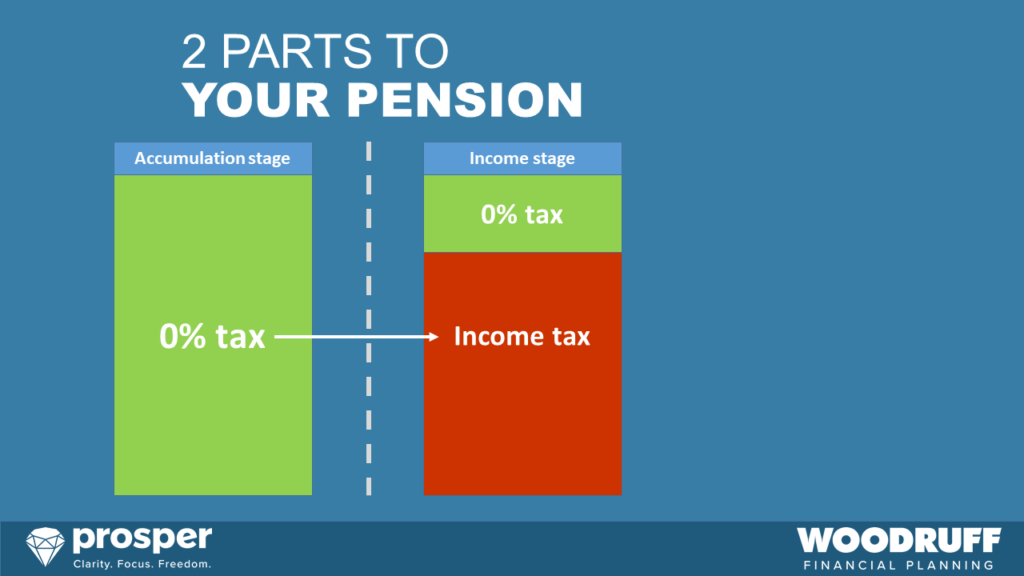
If you move all or part of your accumulation stage pension to the income stage, you cannot move back once you cross the dotted line in our image.
Flexible pensions and the Money Purchase Annual allowance
You should be careful when taking flexible pension withdrawals if you want to be able to pay into your pension plans in the future. As soon as you take a taxable flexible pension withdrawal your annual allowance for pension contributions will reduce to a maximum of £10,000 per tax year (from 6th April 2023). This is known as the Money Purchase Annual Allowance. The Money Purchase Annual Allowance was £4,000 until 5th April 2023.
If you have ceased working, and do not plan to contribute to your pension plans in the future, then this issue should not concern you. You should think carefully about taking taxable flexible pension income if you are taking benefits while still working. If you reduce your pension allowance, you may have to pay tax charges for future contributions.
If you just take the tax-free lump sum, or part of your allowance your pension plans will not be subject to the Money Purchase Annual Allowance.
6 strategies for flexible pension withdrawals
The strategies in this section are concerned with using the flexible pension rules to allow for tax-free pension withdrawals. You can now access new ways of tax-free pension withdrawals because the flexible pension rules allow you to split the fund across the accumulation stage and the income stage.
The accumulation stage refers to “uncrystallised benefits”. This stage is where most defined contribution pension schemes allow you to save and grow your money.
The income stage refers to “crystallised benefits”. This is where you convert your pension plan to take tax-free cash and taxable income. This is also known as flexible drawdown.
Note
This section is intended to show how and why you should consider different ways to take your flexible pension benefits. Of course, the income decisions from pension plans are complex, and you should consider additional issues like the lifetime allowance, drawdown emergency tax, and the sustainability of future income. We have not considered these issues for this section as it would make it more complex, and take you away from the main points.
Sarah’s pension fund
For the purpose of this section we have used a pension fund valued at £400,000 to show the strategies set out below. In each scenario, Sarah is assumed to have different needs, which highlight why she might use each of the strategies. Sarah is aged over 55, so she can access her pensions flexibly. Where tax is declared, this assumes there is no other income, and that National Insurance does not apply. In reality, there can be a variety of factors that influence these scenarios.
Option 1 – full withdrawal
When Sarah hears about flexible pensions, she thinks “Great, I just want access to my money.” This is an understandable reaction. Most people see that their pension plans are inaccessible for many years, and when they can get their hands on the fund, many want to see the money in their bank account – after all the money is theirs.
However, this ignores that the pension money is accessible at any stage from age 55. Therefore, you can think of your pension fund at more like an ISA from age 55. Just because it is accessible, does not mean you should access the money. While the pension remains invested it is free of tax. If Sarah accesses her full pension fund, not only will she pay income tax on her withdrawal, but she will also start paying tax on the remaining fund in her bank account. As a basic rule of thumb, you should only take pension withdrawals if you are planning to spend that money. Otherwise, you are taking money from a tax-free environment into a taxable account.
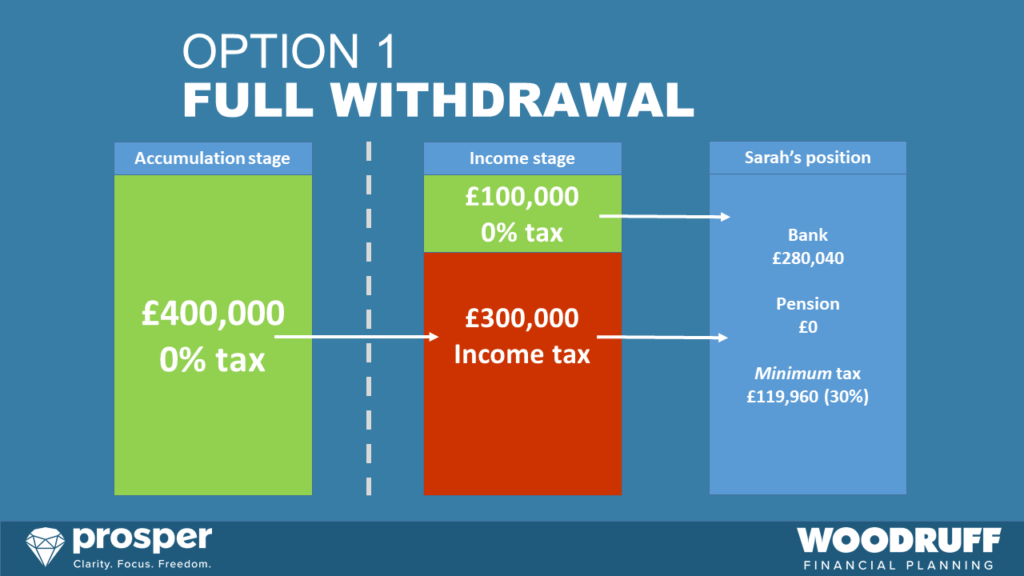
When Sarah moves from the accumulation stage to the income stage she can take 25% of her entire fund as a tax-free pension withdrawal, which is £100,000. The remaining 75% is taxable against her income. Assuming she has no other income for the tax year, she will pay £119,960 in income tax. The total of her fund paid out after income tax is £280,040. Clearly, this is not the most tax-efficient use of Sarah’s money, and would only be used in an extreme situation.
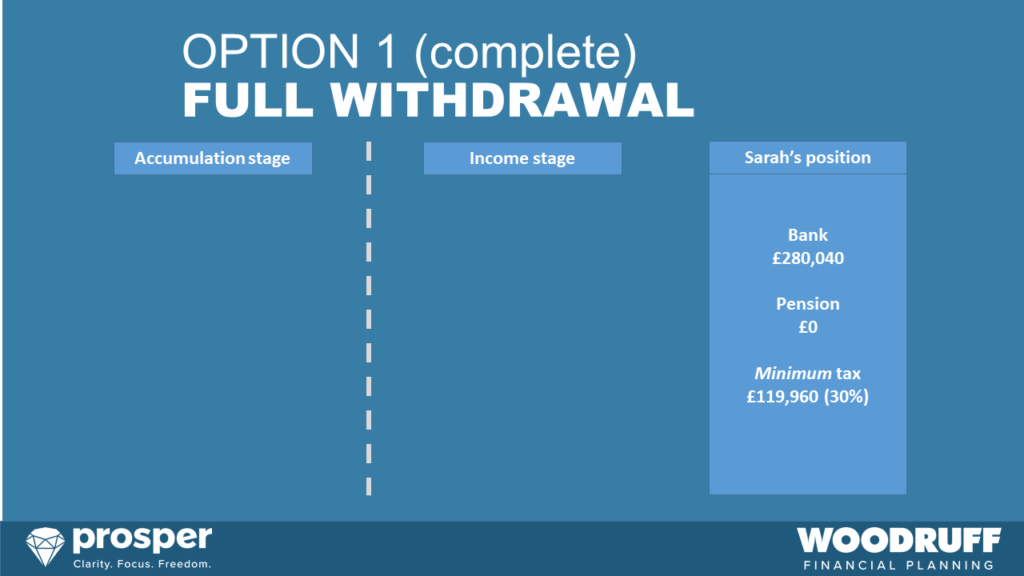
Sarah’s pension fund is completely exhausted using this option. She has paid 30% of the fund in tax, and will now attract additional tax on wherever she places the fund.
Why would Sarah choose option 1?
The only reason Sarah might choose this option is if she has a need for a large amount of capital, and has no other source of funds. This might be to repay a large debt, like an interest-only mortgage, when she is close to retirement. However, due to the large tax bill that this would incur, Sarah should avoid this option if she has any other source of funds.
Of course, if you have a smaller pension fund, then you might consider that the income tax is relatively low, and so could be a price worth paying.
Option 2 – Full tax-free lump sum
This option was always available, even before flexible pensions. Under this option, Sarah would move all of her pension fund from the accumulation stage into the income stage. Sarah can then take a tax-free pension withdrawal as 25% of the fund. The remaining fund could be left invested in the income stage, and would continue to grow tax-free. This would involve setting up a different type of pension plan called a drawdown pension.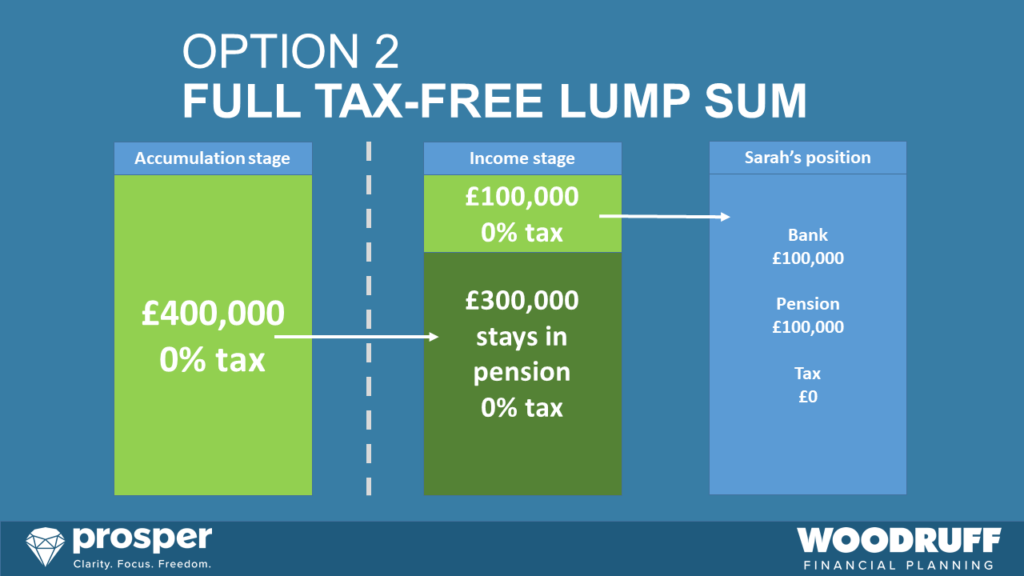
Under this option Sarah would withdraw £100,000 tax-free, and leave £300,000 invested tax-free in her pension. Any future withdrawals would be taxable.
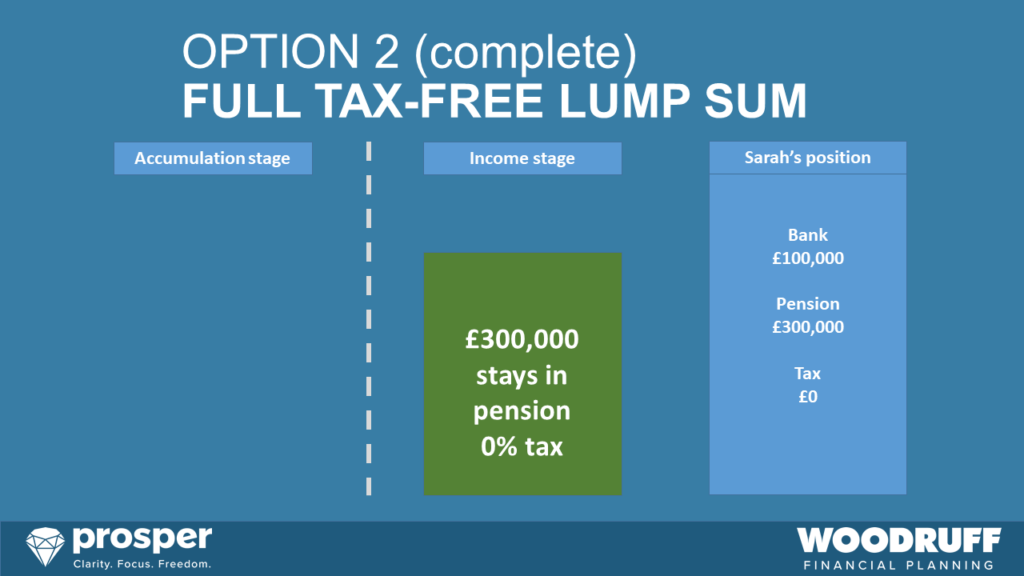
Why would Sarah choose option 2?
Sarah might choose this option if she needs access to capital to spend without paying income tax – again perhaps to pay off a debt. Sarah might also use this option if she is earning income from other sources and does not want to pay tax on her withdrawals. She should not use this option if she does not need the full tax-free lump sum. If Sarah does not spend the tax-free lump sum that is withdrawn she will start to pay tax on the withdrawal once it is placed outside of the pension plan. If Sarah does not need all this money, she would be better to leave it invested tax-free in the pension plan, and to withdraw it later, when she needs further funds.
Option 3 – partial tax-free lump sum
If Sarah needs a smaller tax-free lump sum, she can split her fund into 2 to allow her to access part of her fund. This would then preserve the remainder for future tax-free pension withdrawals. Let’s assume Sarah needs £40,000 to pay off her mortgage. She would move £160,000 from the accumulation stage to the income stage. She can then take 25% of her income stage fund as a tax-free lump sum, paying £40,000 into her bank account. 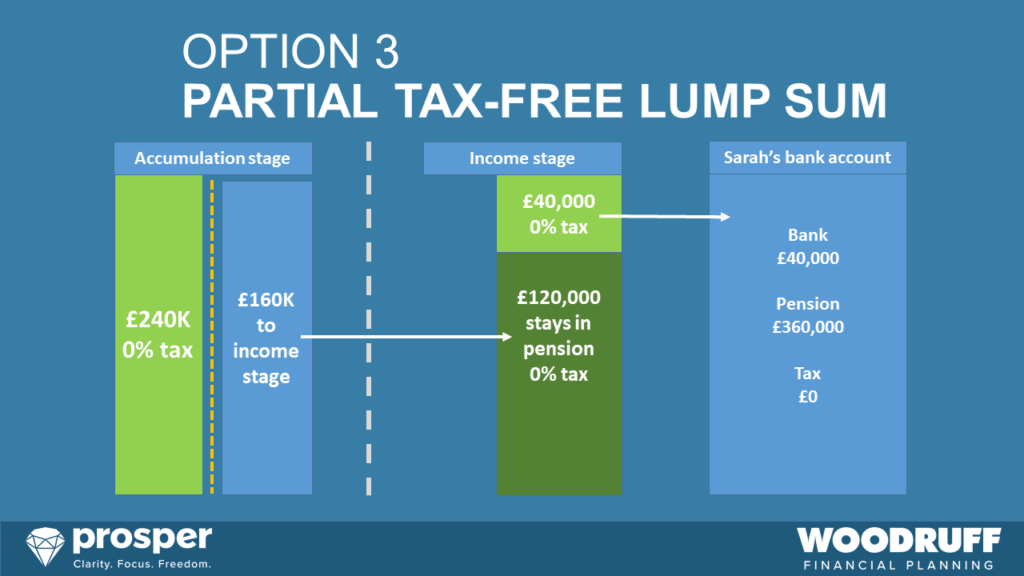
Once the transaction is complete, the remaining £360,000 is left in her pension plan to grow tax-free. £240,000 would still be in the accumulation stage (and could generate further tax-free withdrawals later); £120,000 would be in the income stage, and would be subject to income tax if withdrawals are taken from this part.
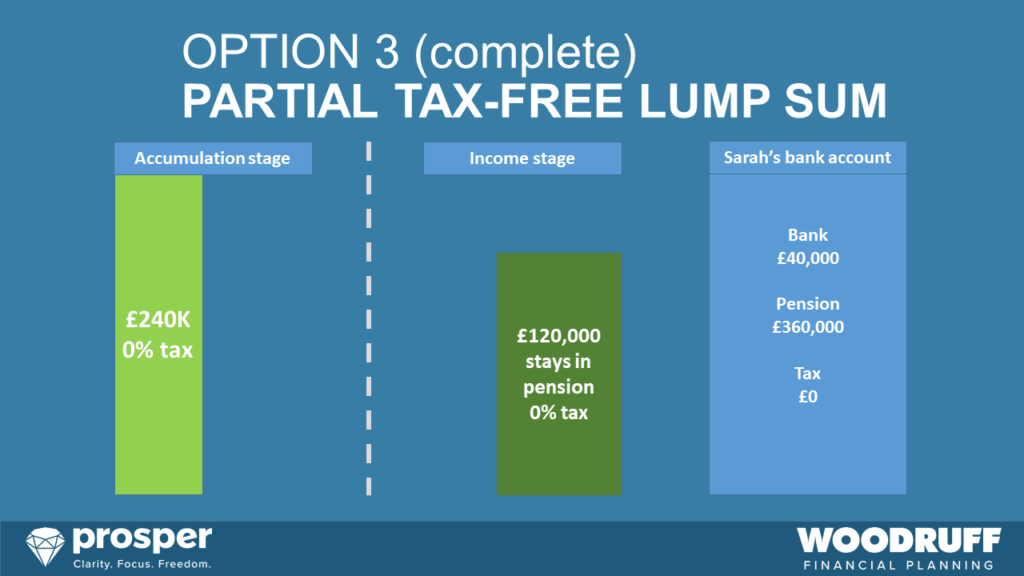
Why might Sarah choose option 3?
Sarah might choose this option if she needs access to capital to spend without paying tax on the withdrawal – perhaps to pay off a debt. She would withdraw the amount she needs to spend on paying off her debt, but leave the maximum amount remaining in her pension plan, to grow tax-free.
Option 4 – tax-free income
If Sarah does not need a lump sum, but instead requires income from her pension, she can use a combination of tax-free lump sum, and her income tax annual allowance to take up to £16,760 as a tax-free income (based on the 2021/22 tax year). This assumes she does not have other taxable income sources for the tax year. Using this option, Sarah would convert £16,760 from the accumulation stage to the income stage. £4,190 (25% of £16,760) would be paid as a tax-free lump sum. Sarah can then take £12,570 as a taxable income, However, because Sarah has not used her income tax personal allowance, she can take this withdrawal tax-free. Sarah can withdraw up to £16,760 free of income tax.
This does not work if Sarah has other taxable income, as this would use up part or all of her income tax personal allowance.

Once the transaction is complete, Sarah would have £383,240 remaining in the accumulation stage. Her pension contributions would have to reduce to £4,000 per year as she has accessed the taxable element of her pension. She has not paid any income tax (assuming no other sources of income).

Why might Sarah choose option 4?
Sarah might use option 4 if she does not need a high level of income, and wants to take a tax-free income from her pension using available allowances. Perhaps she has some savings she can also rely on for income, or is also using income from other tax-free accounts like ISAs.
In practice, it is unlikely that you would want to take retirement income in precisely this way. What is more likely is that you would generate a specific amount of income, as set out below in options 5 and 6.
Option 5 – traditional drawdown income
Let’s assume Sarah needs an income of £2,500 per month to live on after tax, and she has no other sources of income. Sarah can achieve this via a combination of tax-free cash, and taxable drawdown income.
This involves a slightly complex calculation to work out the precise withdrawal to allow Sarah to withdraw what she needs after the payment of income tax.
Sarah could convert £32,340 from the accumulation stage to the income stage. The withdrawal could be made up of 25% of this amount as a tax-free lump sum, which would be £8,085. The remaining £24,255 would be paid out, but subject to income tax. Sarah would pay income tax of £2,335, but would receive £30,005 income after tax.

Once the first year income is complete, Sarah has received £30,005, but her remaining pension has been reduced to £367,660 because of the income tax payable.
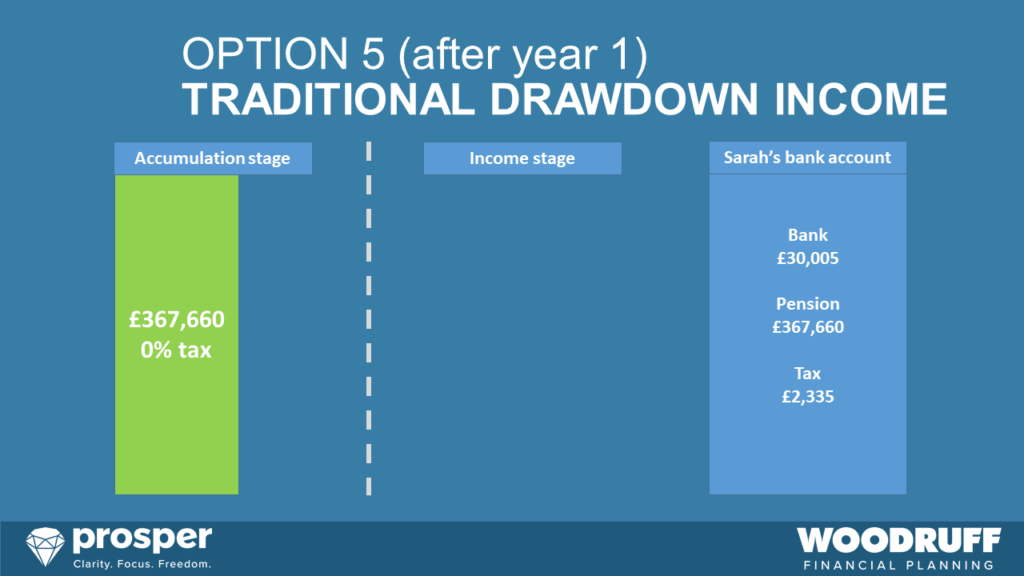
Why might Sarah choose option 5?
Sarah might use option 5 if she needs a greater level of flexible retirement income, which is geared to her planned needs for the coming year. However, option 6 below, has a more tax-efficient withdrawal method, at least in the early years of retirement. Sarah should also plan ahead as her withdrawals might deplete her funds quickly, leaving her with no income in the future.
Option 6 – tax-free flexible pension income
Flexible pension rules allow you to take tax-free pension withdrawals from different parts of your pension plan, at various stages. Therefore, if we assume that Sarah still requires £30,000 income, we can arrange this so that no income tax is paid, at least in the early years of the plan.
This could mean that Sarah leaves the maximum amount to grow tax-free in her pension plan, and may extend the lifetime of her money. To achieve a completely tax-free withdrawal of £30,000 Sarah would convert £69,720 to the income stage of her pension. This could be divided into 2, so that she takes £17,430 as a tax-free lump sum, plus £12,570 as a taxable income which is not taxed as Sarah has the income tax personal allowance available. The total withdrawal would be £30,000, and would be tax-free pension. Sarah would avoid income tax on this withdrawal, leaving £370,000 in her pension plan to grow tax-free.
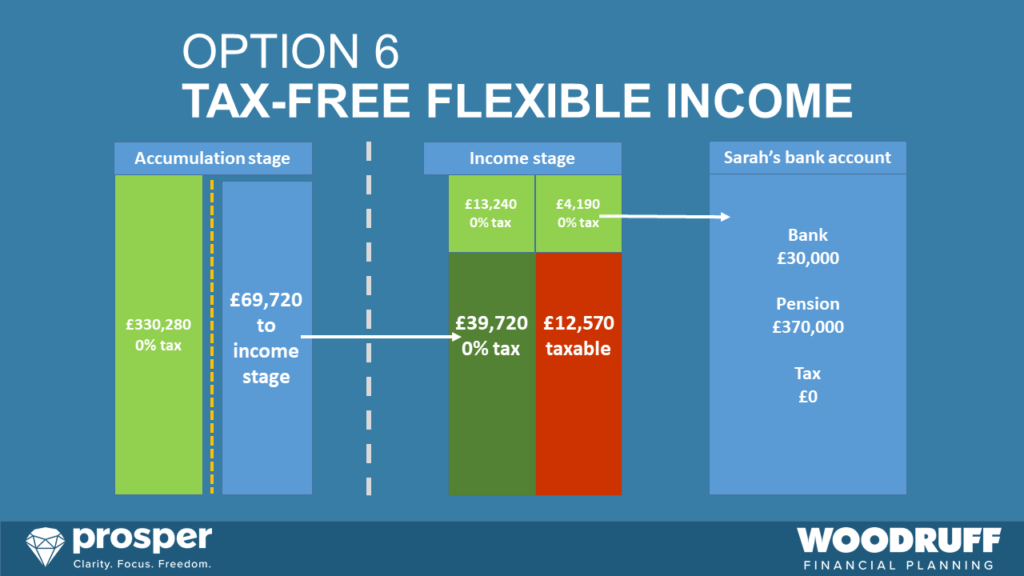
After the transaction completes, Sarah would retain £370,000 in her pension, with £330,280 in the accumulation stage, and £39,720 in the income stage. Sarah would not be able to pay in more than £4,000 per year into her pension plan. If Sarah were to take withdrawals from the £39,720 left in the income stage of her pension, then this would be taxable against income.
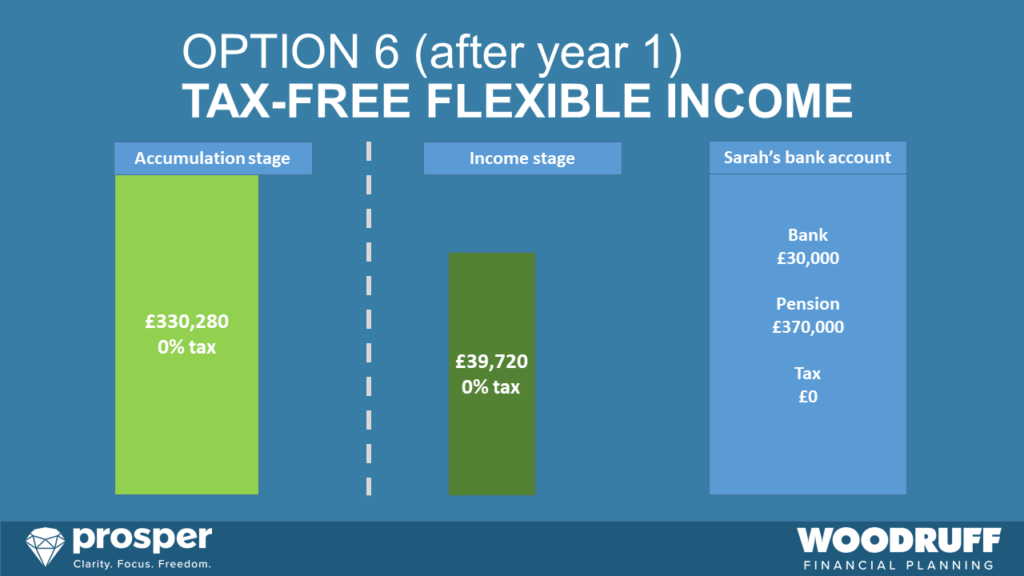
Why might Sarah choose option 6?
Sarah might opt for option 6 if she wants to minimise the income tax paid on her withdrawals, especially if she needs to bridge a gap in her income for a few years. Sarah might use this option if she retires early before other pension benefits come into payment. Option 6 delays the payment of income tax on flexible pension withdrawals. If flexible pension withdrawals continue in the future, income tax will have to be paid on the pension plan.
One other benefit of delaying the payment of income tax on your withdrawals is that it preserves the value of the pension plan. This can mean that this asset can pass free of inheritance tax if any is left on your death.
Action:
- Consider how much income you need from your flexible pension plan in the coming year
- Establish the most tax-efficient flexible pension withdrawal method
- Consider how long your flexible pension will last – our section on running out of money in retirement is useful
- Consider using a retirement income cashflow reserve to manage the effects investment volatility on your withdrawals
How retirement income sources work together
The section of our Planning your Retirement Guide shows an example of how various income sources could work together to provide you with the lifestyle you want in retirement. Of course, this could work in a number of ways, depending on your possible sources of retirement income.
Les’s retirement income plans
- Les is currently aged 60.
- He is employed, earning £50,000 per year.
- He works out that he needs £30,000 per year to pay for his lifestyle costs.
- He is not yet ready to retire fully, but would value working more on his terms.
- He agrees with his employer that he will reduce his hours by half, which will mean his employed income reduces to £25,000.
- He wants to work for 2 more years, and retire fully from age 63.
- Les’s employed income is stable income, but is not guaranteed.
Les has 2 forms of guaranteed income:
- He knows that his former employer’s Defined Benefits final salary scheme will start payments from age 65, paying around £10,000 per year.
- He also obtains a state pension forecast, which tells him that he should receive around £9,000 per year from age 66.
Les also has a defined contribution personal pension:
- He is interested to examine his options for income from his personal pension to allow him to semi-retire from age 61, and to fully retire from age 63.
Option 1 – guaranteed retirement annuity
Les can convert his defined contribution personal pension into a guaranteed income for life, using a retirement annuity. This allows him to secure his retirement income, but would mean less flexibility in the future, unless he has other sources of savings. If Les is risk-averse this might be an attractive option.
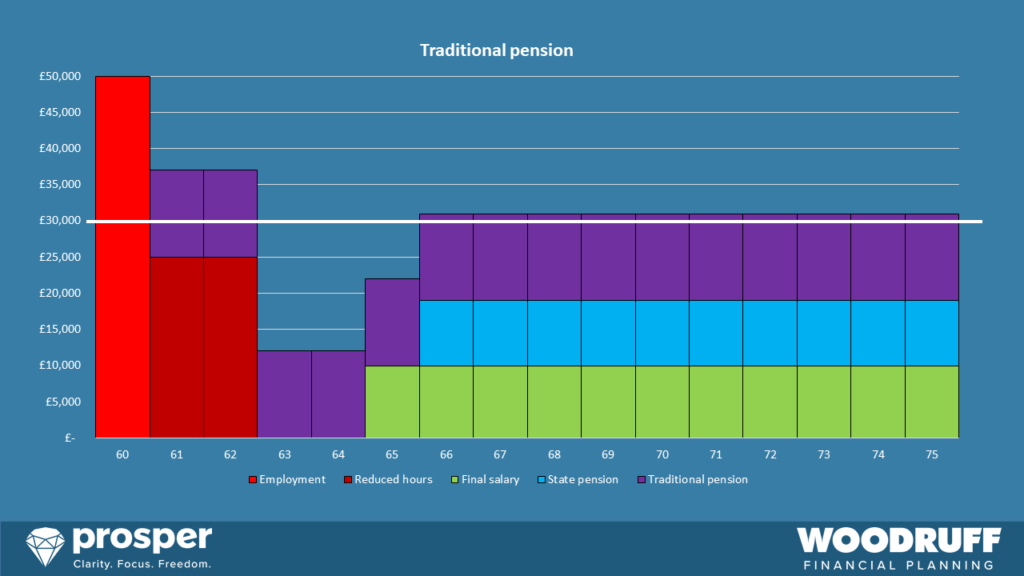
This chart shows all of Les’s retirement income options, based on his requirements.
- Bright red
This bar shows his current employed income (stable income), which is greater than he needs. - Darker red
This shows his potential reduced employment income (stable income). - Green
This shows his Defined Benefits final salary income (guaranteed income), payable from age 65. - Blue
This shows his state pension (guaranteed income), payable from age 66 - Purple
This shows the possible retirement annuity (guaranteed income), which he could take from age 61.
This chart shows that, if Les is risk averse, the guaranteed annuity option might not fully meet his needs in the early years of his retirement. He might need to revert to using other savings to top up his income between ages 63 to 65. Otherwise, he could work longer to improve his employed income.
However, from age 66 onwards, his goals are met by guaranteed income sources.
Option 2 – flexible retirement income
Les can withdraw income from his defined contribution personal pension using the flexible retirement rules. This allows him to tailor his retirement income to meet his exact needs, but would mean that he needs to manage his investments carefully to make sure he remains on track, and that his withdrawals do not exhaust his funds before he dies. If Les is prepared to accept some investment risk in exchange for income flexibility this might be an attractive option.
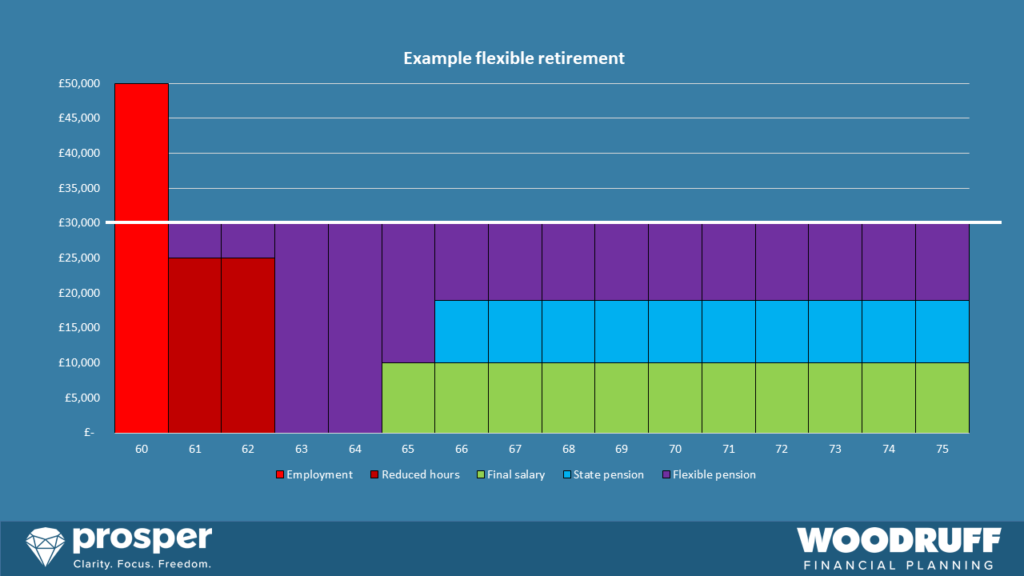
- Bright red
This bar shows his current employed income (stable income), which is greater than he needs. - Darker red
This shows his potential reduced employment income (stable income). - Green
This shows his Defined Benefits final salary income (guaranteed income), payable from age 65. - Blue
This shows his state pension (guaranteed income), payable from age 66 - Purple
This shows the possible flexible pension withdrawals (flexible income), which he could take from age 61.
This chart shows that the flexible pension route allows Les to match his income withdrawals to meet his goals as his other income sources change. This could allow him to semi-retire as he plans. However, the flexibility this option allows requires careful management, and would not be guaranteed.
Action:
- Consider whether each possible retirement income source is guaranteed, stable, or flexible
- Consider whether you prefer:
- Security of income in retirement, with less flexibility
- Flexibility of income in retirement, with associated investment risks
- Check your expected retirement income sources
- When can you take each form of retirement income?
- How much retirement income do you expect to receive?
- Will this income be guaranteed, secure, or flexible?
- Will this income increase over time?
- How will the income be taxed?

Business owners – extraction of profits
Pension schemes are one of the most tax-efficient ways for business owners to extract profits from their business. An employer pension contribution is almost always treated as a legitimate business expense, and comes out of the business’s profits before corporation tax is deducted. This allows the business to use pension contributions to save corporation tax in a Limited Company.
Who should be interested?
If you own and run a small business as a limited company, then this section is useful to you. This shows the legitimate tax savings of extracting profits from your business as an employer pension contribution.
Business owner retirement issues
If you are a business owner, you will have particular issues to deal with relating to your retirement. This section of the Planning your Retirement Guide shows the main issues you should examine when looking at planning your retirement alongside your business.
We have focussed on the issues relating to your business, because you have a special ability to extract money from your company saving vast amounts of tax.
Business owner technical and tax issues relating to pension schemes and retirement
Click on the links below to view the relevant sections within this guide. Each of these is likely to be a significant issue when planning your retirement alongside your business.
- Extraction of profits – save 51.3% tax
- Why pensions are 105% better than ISAs for business owners
- Purchase of commercial property
- The annual allowance
- Carry forward
- Maximum tax relief
- Salary sacrifice or bonus sacrifice
- The Lifetime Allowance
- Flexible pension options
- Why pensions are fantastic for avoiding inheritance tax
Financial planning for business owners
In our experience, business owners experience these major stages in their retirement planning
Maintaining access and flexibility
Many business owners value access to cash, and flexibility. You have see difficult times in your business, and you know that there may be times ahead when cashflow will be important. Many business owners dislike the fact that pension contributions cannot be accessed until age 55 at the earliest. This is understandable, but means that you are likely to have to pay much higher rates of tax if you ignore the benefits of making employer pension contributions. We believe that you should value what you can extract, and therefore keep, from your business, not just the ability to access cash.
Avoiding tax
Your business naturally leads to high income tax once it becomes successful. However, if you own a Limited Company you have the ability to reduce income tax by using a combination of salary and dividends, which are taxed at lower rates than employees.
- Companies are taxed at a minimum of 19% on profits, rising to 25%, and 26.5% on certain profits
- Your income tax rates rise as your income increases (dividends may attract tax at 33.75% or greater)
- You lose child benefit at £60,000 income
- You lose your income tax personal allowance at £100,000 income
- You are subject to the tapered annual allowance at £260,000 income
- Your pension annual allowance could be as low as £10,000
“My business is my pension”
In the accumulation stage, many business owner clients look to retain money within their business. This can lead to more risk if your business suffers a future downturn. You should be focussed on how much you can pay into pension plans to shelter your income from tax. This also allows you to diversify money into your own name, rather than just in the business. You may think that building your business for a future sale could be part of your retirement plans. This is true but is subject to the whims of the market at that stage; in short, your business is only worth what someone else is prepared to pay for it.
When it comes to retirement, business owners may have significant pension assets. You may be close to the Lifetime Allowance, which could in turn lead to further tax issues in retirement. This is less of an issue now that the Lifetime Allowance is being removed.
Flexible retirement
Business owners often value flexibility in retirement. They might look to retire gradually, and they might have other sources of retirement income. If this is the case, flexible retirement options may be attractive, as you can access your retirement benefits to meet your needs as they change. This can often be achieved with maximum tax-efficiency.
Passing money to future generations
If you accumulate more assets than you need due to your high income, you may be interested to pass money to future generations on death. Inheritance tax planning will form part of your financial planning.
How financial planning can help business owners
The issues raised in this section are complex and change according to your personal situation and goals. in many cases, the tax issues overlap with each other, so there is rarely one simple solution to meet your current and future retirement needs.
Financial planning can help you to understand where you are now, and how soon you can afford to retire flexibly, and with security. We can show you alternative scenarios to examine the effects of different courses of action to see the most tax-efficient way to plan your retirement.
Action:
- Consider how each of the issues raised in this section overlap and interact.
- Contact us to discuss your retirement needs.
Why should a business owner make an employer contribution to a pension scheme?
Extract profits from your business and save 51.3% tax
An employer pension contribution is usually an allowable business expense to be deducted from the turnover. This means that the employer pension contribution will be made before the final profits are calculated, so that the business will save corporation tax. This saves corporation tax on the employer pension contribution of at least 19%, up to 25%, or even 26.5%.
As a business owner with a Limited Company, you are likely to pay yourself via a combination of salary and dividends. This method attracts slightly less tax overall than if you were to pay yourself a salary for the same amount.
Your business will pay corporation tax on the profits for the year. The rise in corporation tax represents a tax increase on profits of up to 39% for your Limited Company. Business profits are taxed using corporation tax at these rates:
- Profits up to £50,000 – 19% corporation tax
- Profits between £50,000 and £250,000 – 26.5% corporation tax
- Profits over £250,000 – 25% corporation tax
The reason for the different corporation tax rates is that the tax is due to increase from 19% to 25% from April 2023. The 26.5% corporation tax rate is the marginal tax paid on the middle element of profits, so this represents a tax increase of over 39% for profits taxed in this band over the previous tax rate. This allows the overall tax paid to increase gradually from 19% to 25%.
Most business owners pay a small salary to allow you to benefit from the income tax personal allowance, which means the income is tax-free. This salary is an allowable expense and is deducted before corporation tax is paid. You should ensure that the salary is high enough to pay National Insurance, as this will mean that you qualify for State pension credits.
After that, you are likely to pay income as a dividend. This is paid from profits after the deduction of corporation tax. Dividends are taxed at lower rates than salary – 8.75% for dividends which fall in the 20% income tax band. You also get an additional allowance for dividends, which means the first £1,000 of income is tax-free. This is on top of the standard personal allowance of £12,570.
The position gets more expensive when your total income (salary plus dividends) exceeds £51,270. Any dividends paid to you after this amount are taxed at 33.75%. Salary would be taxed at 40%.
From April 2023 the dividend allowance for each tax year reduces to:
- £1,000 from April 2023
This is an increase in tax of up to £393.50 compared to 2022/23, depending on your income. - £500 from April 2024
This is an increase in tax of up to £590.25 compared to 2022/23, depending on your income.
You have a basic choice – you can take further dividends as an income, less tax at 33.75%. As an alternative, you may instead pay contributions to a pension scheme. This would mean you get to keep more of your company profits. The difference in tax saved is quite startling.
General summary of the most tax-efficient methods for profit extraction from a business
The example above shows the typical order of profit extraction from a limited company.
- The dark green shows the salary, which is taxed at 0% as it falls within the income tax personal allowance. National Insurance will be due on this salary, but this allows you to qualify for the State pension.
- The light green represents dividends taken as income, which uses the tax-free dividend allowance of £1,000 (reducing to £500 from 2024/25). The remaining income is taxed at 8.75%. Further dividends would be taxed at 33.75%.
- The purple shows the use of a company pension contribution. £60,000 can be extracted at this stage free of tax, and possibly more if you have carry forward available.
- The red shows a further possible tax-efficient income, using 30% tax relief offered by a Venture Capital Trust.
Advantages of an employer pension contribution for a business owner
- You get to extract profits into your own pension plan
- From April 2023 the corporation tax rates have increased. However, the Annual Allowance also increased to £60,000. Employer contributions usually avoid corporation tax at:
- 19% on profits under £50,000
- 26.5% on profits over £50,000 but under £250,000
- 25% on profits over £250,000
- From 6th April 2023 a £60,000 employer pension contribution would save corporation tax of between £11,400 and £15,900
- Employer contributions also avoid dividend tax at a likely rate of 33.75%. On a company contribution of £60,000 this would save the business owner between £14,883.75 and £15,187.50
- From 6th April 2023 an employer pension contribution of £60,000 will produce a different tax saving depending on the level of profits of the business. The total tax saving would range between £30,187.50 (50.3%) to £30,783.75 (51.3%)
- The employer pension contribution will grow in a tax-free pension plan.
Disadvantages of an employer pension contribution for a business owner
- You may not have access to this pension scheme until at least age 55 (possibly age 57 from 2028)
- Future income from the pension scheme may be taxable as income
- Pension schemes are less flexible and accessible than other investment types, or income.
Action:
- Establish whether your business has enough excess profits to allow you to make an employer pension contribution
- Discuss the appropriate timing with your accountant.
- Consider whether High Income issues affect you too.
Tax on dividends vs company pension contribution
Here is a summary of the benefits of the employer pension contribution for a business owner, based on different tax years, and profit levels.
Profits greater than £110,000 but less than £250,000 from April 2023
Imagine that Phil runs his own small business, but that profits are now greater than £110,000 but less than £250,000. Profits greater than £50,000 attract a corporation tax rate of 26.5% from April 2023. He has an excess of profits over the normal expenses and income he needs to take from the company. Phil wants to examine how to best extract this profit from his company, either as a dividend or as an employer pension contribution. This example assumes that the basic rate income tax band has been completely used up, and also ignores all the other aspects of preparing Phil’s annual business accounts.
£60,000 profit paid as a dividend
This comparison shows the tax cost on the left of a company profit of £40,000, paid as dividend.
- This £60,000 profit is taxed as corporation tax at 26.5%. Phil’s company would pay £15,900 in corporation tax, leaving him with £34,100 to be paid as a dividend.
- If Phil pays the dividend of £34,100, he will pay income tax on this personally. If we assume that he has already extracted salary and other dividends up to the higher rate tax threshold, Phil is likely to pay income tax on the dividend at 33.75%. The tax on the dividend of £34,100 is £14,883.75.
- Total tax paid is £30,783.75 (51.3%)
- Phil gets to keep £29,216.25 after payment of corporation tax and income tax.
£60,000 profit paid as an employer pension contribution
If £60,000 were to be paid as an employer pension contribution, then no tax is payable. Phil speaks to his accountant, who confirms that there are enough profits to pay this contribution to his pension plan, and that he is allowed to treat this as a legitimate business expense. The company pension contribution is added to the expenses of the business and reduces the profits by the amount paid to the pension. This removes the corporation tax on the employer pension contribution, which is paid tax-free into Phil’s pension.
This saves £30,783.75 in tax compared to the dividend example.
Action:
- If you want to extract profits from your business, which are not needed to spend, you should consider taking this as an employer pension contribution.
Employer pension contributions vs Investment ISAs
Why pensions are up to 105% better than ISAs for company owners (at least 36%)
Phil wants to compare the benefit of extracting profits from his business over time. The example below shows the amount of profit that the company would need to make after the basic rate income tax band has been used, to extract £20,000 into an investment ISA each year. We have then compared the same figure before tax, and instead assumed this is paid as an employer pension contrition. In both cases we assume a 6% annual growth after charges. Of course, this would never be guaranteed. The data below uses tax rates applicable from 1st April 2023, as corporation tax increases from that date.
The table shows that the profit required to release a post-tax dividend to be able to fund a full ISA contribution is £41,073 (this figure increased from £37,270 in 2022/23 – a tax increase of £3,803).
- For £20,000 to be paid as a dividend after tax, £21,073 is lost to tax (£10,884 as corporation tax on the profits, and £10,189 as income tax on the dividend)
- If this is instead paid as an employer pension contribution the whole amount will go into the pension scheme and no tax is paid
If this is repeated for 20 years, the end result would be £779,854 for the ISA, with £1,601,549 for the pension scheme. Incredibly, the result is 105% better for the pension scheme, and this is purely down to avoiding corporation tax and income tax on the dividends. In this example, Phil is better off by £821,695.
It is important to note that the corporation tax rates from April 2023 have increased, depending on profits. The rate we used for our calculations is 26.5% as this is the middle band of profits on £50,000 to £250,000. The actual contribution used to fund the pension in the above image and chart is £41,073, which is the gross figure before tax used to generate the £20,000 ISA contribution. This is actually slightly greater than the maximum standard pension contribution of £40,000. We have assumed that you would be able to use carry forward for the purposes of this example, and that pension allowances increase in the future. In practice, the actual contributions may be limited by other factors.
But pension income is taxable – ISAs are not
This is a valid issue. The benefits of ISAs are kind of opposite to pensions. Contribution to ISAs are paid after taxes on extraction from the business; pension income is taxable as an income.
In the worst tax situation (which is extremely unlikely) that Phil takes the entire pension fund as a lump sum after 20 years, he would get 25% of the fund tax-free* and the remaining 75% would be taxed as income at 45%.
If we assume that Phil withdraws the entire pension fund of £1,601,549
- £400,387 is tax-free
- £1,201,117 is taxed at up to 45% (maximum £540,502 in tax)
- Phil receives £1,061,002 after tax
Even in this extreme scenario, Phil would receive £281,148 more than if he had used an ISA. This is an additional return after tax of 36.1%.
In practice, we would use Phil’s available income tax allowances to take pension withdrawals gradually so that he minimises income tax. The benefit of using pensions is likely to be much greater than 36.1%.
Buy commercial property using a SIPP
Business owners are often keen to buy their commercial property. Usually, this would be achieved using a commercial loan, along with a cash deposit from business reserves. Business owners can also use the pensions of the shareholders or partners to buy commercial property. This can be done with a Self-invested Personal Pension (SIPP) or a Small Self-administered Scheme (SSAS). SIPPs tend to be the method of choice for most business owners, due to greater flexibility and less administration.
Standard commercial property purchase
In a standard commercial property purchase, the business buys the asset. Therefore, the business needs to have enough cash to buy the commercial property, or alternatively the ability to borrow on commercial rates to finance the purchase.
Commercial property purchase lending is usually more expensive than residential lending. This reflects the increased risk to the lender. Usually a business would need to have a deposit of at least 30% of the commercial property purchase, with the rest coming via a commercial loan secured on the property. Interest rates are typically higher than with residential loans, and the term tends to be shorter (5 to 10 years).
For many businesses the deposit could be the major issue. It can be difficult to set aside the cash, or this might hold back spending in other areas, which could be vital for the growth of the business.
Buying commercial property using a SIPP could be an attractive option to use available assets outside the company. However, this comes with additional complications and risks to the business owners.
What is a Self-invested Personal Pension (SIPP)?
A SIPP is a defined contributions scheme – essentially a more complex version of a standard personal pension. This pension plan allows investments in non-standard assets, and commercial property should be a permitted purchase for a SIPP.
SIPPs are more complex schemes, and can come with extra charges when compared to more standard pension plans. Therefore, you should really only choose a SIPP if you need the extra features of the scheme. For most people a SIPP is unnecessary – you can achieve your goals with a personal pension. For business owners who want to buy commercial property, a SIPP is a reasonable solution.
All the benefits of a personal pension are available to a SIPP:
- Tax relief on contributions
- Tax-free growth
- Tax-free cash
- Flexible income
- Inheritance tax free
How can a business owner buy commercial property using a SIPP?
The image below shows how a business owner can buy commercial property using a SIPP.
In this image, you can follow the outline steps that a business owner uses to fund a SIPP commercial property purchase, without finance.
In this example, the blue rectangle represents the SIPP, which is owned by the business owner. The company, or business owner as an individual, can pay pension contributions into the SIPP (here represented by the green arrow).
- Company contributions save corporation tax at up to 26.5%
- Personal contributions get tax relief depending on the individual’s tax position
- Assets in the SIPP grow tax-free
In this example, if the SIPP holds enough in investments to buy the commercial property then the pension scheme can purchase the property outright (the purple arrow coming from the orange investments). The SIPP scheme now owns the commercial property, and ultimately this is controlled by the scheme member.
The business would now have to pay rent to use the commercial property, which is tax deductible against profits as an expense.
Advantages for the business to hold commercial property in a SIPP
- The business does not have to borrow or find commercial finance
- The business does not have to repay the loan, so their balance sheet is not affected
- The rent paid to the SIPP is an allowable expense, which would reduce tax
Advantages for the business owner to hold commercial property in a SIPP
- The business owner controls the SIPP, so they get the benefit of any future growth in value of the commercial property
- The rent paid to the SIPP grows free of tax, so can be invested for further capital growth
Disadvantages for the business to hold commercial property in a SIPP
- The SIPP owns the commercial property so the business does not have full control over the asset
- Any future development of the commercial property is controlled by SIPP rules and must be approved by the scheme
- The business must pay a commercial rent to the SIPP to use the property
- The commercial property does not appear on the business balance sheet
Disadvantages for the business owner to hold commercial property in a SIPP
- The SIPP comes with extra administration, costs, fees, and risks
- Stamp Duty Land Tax is still paid by the SIPP (ultimately the business owner)
- The SIPP would be responsible for any finance costs, insurance and VAT even if the business does not pay the scheme
- The business owner may be limited by the annual allowance to build enough assets in the SIPP to buy the commercial property, although carry forward could be available
How can a business owner buy commercial property using a SIPP with finance?
The image below shows how a business owner can buy commercial property using a SIPP alongside commercial finance.
In this image, you can follow the outline steps that a business owner uses to fund a SIPP commercial property purchase, using commercial finance.
In this example, the blue rectangle represents the SIPP, which is owned by the business owner. The company, or business owner as an individual, can pay pension contributions into the SIPP (here represented by the green arrow).
- Company contributions save corporation tax at up to 26.5%
- Personal contributions get tax relief depending on the individual’s tax position
- Assets in the SIPP grow tax-free
In this example, as the SIPP does not hold enough in investments to buy the commercial property outright. Therefore the pension scheme can purchase the property using a combination of SIPP assets and a commercial loan (shown by the orange arrows).
How much can a SIPP borrow to purchase commercial property?
A SIPP can legally borrow up to 50% of the net asset value of the pension assets. Therefore, if a SIPP is valued at £200,000 then it could borrow up to £100,000. This example would leave a total amount available for commercial property purchase of £300,000.
In our example, the SIPP member secures a loan from a bank, which is paid to the scheme (the right-hand orange arrow). The SIPP now can buy the commercial property. The SIPP scheme now owns the commercial property, and ultimately this is controlled by the scheme member.
The business would now have to pay rent to use the commercial property, which is tax deductible against profits as an expense.
The SIPP would then be responsible for paying finance costs, plus other expenses such as legal fees, VAT and insurance.
Can business owners combine SIPPs to purchase commercial property?
Yes, this is permitted, provided the SIPP scheme rules allow this practice. Essentially, 2 or more business owners could combine resources to buy a commercial property, with each SIPP owning a proportion of the asset.
Action:
- Check out our Prosper service for business owners – we can help you to use your pension scheme to purchase a commercial property
- If you want to extract profits from your business, which are not needed to spend, you should consider taking this as an employer pension contribution.
- Consider pensions to purchase commercial property

High Income retirement issues
If you have high income, you will have particular issues to deal with relating to your retirement. This section of the Planning your Retirement Guide shows the main issues you should examine when looking at planning your retirement with a high income.
We have focussed on the issues relating to your high income, because of the tax penalties that you will face.
High income technical and tax issues relating to pension schemes and retirement
Click on the links below to view the relevant sections within this guide. Each of these is likely to be a significant issue when planning your retirement with a high income.
- The annual allowance
- Carry forward – improvements
- Maximum tax relief
- Salary sacrifice or bonus sacrifice
- The Lifetime Allowance
- Flexible pension options
- Becoming non-resident
- Why pensions are fantastic for avoiding inheritance tax
Financial planning for high income
In our experience, high earners experience these major stages in their retirement planning
Avoiding tax
Your high income naturally leads to high income tax.
- You get taxed at the highest income tax rates, probably 45% once your income exceeds £125,140
- You lose child benefit at £60,000 income
- You lose your income tax personal allowance at £100,000 income
- You are subject to the tapered annual allowance at £260,000 income
- Your pension annual allowance could be as low as £10,0004
In the accumulation stage, many high income clients look to keep as much of their income as possible. You should be focussed on how much you can pay into pension plans to shelter your income from tax.
When it comes to retirement, high earners may have significant pension assets. You may be close to the Lifetime Allowance, which could in turn lead to further tax issues in retirement.
Flexible retirement
Those with high income often value flexibility in retirement. They might look to retire gradually, and they might have other sources of retirement income. If this is the case, flexible retirement options may be attractive, as you can access your retirement benefits to meet your needs as they change. This can often be achieved with maximum tax-efficiency.
Passing money to future generations
If you accumulate more assets than you need due to your high income, you may be interested to pass money to future generations on death. Inheritance tax planning will form part of your financial planning.
How financial planning can help with your high income
The issues raised in this section are complex and change according to your personal situation and goals. in many cases, the tax issues overlap with each other, so there is rarely one simple solution to meet your current and future retirement needs.
Financial planning can help you to understand where you are now, and how soon you can afford to retire flexibly, and with security. We can show you alternative scenarios to examine the effects of different courses of action to see the most tax-efficient way to plan your retirement.
Action:
- Consider how each of the issues raised in this section overlap and interact.
- Contact us to discuss your retirement needs.

Planning your Retirement Guide – get yours now
If you want to download our free guide to planning your retirement, just fill out the form below. The guide is full of actionable tips to help you to plan your retirement. You can get started right away.
If you have any questions on planning your retirement, just contact us.
Get your free mini guide on
How to Prosper in Retirement
This FREE Mini Guide is perfect for you if you are thinking about stopping or reducing work, but are unsure of what effect this would have on your income and lifestyle.

Want your free mini guide?
Fill out the form below
Got a Question? Call 01206 919101
APPROACHING RETIREMENT?
Find out how we can help you to Prosper during retirement.

About Dan Woodruff
Certified Financial Planner & Chartered Wealth Manager at Woodruff Financial Planning
Financial Planning helps you to navigate and anticipate significant life changes. I want to help you to ensure your money is managed wisely to give you the financial security that will fund the future and lifestyle that is important to you.
